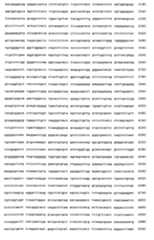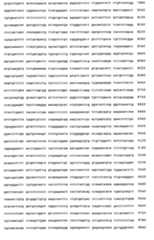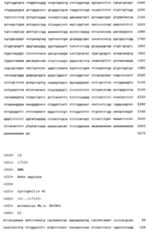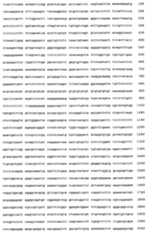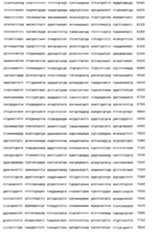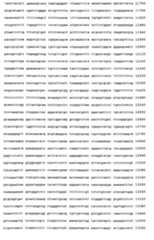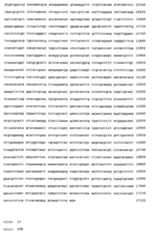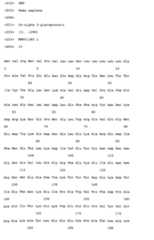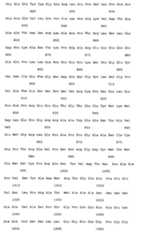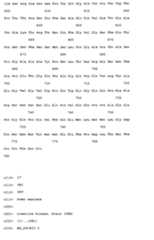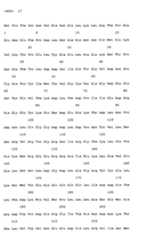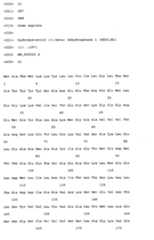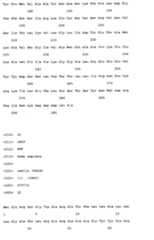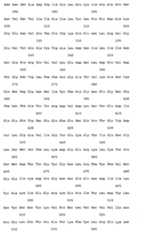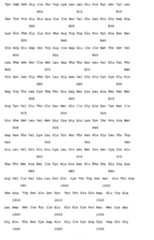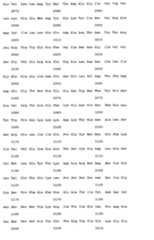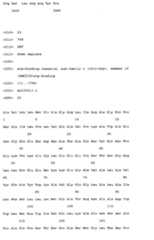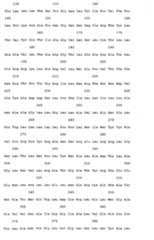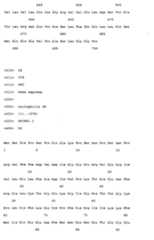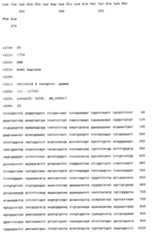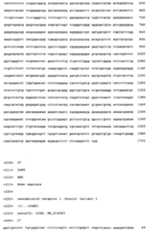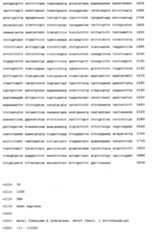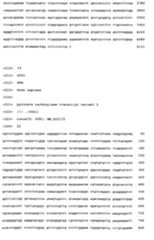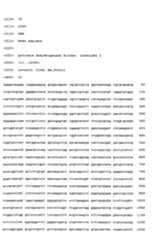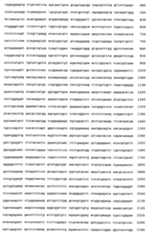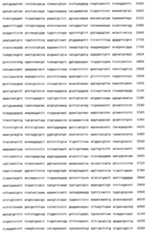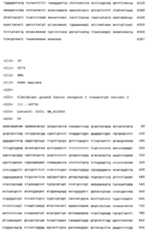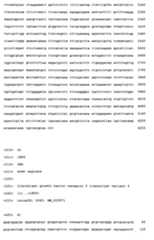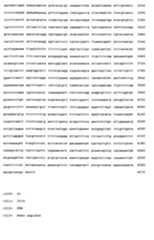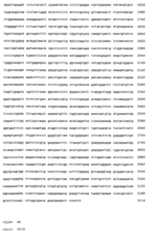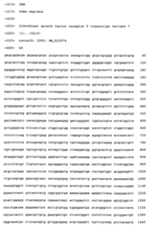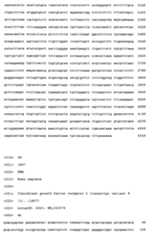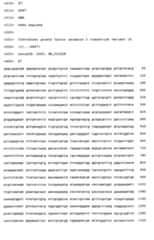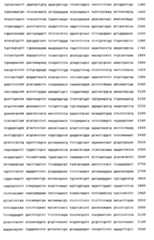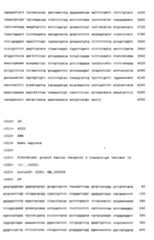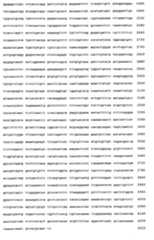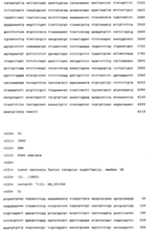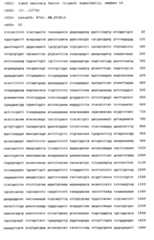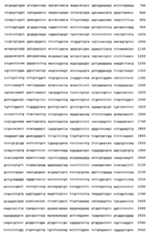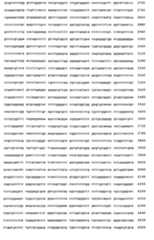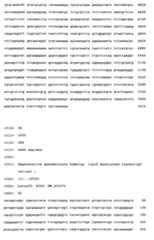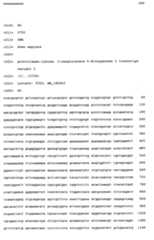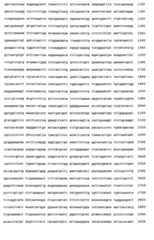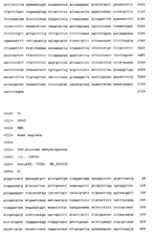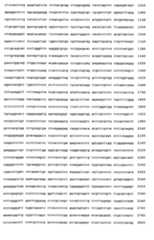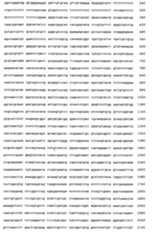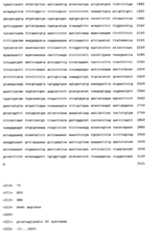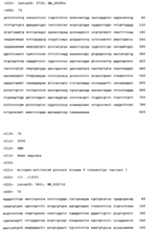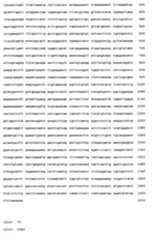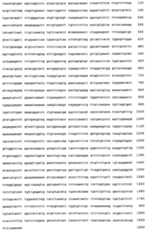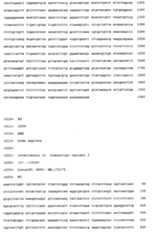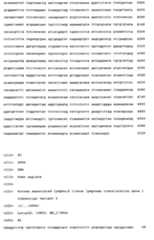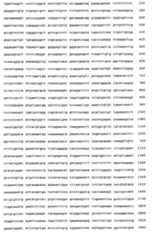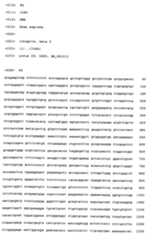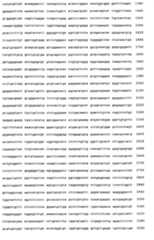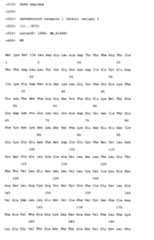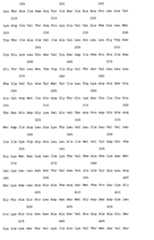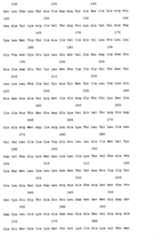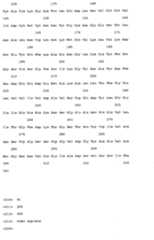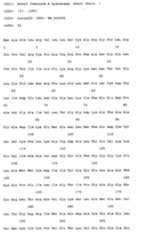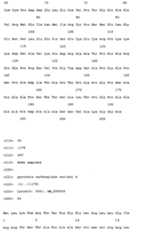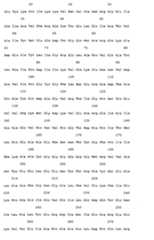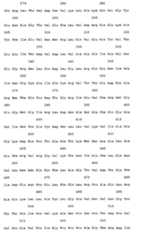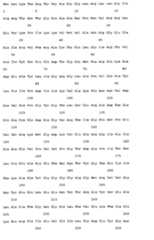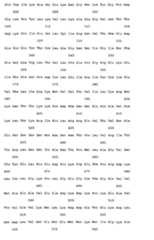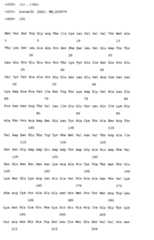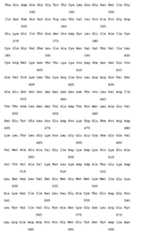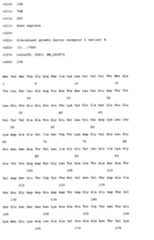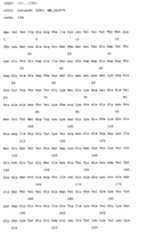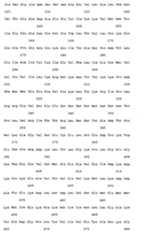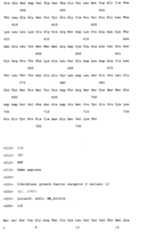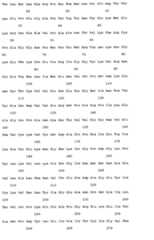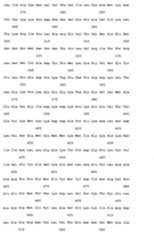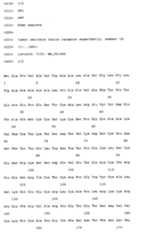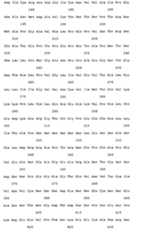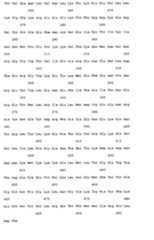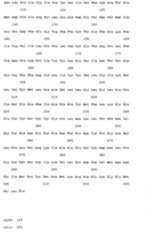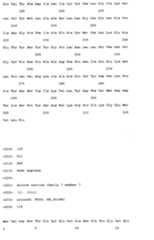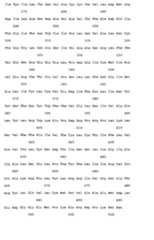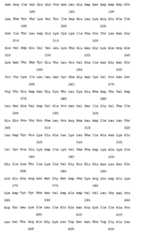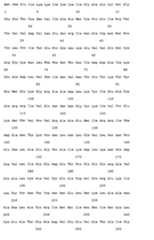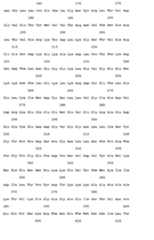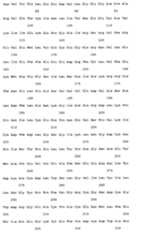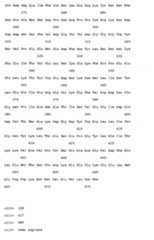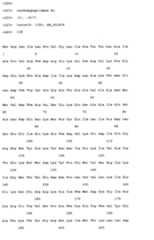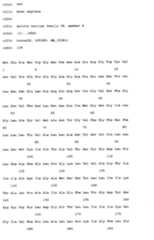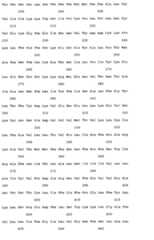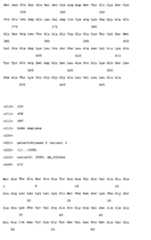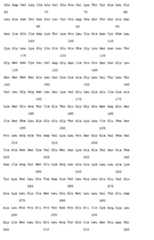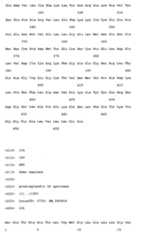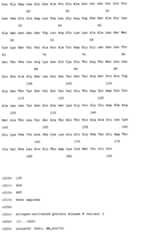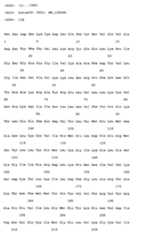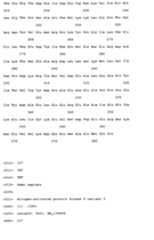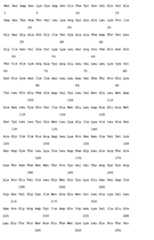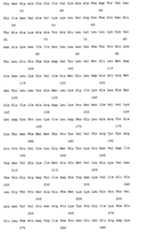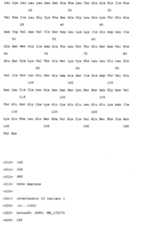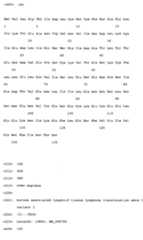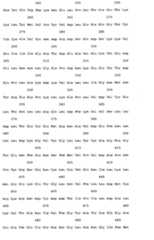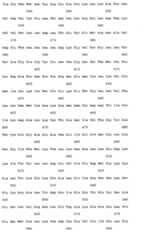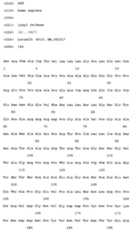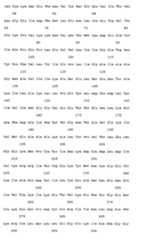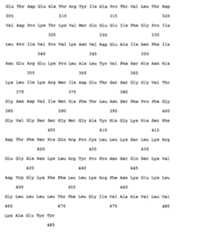EP1548445A2 - Novel targets for obesity from fat tissue - Google Patents
Novel targets for obesity from fat tissueDownload PDFInfo
- Publication number
- EP1548445A2 EP1548445A2EP04029641AEP04029641AEP1548445A2EP 1548445 A2EP1548445 A2EP 1548445A2EP 04029641 AEP04029641 AEP 04029641AEP 04029641 AEP04029641 AEP 04029641AEP 1548445 A2EP1548445 A2EP 1548445A2
- Authority
- EP
- European Patent Office
- Prior art keywords
- polypeptide
- seq
- compound
- gene
- group
- Prior art date
- Legal status (The legal status is an assumption and is not a legal conclusion. Google has not performed a legal analysis and makes no representation as to the accuracy of the status listed.)
- Withdrawn
Links
Classifications
- G—PHYSICS
- G01—MEASURING; TESTING
- G01N—INVESTIGATING OR ANALYSING MATERIALS BY DETERMINING THEIR CHEMICAL OR PHYSICAL PROPERTIES
- G01N33/00—Investigating or analysing materials by specific methods not covered by groups G01N1/00 - G01N31/00
- G01N33/48—Biological material, e.g. blood, urine; Haemocytometers
- G01N33/50—Chemical analysis of biological material, e.g. blood, urine; Testing involving biospecific ligand binding methods; Immunological testing
- G01N33/5005—Chemical analysis of biological material, e.g. blood, urine; Testing involving biospecific ligand binding methods; Immunological testing involving human or animal cells
- G01N33/5008—Chemical analysis of biological material, e.g. blood, urine; Testing involving biospecific ligand binding methods; Immunological testing involving human or animal cells for testing or evaluating the effect of chemical or biological compounds, e.g. drugs, cosmetics
- G01N33/502—Chemical analysis of biological material, e.g. blood, urine; Testing involving biospecific ligand binding methods; Immunological testing involving human or animal cells for testing or evaluating the effect of chemical or biological compounds, e.g. drugs, cosmetics for testing non-proliferative effects
- C—CHEMISTRY; METALLURGY
- C12—BIOCHEMISTRY; BEER; SPIRITS; WINE; VINEGAR; MICROBIOLOGY; ENZYMOLOGY; MUTATION OR GENETIC ENGINEERING
- C12Q—MEASURING OR TESTING PROCESSES INVOLVING ENZYMES, NUCLEIC ACIDS OR MICROORGANISMS; COMPOSITIONS OR TEST PAPERS THEREFOR; PROCESSES OF PREPARING SUCH COMPOSITIONS; CONDITION-RESPONSIVE CONTROL IN MICROBIOLOGICAL OR ENZYMOLOGICAL PROCESSES
- C12Q1/00—Measuring or testing processes involving enzymes, nucleic acids or microorganisms; Compositions therefor; Processes of preparing such compositions
- C12Q1/68—Measuring or testing processes involving enzymes, nucleic acids or microorganisms; Compositions therefor; Processes of preparing such compositions involving nucleic acids
- C12Q1/6876—Nucleic acid products used in the analysis of nucleic acids, e.g. primers or probes
- C12Q1/6883—Nucleic acid products used in the analysis of nucleic acids, e.g. primers or probes for diseases caused by alterations of genetic material
- G—PHYSICS
- G01—MEASURING; TESTING
- G01N—INVESTIGATING OR ANALYSING MATERIALS BY DETERMINING THEIR CHEMICAL OR PHYSICAL PROPERTIES
- G01N33/00—Investigating or analysing materials by specific methods not covered by groups G01N1/00 - G01N31/00
- G01N33/48—Biological material, e.g. blood, urine; Haemocytometers
- G01N33/50—Chemical analysis of biological material, e.g. blood, urine; Testing involving biospecific ligand binding methods; Immunological testing
- G01N33/5005—Chemical analysis of biological material, e.g. blood, urine; Testing involving biospecific ligand binding methods; Immunological testing involving human or animal cells
- G01N33/5008—Chemical analysis of biological material, e.g. blood, urine; Testing involving biospecific ligand binding methods; Immunological testing involving human or animal cells for testing or evaluating the effect of chemical or biological compounds, e.g. drugs, cosmetics
- G—PHYSICS
- G01—MEASURING; TESTING
- G01N—INVESTIGATING OR ANALYSING MATERIALS BY DETERMINING THEIR CHEMICAL OR PHYSICAL PROPERTIES
- G01N33/00—Investigating or analysing materials by specific methods not covered by groups G01N1/00 - G01N31/00
- G01N33/48—Biological material, e.g. blood, urine; Haemocytometers
- G01N33/50—Chemical analysis of biological material, e.g. blood, urine; Testing involving biospecific ligand binding methods; Immunological testing
- G01N33/5005—Chemical analysis of biological material, e.g. blood, urine; Testing involving biospecific ligand binding methods; Immunological testing involving human or animal cells
- G01N33/5008—Chemical analysis of biological material, e.g. blood, urine; Testing involving biospecific ligand binding methods; Immunological testing involving human or animal cells for testing or evaluating the effect of chemical or biological compounds, e.g. drugs, cosmetics
- G01N33/502—Chemical analysis of biological material, e.g. blood, urine; Testing involving biospecific ligand binding methods; Immunological testing involving human or animal cells for testing or evaluating the effect of chemical or biological compounds, e.g. drugs, cosmetics for testing non-proliferative effects
- G01N33/5023—Chemical analysis of biological material, e.g. blood, urine; Testing involving biospecific ligand binding methods; Immunological testing involving human or animal cells for testing or evaluating the effect of chemical or biological compounds, e.g. drugs, cosmetics for testing non-proliferative effects on expression patterns
- G—PHYSICS
- G01—MEASURING; TESTING
- G01N—INVESTIGATING OR ANALYSING MATERIALS BY DETERMINING THEIR CHEMICAL OR PHYSICAL PROPERTIES
- G01N33/00—Investigating or analysing materials by specific methods not covered by groups G01N1/00 - G01N31/00
- G01N33/48—Biological material, e.g. blood, urine; Haemocytometers
- G01N33/50—Chemical analysis of biological material, e.g. blood, urine; Testing involving biospecific ligand binding methods; Immunological testing
- G01N33/68—Chemical analysis of biological material, e.g. blood, urine; Testing involving biospecific ligand binding methods; Immunological testing involving proteins, peptides or amino acids
- C—CHEMISTRY; METALLURGY
- C12—BIOCHEMISTRY; BEER; SPIRITS; WINE; VINEGAR; MICROBIOLOGY; ENZYMOLOGY; MUTATION OR GENETIC ENGINEERING
- C12Q—MEASURING OR TESTING PROCESSES INVOLVING ENZYMES, NUCLEIC ACIDS OR MICROORGANISMS; COMPOSITIONS OR TEST PAPERS THEREFOR; PROCESSES OF PREPARING SUCH COMPOSITIONS; CONDITION-RESPONSIVE CONTROL IN MICROBIOLOGICAL OR ENZYMOLOGICAL PROCESSES
- C12Q1/00—Measuring or testing processes involving enzymes, nucleic acids or microorganisms; Compositions therefor; Processes of preparing such compositions
- C12Q1/68—Measuring or testing processes involving enzymes, nucleic acids or microorganisms; Compositions therefor; Processes of preparing such compositions involving nucleic acids
- C12Q1/6813—Hybridisation assays
- C12Q1/6834—Enzymatic or biochemical coupling of nucleic acids to a solid phase
- C12Q1/6837—Enzymatic or biochemical coupling of nucleic acids to a solid phase using probe arrays or probe chips
- C—CHEMISTRY; METALLURGY
- C12—BIOCHEMISTRY; BEER; SPIRITS; WINE; VINEGAR; MICROBIOLOGY; ENZYMOLOGY; MUTATION OR GENETIC ENGINEERING
- C12Q—MEASURING OR TESTING PROCESSES INVOLVING ENZYMES, NUCLEIC ACIDS OR MICROORGANISMS; COMPOSITIONS OR TEST PAPERS THEREFOR; PROCESSES OF PREPARING SUCH COMPOSITIONS; CONDITION-RESPONSIVE CONTROL IN MICROBIOLOGICAL OR ENZYMOLOGICAL PROCESSES
- C12Q2600/00—Oligonucleotides characterized by their use
- C12Q2600/136—Screening for pharmacological compounds
- C—CHEMISTRY; METALLURGY
- C12—BIOCHEMISTRY; BEER; SPIRITS; WINE; VINEGAR; MICROBIOLOGY; ENZYMOLOGY; MUTATION OR GENETIC ENGINEERING
- C12Q—MEASURING OR TESTING PROCESSES INVOLVING ENZYMES, NUCLEIC ACIDS OR MICROORGANISMS; COMPOSITIONS OR TEST PAPERS THEREFOR; PROCESSES OF PREPARING SUCH COMPOSITIONS; CONDITION-RESPONSIVE CONTROL IN MICROBIOLOGICAL OR ENZYMOLOGICAL PROCESSES
- C12Q2600/00—Oligonucleotides characterized by their use
- C12Q2600/158—Expression markers
- G—PHYSICS
- G01—MEASURING; TESTING
- G01N—INVESTIGATING OR ANALYSING MATERIALS BY DETERMINING THEIR CHEMICAL OR PHYSICAL PROPERTIES
- G01N2500/00—Screening for compounds of potential therapeutic value
Definitions
- Multifactorial diseasessuch as obesity are caused by mutations in more than one gene with a large contribution from environmental factors. There has been spectacular success in identifying the genes responsible for Mendelian disorders, whereas finding the susceptibility genes involved in multifactorial diseases has so far been difficult. The evidence suggests that humans inherit a genetic predisposition to gain weight on a high fat diet. Therefore optimizing patient sampling for the collection of tissues on the bases of clinical and physiological parameters is critical.
- the inventionprovides methods (also referred to herein as “screening assays") for identifying compounds which can be used for the modulation of body weight, e.g., for the treatment of a body weight disorder.
- the methods provided by this inventionentail identifying candidate or test compounds or agents (e.g., peptides, peptidomimetics, small molecules or other drugs) which bind a polypeptide selected from the group consisting of the polypeptides of Seq ID No. 13 to 24, or a polypeptide selected from the group consisting of the polypeptides of Seq ID No.86 to 146 and/or have a stimulatory or inhibitory effect on the activity or the expression of a polypeptide selected from the group consisting of the polypeptides of Seq ID No. 13 to 24, or a polypeptide selected from the group consisting of the polypeptides of Seq ID No.
- the present inventionpertains to a method of screening for compounds that reduce and/or prevent obesity comprising: a) contacting a cell expressing a gene listed in table 2 with a compound; and b) measuring the expression of said gene, or a polypeptide encoded by said gene; wherein a compound which up-regulates expression is a compound which causes an increase of expression of said gene or of the polypeptide encoded by said gene.
- up-regulation of expressionrefers to an increase in expression of mRNA levels of a nucleic acid, or to an increase in expression of polypeptide levels. This term may also relate to increased post-translational modifications that are necessary for the activity and/or function of a polypeptide, e.g. addition of sugar moieties, phosphorylation etc.
- a cell used in the method hereinbefore described, or in any of the methods hereinafter describedmay be an adipocyte, or a host or host cell as defined hereinafter.
- said geneis Seq ID. No.1. In another preferred embodiment, said gene is Seq ID No. 2. In another preferred embodiment, said gene is Seq ID No. 3. In another preferred embodiment, said gene is Seq ID No. 4. In another preferred embodiment, said gene is Seq ID No. 5. In another preferred embodiment, said gene is Seq ID No. 6.
- the present inventionfurther provides a method of screening for compounds that reduce and/or prevent obesity comprising: a) contacting a cell expressing a gene selected from the group consisting of Seq ID No. 25-37 with a compound; and b) measuring the expression of said gene, or a polypeptide encoded by said gene; wherein a compound which up-regulates gene expression is a compound which causes an increase of expression of said gene or of the polypeptide encoded by said gene.
- said polypeptideis Seq ID No. 13. In another preferred embodiment, said polypeptide is Seq ID No. 14. In another preferred embodiment, said polypeptide is Seq ID No. 15. In another preferred embodiment, said polypeptide is Seq ID No. 16. In another preferred embodiment, said polypeptide is Seq ID No. 17. In another preferred embodiment, said polypeptide is Seq ID No. 18.
- the present inventionalso pertains to a method of screening for compounds that reduce and/or prevent obesity comprising a) contacting a cell expressing a gene listed in table 3 with a compound; and b) measuring the expression of said gene, or a polypeptide encoded by said gene; wherein a compound which down-regulates gene expression is a compound which causes a decrease of said gene or a polypeptide encoded by said gene.
- down-regulation of expressionrefers to a decrease in expression of mRNA levels of a nucleic acid, or to a decrease in expression of polypeptide levels. This term may also relate to decreased post-translational modifications that are necessary for the activity and/or function of a polypeptide, e.g. addition of sugar moieties, phosphorylation etc.
- said geneis Seq ID. No.7. In another preferred embodiment, said gene is Seq ID No. 8. In another preferred embodiment, said gene is Seq ID No. 9. In another preferred embodiment, said gene is Seq ID No. 10. In another preferred embodiment, said gene is Seq ID No. 11. In another preferred embodiment, said gene is Seq ID No. 12.
- said polypeptideis Seq ID. No.19. In another preferred embodiment, said polypeptide is Seq ID No. 20. In another preferred embodiment, said polypeptide is Seq ID No. 21. In another preferred embodiment, said polypeptide is Seq ID No. 22. In another preferred embodiment, said polypeptide is Seq ID No. 23. In another preferred embodiment, said polypeptide is Seq ID No. 24.
- the present inventionfurther provides a method of screening for compounds that reduce and/or prevent obesity comprising: a) contacting a cell expressing a gene selected from the group consisting of Seq ID No. 38 to 85 with a compound; and b) measuring the expression of said gene, or a polypeptide encoded by said gene; wherein a compound which down-regulates gene expression is a compound which causes a decrease of said gene or a polypeptide encoded by said gene.
- the present inventionalso pertains to a method for screening of compounds that reduce and/or prevent obesity comprising: a) contacting a cell expressing a nucleic acid encoding a polypeptide selected from the group consisting of Seq ID No. 13 to 18 with a compound; and b) determining and/or measuring the activity and/or function of said polypeptide; wherein a compound which reduces and/or prevents obesity by agonizing said polypeptide is a compound which causes an increase in activity and/or function of said polypeptide.
- said polypeptideis Seq ID. No.13. In another preferred embodiment, said polypeptide is Seq ID No. 14. In another preferred embodiment, said polypeptide is Seq ID No. 15. In another preferred embodiment, said polypeptide is Seq ID No. 16. In another preferred embodiment, said polypeptide is Seq ID No. 17. In another preferred embodiment, said polypeptide is Seq ID No. 18.
- AZGP1activity and/or function as used with respect to the polypeptide encoded by Seq ID No. 1, AZGP1, refers to the lipolytic and lipid mobilizing activity of AZGP1. Assays to determine these activities are well known in the art and are e.g. described in WO99/62939.
- IRS1activity and/or function
- modifications of IRS1eg. by phosphorylation, preferably by tyrosine phosphorylation, and/or binding to downstream effectors following activation, eg. binding to PI3-kinase, Syp or Grb2, and/or phosphorylation or activation of downstream effectors of IRS1 activation.
- Assays to measure the activity and/or function of IRS1are well known in the art, and are, for example, described in Ridderstrale et al., J. Biol. Chem. 270, 3471, 1995; or Kuhne et al., J. Biol. Chem. 268, 11479-81, 1993.
- activity and/or functionrefers to the binding of ApoAI and/or lipid vesicles containing ApoAI to target cells and/or the ability of ApoAI and/or lipid vesicles containing ApoAI to induce efflux of cellular cholesterol and phospholipids.
- Assays to determine these activitiesare well known in the art and are e.g. described in Hauser et al., Biochemistry 1998, 37, 17843-17850; Yancey et al., Biochemistry 1995, 34, 7955-7965.
- activity and/or functionrefers to the transcriptional and/or co-activating activity of ARNT. Assays to determine these activities are well known in the art and are e.g. described in Whitelaw et al., Mol. Cell Biol. 12, 1994, 8343-8355 and/or Brunnberg et al., Proc. Natl. Acad. Sci. USA 100, 2003, 6517-6522.
- CKBcreatine kinase from brain
- Assays to determine these activitiesare well known in the art and are e.g. described in O'Gorman et al., Biochem. Biophys. Acta 1276, 1996, 161-170; and/or Durany et al., Mol. Pathol. 55, 2002, 242-249.
- activity and/or functionrefers to the ability of 6 sterol-c5-desaturase to desaturate n-3 and n-6 fatty acids. Assays to determine these activities are well known in the art and are e.g. described in de Antueno et al., FEBS Letters 509, 2001, 77-80; de Antueno et al., FEBS Letters 491, 2001, 247-251; Taton et al., Biochemistry 39, 2000,701-711.
- the present inventionalso pertains to a method of screening for compounds that reduce and/or prevent obesity comprising: a) contacting a polypeptide selected from the group consisting of Seq ID No. 86 to 98 with a compound; and b) determining and/or measuring the activity and/or function of said polypeptide; wherein a compound which reduces and/or prevents obesity by agonizing said polypeptide is a compound which causes an increase in activity and/or function of said polypeptide.
- a method for screening of compounds that reduce and/or prevent obesitycomprising: a) contacting a cell expressing a nucleic acid encoding a polypeptide selected from the group consisting of Seq ID No. 86 to 98 with a compound; and b) determining and/or measuring the activity and/or function of said polypeptide; wherein a compound which reduces and/or prevents obesity by agonizing said polypeptide is a compound which causes an increase in activity and/or function of said polypeptide.
- the present inventionpertains to a method for screening of compounds that reduce and/or prevent obesity comprising: a) contacting a cell expressing a polypeptide selected from the group consisting of Seq ID No. 19 to 24 with a compound; and b) determining and/or measuring the activity and/or function of said gene, or a polypeptide encoded by said gene; wherein a compound which reduces and/or prevents obesity by antagonizing said polypeptide is a compound which causes a decrease in activity and/or function of said polypeptide.
- the present inventionprovides a method for screening of compounds that reduce and/or prevent obesity comprising: a) contacting a cell expressing a nucleic acid encoding a polypeptide selected from the group consisting of Seq ID No. 19 to 24 with a compound; and b) determining and/or measuring the activity and/or function of said polypeptide; wherein a compound which reduces and/or prevents obesity by antagonizing said polypeptide is a compound which causes a decrease in activity and/or function of said polypeptide.
- said polypeptideis Seq ID. No.19. In another preferred embodiment, said polypeptide is Seq ID No. 20. In another preferred embodiment, said polypeptide is Seq ID No. 21. In another preferred embodiment, said polypeptide is Seq ID No. 22. In another preferred embodiment, said polypeptide is Seq ID No. 23. In another preferred embodiment, said polypeptide is Seq ID No. 24.
- osteomodulinrefers to the ability of osteomodulin to mediate cell adhesion and/or attachment. Assays to determine these activities are well known in the art and are e.g. described in Wendel et al., J. Cell Biol. 141,1998,839-847.
- VLDLRVery Low Density Lipoprotein Receptor
- activity and/or functionrefers to the ability of VLDLR to e.g. bind bind to ligands such as proteinases, apolipoproteins, extracellular proteins. Assays to determine these activities are well known in the art and are e.g. described in Rettenberger et al., J. Biol. Chem.
- HSD11B111-beta-hydroxysteroid dehydrogenase type 1
- Assays to determine these activitiesare well known in the art and are e.g. described in Bujalska, I.J. et al., J. Clin. Endocrinol. Metab. 2002, 87, 1205-1210.
- activity and/or functionrefers to the ability of reelin to bind to receptors, e.g. VLDLR or ApoER2, or to induce phosphorylation of downstream signaling molecules, e.g. Disabled 1.
- receptorse.g. VLDLR or ApoER2
- Assays to determine these activitiesare well known in the art and are e.g. described in D'Arcangelo, G. et al., Neuron 1999, 24, 471-479, and Howell, B.W. et al., Genes Dev. 1999, 13, 643-648.
- activity and/or functionas used with respect to the polypeptide encoded by Seq ID No. 11, Multidrug resistance protein 7 (MRP7, ABCC10), refers to the transporter activities of ABCC10. Assays to determine these activities are well known in the art and are e.g. described in Mol. Pharmacol. 2003, 63, 351-358.
- cyclophilin 40refers to the ability of CyP40 to bind to other chaperones, e.g. Hsp90, and to its chaperone activity. Assays to determine these activities are well known in the art and are e.g. described in Ward, B.K., et al., J. Biol. Chem. 2002, 277, 40799-40809, and Freeman B.C. et al., Science 1996, 274, 1718-1720.
- the present inventionprovides a method of screening for compounds that reduce and/or prevent obesity comprising: a) contacting a polypeptide selected from the group consisting of Seq ID No. 99 to 146 with a compound; and b) determining and/or measuring the activity and/or function of said polypeptide; wherein a compound which reduces and/or prevents obesity by antagonizing said polypeptide is a compound which causes a decrease in activity and/or function of said polypeptide.
- the present inventionfurther provides a method for screening of compounds that reduce and/or prevent obesity comprising: a) contacting a cell expressing a nucleic acid encoding a polypeptide selected from the group consisting of Seq ID No. 99 to 146 with a compound; and b) determining and/or measuring the activity and/or function of said polypeptide; wherein a compound which reduces and/or prevents obesity by antagonizing said polypeptide is a compound which causes a decrease in activity and/or function of said polypeptide.
- the present inventionalso provides a method of screening for compounds that bind to a polypeptide selected from the group consisting of the polypeptides of Seq ID No. 13 to 24, comprising the steps of a) contacting a compound with said polypeptide; and b) determining the ability of said compound to bind to said polypeptide.
- the present inventionprovides a method of screening for compounds that bind to a polypeptide selected from the group consisting of the polypeptides of Seq ID No. 86 to 146, comprising the steps of a) contacting a compound with said polypeptide; and b) determining the ability of said compound to bind to said polypeptide.
- Candidate or test compounds or agents which bind a polypeptide selected from the group consisting of Seq ID No 13 to 24 or a polypeptide selected from the group consisting of Seq ID No 86 to 146 and/or have a stimulatory or inhibitory effect on the activity or the expression of said polypeptideare identified in assays that employ either cells which express a form of said polypeptide (cell-based assays) or isolated polypeptide (cell-free assays).
- the various assayscan employ a variety of forms of said polypeptide (e.g., full-length polypeptide, a biologically active fragment of a polypeptide, or a fusion protein which includes all or a portion of said polypeptide).
- the polypeptidecan be derived from any suitable mammalian species.
- the assaycan be a binding assay entailing direct or indirect measurement of the binding of a test compound or the polypeptide to a known ligand or receptor, as defined above.
- the assaycan also be an activity assay entailing direct or indirect measurement of the activity of said polypeptide.
- the assaycan also be an expression assay entailing direct or indirect measurement of the expression of said polypeptide (e.g., polypeptide- encoding mRNA or the polypeptide).
- the various screening assaysare combined with an in vivo assay entailing measuring the effect of the test compound on the feeding behavior, body weight, or metabolic rate of a mammal (e.g., a mouse or a rat).
- the assayis a cell-based assay comprising contacting a cell expressing a polypeptide (e.g., full-length polypeptide, a biologically active fragment of said polypeptide, or a fusion protein which includes all or a portion of said polypeptide) with a test compound and determining the ability of the test compound to modulate (e.g., stimulate or inhibit) the activity of the polypeptide. Determining the ability of the test compound to modulate the activity of the said polypeptide can be accomplished by any method suitable for measuring the activity of said polypeptide.
- a polypeptidee.g., full-length polypeptide, a biologically active fragment of said polypeptide, or a fusion protein which includes all or a portion of said polypeptide
- the present inventionalso includes cell-free assays.
- Such assaysinvolve contacting a form of a polypeptide selected from the group consisting of Seq ID No 13 to 24 or a polypeptide selected from the group consisting of Seq ID No 86 to 146 (e.g., full-length polypeptide, a biologically active fragment of said polypeptide, or a fusion protein comprising all or a portion of said polypeptide) with a test compound and determining the ability of the test compound to bind to said polypeptide. Binding of the test compound to said polypeptide can be determined either directly or indirectly as described above.
- the assayincludes contacting the said polypeptide with a known compound which binds said polypeptide to form an assay mixture, contacting the assay mixture with a test compound, and determining the ability of the test compound to interact with said polypeptide, wherein determining the ability of the test compound to interact with said polypeptide comprises determining the ability of the test compound to preferentially bind to the said polypeptide as compared to the known compound.
- the cell-free assays of the present inventionare amenable to use of either a membrane-bound form of a polypeptide or a soluble fragment thereof.
- a solubilizing agentsuch that the membrane-bound form of the polypeptide is maintained in solution.
- solubilizing agentsinclude nonionic detergents such as n-octylglucoside, n-dodecylglucoside, n-dodecylmaltoside, octanoyl-N-mcthylglucamidc, decanoyl-Nmethylglucamide, Triton X-100, Triton X-114, Thesit, Isotridecypoly(ethylene glycol ether)n, 3-[(3-cholamidopropyl)dimethylamminio]-1-propane sulfonate (CHAPS), 3-[(3-cholamidopropyl)dimethylamminio]-2-hydroxy-1-propane sulfonate (CHAPSO), or N-dodecyl-N, N-dimethyl-3-ammonio-1 -propane sulfonate.
- nonionic detergentssuch as n-octylglucoside, n
- binding of a test compound to a polypeptide, or interaction of a polypeptide with a binding molecule in the presence and absence of a candidate compoundcan be accomplished in any vessel suitable for containing the reactants. Examples of such vessels include microtitre plates, test tubes, and microcentrifuge tubes.
- a fusion proteincan be provided which adds a domain that allows one or both of the proteins to be bound to a matrix.
- glutathione-S-transferase fusion proteinscan be adsorbed onto glutathione sepharose beads (Sigma Chemical; St. Louis, Mo.) or glutathione derivatized microtitre plates, which are then combined with the test compound or the test compound and either the non-adsorbed binding protein or polypeptide, and the mixture incubated under conditions conducive to complex formation (e.g., at physiological conditions for salt and pH). Following incubation, the beads or microtitre plate wells are washed to remove any unbound components and complex formation is measured either directly or indirectly, for example, as described above.
- the complexescan be dissociated from the matrix, and the level of binding or activity of a polypeptide hereinbefore described can be determined using standard techniques.
- a polypeptide hereinbefore described or its binding moleculecan be immobilized utilizing conjugation of biotin and streptavidin.
- Biotinylated polypeptide of the invention or target moleculescan be prepared from biotin-NHS (N-hydroxy-succinimide) using techniques well known in the art (e.g., biotinylation kit, Pierce Chemicals; Rockford, Ill.), and immobilized in the wells of streptavidin-coated 96 well plates (Pierce Chemical).
- antibodies reactive with a polypeptide or binding moleculescan be derivatized to the wells of the plate. Unbound binding protein or polypeptide of the invention is trapped in the wells by antibody conjugation.
- Methods for detecting such complexesinclude immunodetection of complexes using antibodies reactive with a polypeptide hereinbefore described or binding molecule, as well as enzyme-linked assays which rely on detecting an enzymatic activity associated with a polypeptide or binding molecule.
- test compounds for use in the screening assays of the inventioncan be obtained from any suitable source, e.g., conventional compound libraries.
- the test compoundscan also be obtained using any of the numerous approaches in combinatorial library methods known in the art, including biological libraries; spatially addressable parallel solid phase or solution phase libraries; synthetic library methods requiring deconvolution; the "one-bead one-compound” library method; and synthetic library methods using affinity chromatography selection.
- the biological library approachis limited to peptide libraries, while the other four approaches are applicable to peptide, non-peptide oligomer or small molecule libraries of compounds (Lam (1997) Anticancer Drug Des. 12:145) .
- the present inventionprovides a compound identified by any of the methods hereinbefore described.
- One aspect of the inventionpertains to isolated nucleic acid molecules that encode a polypeptide selected from the group consisting of Seq ID No. 13 to 24 a polypeptide selected from the group consisting of Seq ID No 86 to 146 or a biologically active portion thereof, as well as nucleic acid molecules sufficient for use as hybridization probes to identify nucleic acid molecules encoding a gene selected from the group consisting of Seq ID No. 1 to 12 or a gene selected from the group consisting of Seq ID No 25 to 85 and fragments of such nucleic acid molecules suitable for use as PCR primers for the amplification or mutation of nucleic acid molecules.
- nucleic acid moleculeis intended to include DNA molecules (e.g., cDNA or genomic DNA) and RNA molecules (e.g., mRNA) and analogs of the DNA or RNA generated using nucleotide analogs.
- the nucleic acid moleculecan be single-stranded or double-stranded, but preferably is double-stranded DNA. This section describes the nucleic acids hereinbefore described and methods for making and using such nucleic acids.
- an “isolated” nucleic acid moleculeis one which is separated from other nucleic acid molecules which are present in the natural source of the nucleic acid molecule.
- an “isolated” nucleic acid moleculeis free of sequences (preferably protein encoding sequences) which naturally flank the nucleic acid (i.e., sequences located at the 5' and 3' ends of the nucleic acid) in the genomic DNA of the organism from which the nucleic acid is derived.
- the isolated nucleic acid moleculecan contain less than about 5 kb, 4 kb, 3 kb, 2 kb, 1 kb, 0.5 kb or 0.1 kb of nucleotide sequences which naturally flank the nucleic acid molecule in genomic DNA of the cell from which the nucleic acid is derived.
- an "isolated" nucleic acid moleculesuch as a cDNA molecule, can be substantially free of other cellular material, or culture medium when produced by recombinant techniques, or substantially free of chemical precursors or other chemicals when chemically synthesized.
- a nucleic acid molecule of the present inventioncan be isolated using standard molecular biology techniques and the sequence information provided herein. Using all or a portion of the nucleic acid sequences selected from the group consisting of Seq ID No. 1 to 12 or a gene selected from the group consisting of Seq ID No 25 to 85 as a hybridization probe, nucleic acid molecules of the invention can be isolated using standard hybridization and cloning techniques (e.g., as described in Sambrook et al., eds., Molecular Cloning: A Laboratory Manual, 2nd ed., Cold Spring Harbor Laboratory, Cold Spring Harbor Laboratory Press, Cold Spring Harbor, N.Y, 1989).
- a nucleic acid molecule of the inventioncan be amplified using cDNA, mRNA or genomic DNA as a template and appropriate oligonucleotide primers according to standard PCR amplification techniques.
- the nucleic acid so amplifiedcan be cloned into an appropriate vector and characterized by DNA sequence analysis.
- oligonucleotides corresponding to all or a portion of a nucleic acid molecule of the inventioncan be prepared by standard synthetic techniques, e.g., using an automated DNA synthesizer.
- a nucleic acid molecule of the inventioncan comprise only a portion of a nucleic acid sequence encoding a polypeptide selected from the group consisting of Seq ID No. 13 to 24 or a polypeptide selected from the group consisting of Seq ID No 86 to 146, for example, a fragment which can be used as a probe or primer or a fragment encoding a biologically active portion of a polypeptide selected from the group consisting of Seq ID No. 13 to 24 or a polypeptide selected from the group consisting of Seq ID No 86 to 146.
- the probe/primertypically comprises substantially purified oligonucleotide.
- the oligonucleotidetypically comprises a region of nucleotide sequence that hybridizes under stringent conditions to at least about 12, preferably about 25, more preferably about 50, 75, 100, 125, 150, 175, 200, 250, 300, 350 or 400 consecutive nucleotides of the sense or antisense sequence of any one of the genes listed in tables 2 and 3 or Seq ID No. 25 to 85 or naturally occurring mutant or allelic variant thereof.
- Probes based on the sequence of a nucleic acid molecule of the inventioncan be used to detect transcripts or genomic sequences encoding the same protein molecule encoded by a selected nucleic acid molecule.
- the probecomprises a label group attached thereto, e.g., a radioisotope, a fluorescent compound, an enzyme, or an enzyme cofactor.
- Such probescan be used as part of a diagnostic test kit for identifying cells or tissues which miss-express the protein, such as by measuring levels of a nucleic acid molecule encoding the protein in a sample of cells from a subject, e.g., detecting mRNA levels or determining whether a gene encoding the protein has been mutated or deleted.
- a nucleic acid fragment encoding a "biologically active portion" of a polypeptide selected from the group consisting of Seq ID No. 13 to 24 or a polypeptide selected from the group consisting of Seq ID No 86 to 146can be prepared by isolating a portion of nucleic acid which encodes a polypeptide having a biological activity, expressing the encoded portion of the polypeptide protein (e.g., by recombinant expression in vitro) and assessing the activity of the encoded portion of the polypeptide.
- the inventionfurther encompasses nucleic acid molecules that differ from the nucleotide sequence of a nucleic acid selected from the group consisting of Seq ID No. 1 to 12 or a gene selected from the group consisting of Seq ID No 25 to 85 due to degeneracy of the genetic code and thus encode the same protein as that encoded by the said nucleotide sequence.
- DNA sequence polymorphisms that lead to changes in the amino acid sequencemay exist within a population. Such genetic polymorphisms may exist among individuals within a population due to natural allelic variation.
- An alleleis one of a group of genes which occur alternatively at a given genetic locus.
- allelic variantrefers to a nucleotide sequence which occurs at a given locus or to a polypeptide encoded by the nucleotide sequence.
- allelic variationscan typically result in 1-5% variance in the nucleotide sequence of a given gene.
- Alternative allelescan be identified by sequencing the gene of interest in a number of different individuals. This can be readily carried out by using hybridization probes to identify the same genetic locus in a variety of individuals. Any and all such nucleotide variations and resulting amino acid polymorphisms or variations that are the result of natural allelic variation and that do not alter the functional activity are intended to be within the scope of the invention.
- an isolated nucleic acid molecule of the inventionis at least 300 (325, 350, 375, 400, 425, 450, 500, 550, 600, 650, 700, 800, 900, 1000, or 1290) nucleotides in length and hybridizes under stringent conditions to the nucleic acid molecule comprising the nucleotide sequence, preferably the coding sequence of any one of the genes listed in table 2 and/or 3 or Seq ID No. 25 to 85 and encodes an allelic variant or mutant of said gene.
- hybridizes under stringent conditionsis intended to describe conditions for hybridization and washing under which nucleotide sequences at least 60% (65%, 70%, preferably 75%) identical to each other typically remain hybridized to each other.
- stringent conditionsare known to those skilled in the art and can be found in Current Protocols in Molecular Biology, John Wiley & Sons, N.Y (1989), 6.3.1-6.3.6.
- a preferred, non-limiting example of stringent hybridization conditionsare hybridization in 6xsodium chloride/sodium citrate (SSC) at about 45 degrees C., followed by one or more washes in 0.2xSSC, 0.1% SDS at 50-65 degrees C.
- SSC6xsodium chloride/sodium citrate
- an isolated nucleic acid molecule of the inventionthat hybridizes under stringent conditions to the sequence selected from the group consisting of Seq ID No. 1 to 12 or a gene selected from the group consisting of Seq ID No 25 to 85, corresponds to a naturally-occurring nucleic acid molecule.
- a "naturally-occurring" nucleic acid moleculerefers to an RNA or DNA molecule having a nucleotide sequence that occurs in nature (e.g., encodes a natural protein).
- allelic variants of any one of the genes listed in tables 2 and 3 or Seq ID No. 25 to 85the skilled artisan will further appreciate that changes can be introduced by mutation thereby leading to changes in the amino acid sequence of the encoded protein, without altering the biological activity of the protein. For example, one can make nucleotide substitutions leading to amino acid substitutions at "non-essential" amino acid residues.
- a "non-essential” amino acid residueis a residue that can be altered from the wild-type sequence without altering the biological activity, whereas an "essential" amino acid residue is required for biological activity.
- amino acid residues that are not conserved or only semi-conserved among homologues of various speciesmay be non-essential for activity and thus would be likely targets for alteration.
- amino acid residues that are conserved among the homologues of various speciese.g., murine and human
- amino acid residues that are conserved among the homologues of various speciesmay be essential for activity and thus would not be likely targets for alteration.
- nucleic acid moleculesencoding a polypeptide selected from the group consisting of Seq ID No. 13 to 24 or a polypeptide selected from the group consisting of Seq ID No 86 to 146 that contain changes in amino acid residues that are not essential for activity. Such polypeptides differ in amino acid sequence from said polypeptide yet retain biological activity.
- the isolated nucleic acid moleculeincludes a nucleotide sequence encoding a protein that includes an amino acid sequence that is at least about 85%, 95%, 96%, 97%, 98%, or 99% identical to the amino acid sequence of any one of Seq ID No. 13 to 24 or of Seq ID No. 86 to 146.
- An isolated nucleic acid molecule encoding a variant proteincan be created by introducing one or more nucleotide substitutions, additions or deletions into the nucleotide sequence of any one of the genes listed in tables 2 and 3 or Seq ID No. 25 to 85 such that one or more amino acid substitutions, additions or deletions are introduced into the encoded protein. Mutations can be introduced by standard techniques, such as site-directed mutagenesis and PCR-mediated mutagenesis. Preferably, conservative amino acid substitutions are made at one or more predicted non-essential amino acid residues. A "conservative amino acid substitution" is one in which the amino acid residue is replaced with an amino acid residue having a similar side chain. Families of amino acid residues having similar side chains have been defined in the art.
- amino acids with basic side chainse.g., lysine, arginine, histidine
- acidic side chainse.g., aspartic acid, glutamic acid
- uncharged polar side chainse.g., glycine, asparagine, glutamine, serine, threonine, tyrosine, cysteine
- nonpolar side chainse.g., alanine, valine, leucine, isoleucine, proline, phenylalanine, methionine, tryptophan
- beta-branched side chainse.g., threonine, valine, isoleucine
- aromatic side chainse.g., tyrosine, phenylalanine, tryptophan, histidine
- mutationscan be introduced randomly along all or part of the coding sequence, such as by saturation mutagenesis, and the resultant mutants can be screened for biological activity to identify mutants that retain activity.
- the encoded proteincan be expressed recombinantly and the activity of the protein can be determined.
- a mutant polypeptide that is a variant of a polypeptide selected from the group consisting of Seq ID No. 13 to 24 or a polypeptide selected from the group consisting of Seq ID No 86 to 146can be assayed for (1) the ability to form protein-protein interactions with proteins in a signaling pathway; (2) the ability to bind a ligand of said polypeptide; or (3) the ability to bind to an intracellular binding protein for said polypeptide.
- the mutant polypeptidecan be assayed for the ability to mediate changes in feeding behavior, body weight, or metabolism.
- the present inventionencompasses antisense nucleic acid molecules, i.e., molecules which are complementary to a sense nucleic acid encoding a polypeptide selected from the group consisting of Seq ID No. 19 to 24 or a polypeptide selected from the group consisting of Seq ID No 99 to 146, e.g., complementary to the coding strand of a double-stranded cDNA molecule or complementary to an mRNA sequence.
- an antisense nucleic acidcan hydrogen bond to a sense nucleic acid.
- the antisense nucleic acidcan be complementary to an entire coding strand, or to only a portion thereof, e.g., all or part of the protein coding region (or open reading frame).
- An antisense nucleic acid moleculecan be antisense to all or part of a noncoding region of the coding strand of a nucleotide sequence encoding a polypeptide selected from the group consisting of Seq ID No. 19 to 24 or a polypeptide selected from the group consisting of Seq ID No 99 to 146.
- the noncoding regions(“5' and 3' untranslated regions") are the 5' and 3' sequences which flank the coding region and are not translated into amino acids.
- An antisense oligonucleotidecan be, for example, about 5, 10, 15, 20, 25, 30, 35, 40, 45 or 50 nucleotides in length.
- An antisense nucleic acid of the inventioncan be constructed using chemical synthesis and enzymatic ligation reactions using procedures known in the art.
- an antisense nucleic acide.g., an antisense oligonucleotide
- an antisense nucleic acide.g., an antisense oligonucleotide
- modified nucleotideswhich can be used to generate the antisense nucleic acid include 5-fluorouracil, 5 -bromouracil, 5-chlorouracil, 5 -iodouracil, hypoxanthine xanthine, 4-acetylcytosine, 5-(carboxyhydroxylmethyl) uracil, 5 -carboxymethylaminomethyl-2-thiouridine, 5-carboxymethylaminomethyluracil, dihydrouracil, beta-D-galactosylqueosine, inosine, N6-isopentenyladenine, 1-methylguanine, 1-methylinosine, 2,2-dimethylguanine 2-methyladenine, 2-methylguanine, 3-methylcytosine, 5-methylcytosine, N6-adenine, 7-methylguanine, 5 -methylaminomethyluracil, 5-methoxyaminomethyl-2-thiouracil, beta-D-mannosylqueosine, 5
- the antisense nucleic acidcan be produced biologically using an expression vector into which a nucleic acid has been subcloned in an antisense orientation (i.e., RNA transcribed from the inserted nucleic acid will be of an antisense orientation to a target nucleic acid of interest, described further in the following subsection).
- the antisense nucleic acid molecules of the inventionare typically administered to a subject or generated in situ such that they hybridize with or bind to cellular mRNA and/or genomic DNA encoding uracil to thereby inhibit expression, e.g., by inhibiting transcription and/or translation.
- the hybridizationcan be by conventional nucleotide complementarity to form a stable duplex, or, for example, in the case of an antisense nucleic acid molecule which binds to DNA duplexes, through specific interactions in the major groove of the double helix.
- An example of a route of administration of antisense nucleic acid molecules of the inventionincludes direct injection at a tissue site.
- antisense nucleic acid moleculescan be modified to target selected cells and then administered systemically.
- antisense moleculescan be modified such that they specifically bind to receptors or antigens expressed on a selected cell surface, e.g., by linking the antisense nucleic acid molecules to peptides or antibodies which bind to cell surface receptors or antigens.
- the antisense nucleic acid moleculescan also be delivered to cells using the vectors described herein.
- vector constructs in which the antisense nucleic acid molecule is placed under the control of a strong pol II or pol III promoterare preferred.
- An antisense nucleic acid molecule of the inventioncan be an ⁇ -anomeric nucleic acid molecule.
- An ⁇ -anomeric nucleic acid moleculeforms specific double-stranded hybrids with complementary RNA in which, contrary to the usual ⁇ -units, the strands run parallel to each other (Gaultier et al. (1987) Nucleic Acids Res. 15:6625-6641).
- the anti-sense nucleic acid moleculecan also comprise a 2'-o-methylribonucleotide (Inolle C et al. (1987) Nucleic Acids Res. 15:6131-6148) or a chimeric RNA-DNA analogue (Inoue et al. (1987) FEBS Lett. 215:327-330).
- Ribozymesare catalytic RNA molecules with ribonuclease activity which are capable of cleaving a single-stranded nucleic acid, such as a mRNA, to which they have a complementary region.
- ribozymese.g., hammerhead ribozymes (described in Haselhoff and Gerlach (1988) Nature 334:585-591)
- a polypeptide selected from the group consisting of Seq ID No 86 to 146can be designed based upon the nucleotide sequence of a cDNA disclosed herein.
- a derivative of a Tetrahymena L-19 JVS RNAcan be constructed in which the nucleotide sequence of the active site is complementary to the nudeotide sequence to be cleaved.
- an mRNA encoding any one of the genes listed in tables 1 and 2can be used to select a catalytic RNA having a specific ribonuclease activity from a pool of RNA molecules. See, e.g., Bartel and Szostak (1993) Science 261.1411-1418.
- the inventionalso encompasses nucleic acid molecules which form triple helical structures.
- expression of a polypeptide selected from the group consisting of Seq ID No. 19 to 24 or a polypeptide selected from the group consisting of Seq ID No 99 to 146can be inhibited by targeting nucleotide sequences complementary to the regulatory region of the gene encoding the polypeptide (e.g., the promoter and/or enhancer) to form triple helical structures that prevent transcription of the gene in target cells.
- nucleotide sequences complementary to the regulatory region of the gene encoding the polypeptidee.g., the promoter and/or enhancer
- the nucleic acid molecules of the inventioncan be modified at the base moiety, sugar moiety or phosphate backbone to improve, e.g., the stability, hybridization, or solubility of the molecule.
- the deoxyribose phosphate backbone of the nucleic acidscan be modified to generate peptide nucleic acids (see Hyrup et al. (1996) Bioorganic & Medicinal Chemistry 4(1): 5-23).
- peptide nucleic acidsrefer to nucleic acid mimics, e.g., DNA mimics, in which the deoxyribose phosphate backbone is replaced by a pseudopeptide backbone and only the four natural nucleobases are retained.
- the neutral backbone of PNAshas been shown to allow for specific hvbridization to DNA and RNA under conditions of low ionic strength.
- the synthesis of PNA oligomerscan be performed using standard solid phase peptide synthesis protocols as described in Hyrup et al. (1996), supra; Perry-O'Keefe et al. (1996) Proc. Natl. Acad. Sci. USA 93: 14670-675.
- PNAscan be used in therapeutic and diagnostic applications.
- PNAscan be used as antisense or antigene agents for sequence-specific modulation of gene expression by, e.g., inducing transcription or translation arrest or inhibiting replication.
- PNAscan also be used, e.g., in the analysis of single base pair mutations in a gene by, e.g., PNA directed PCR clamping; as artificial restriction enzymes when used in combination with other enzymes, e.g., 51 nucleases (Hyrup (1996), supra; or as probes or primers for DNA sequence and hybridization (Hyrup (1996), supra; Perry-O'Keefe et al. (1996) Proc. Natl. Acad. Sci. USA 93: 1467 ⁇ 675) .
- PNAscan be modified, e.g., to enhance their stability or cellular uptake, by attaching lipophilic or other helper groups to PNA, by the formation of PNA-DNA chimeras, or by the use of liposomes or other techniques of drug delivery known in the art.
- PNA-DNA chimerascan be generated which may combine the advantageous properties of PNA and DNA.
- Such chimerasallow DNA recognition enzymes, e.g., RNAse H and DNA polymerases, to interact with the DNA portion while the PNA portion would provide high binding affinity and specificity.
- PNA-DNA chimerascan be linked using linkers of appropriate lengths selected in terms of base stacking, number of bonds between the nucleobases, and orientation (Hyrup (1996), supra).
- the synthesis of PNA-DNA chimerascan be performed as described in Hyrup (1996), supra, and Finn et al. (1996) Nucleic Acids Res. 24(17):3357-63.
- a DNA chaincan be synthesized on a solid support using standard phosphoramidite coupling chemistry and modified nucleoside analogs.
- the oligonucleotidemay include other appended groups such as peptides (e.g., for targeting host cell receptors in vivo), or agents facilitating transport across the cell membrane (see, e.g., Letsinger et al. (1989) Proc. Natl. Acad. Sci. USA 86:6553-6556; Lemaitre et al. (1987) Proc. Natl. Acad. Sci. USA 84:648-652; PCT Publication No. WO 88/09810) or the blood-brain barrier (see, e.g., PCT Publication No. WO 89110134).
- peptidese.g., for targeting host cell receptors in vivo
- agents facilitating transport across the cell membranesee, e.g., Letsinger et al. (1989) Proc. Natl. Acad. Sci. USA 86:6553-6556; Lemaitre et al. (1987) Proc. Natl.
- oligonucleotidescan be modified with hybridization-triggered cleavage agents (see, e.g., Krol et al. (1988) BiolTechniques 6:958-976) or intercalating agents (see, e.g., Zon (1988) Pharm. Res. 5:539-549).
- the oligonucleotidemay be conjugated to another molecule, e.g., a peptide, hybridization triggered cross-linking agent, transport agent, hybridization-triggered cleavage agent, etc.
- the present inventionprovides a use of a gene or a polypeptide encoded by a gene listed in tables 2 and/or 3 or Seq ID No. 25 to 85 as a target for screening of compounds that reduce and/or prevent obesity.
- the present inventionalso provides a use of a nucleic acid encoding a polypeptide selected from the group consisting of Seq ID No. 13-24 a polypeptide selected from the group consisting of Seq ID No 86 to 146, or of mutants or fragments thereof as a target for screening of compounds that reduce and/or prevent obesity.
- One aspect of the inventionpertains to isolated proteins, and biologically active portions thereof, as well as polypeptide fragments suitable for use as immunogen to raise antibodies directed against a polypeptide selected from the group consisting of Seq ID No. 13 to 24 or a polypeptide selected from the group consisting of Seq ID No 86 to 146.
- native polypeptidecan be isolated from cells or tissue sources by an appropriate purification scheme using standard protein purification techniques.
- polypeptides of the inventionare produced by recombinant DNA techniques. Alternative to recombinant expression, polypeptides can be synthesized chemically using standard peptide synthesis techniques. This section describes polypeptides of any one of Seq ID No. 13 to 24 or SeqID No. 86 to 146, antibodies directed against said polypeptides, and methods for making and using such polypeptides and antibodies.
- an “isolated” or “purified” protein or biologically active portion thereofis substantially free of cellular material or other contaminating proteins from the cell or tissue source from which the protein is derived, or substantially free of chemical precursors or other chemicals when chemically synthesized.
- the language “substantially free of cellular material”includes preparations of protein in which the protein is separated from cellular components of the cells from which it is isolated or recombinantly produced.
- protein that is substantially free of cellular materialincludes preparations of protein having less than about 30%, 20%, 10%, or 5% (by dry weight) of heterologous protein (also referred to herein as a "contaminating protein").
- the protein or biologically active portion thereofis recombinantly produced, it is also preferably substantially free of culture medium, i.e., culture medium represents less than about 20%, 10%, or 5% of the volume of the protein preparation.
- culture mediumrepresents less than about 20%, 10%, or 5% of the volume of the protein preparation.
- the proteinis produced by chemical synthesis, it is preferably substantially free of chemical precursors or other chemicals, i.e., it is separated from chemical precursors or other chemicals which are involved in the synthesis of the protein. Accordingly such preparations of the protein have less than about 30%, 20%, 10%, 5% (by dry weight) of chemical precursors or unrelated chemicals.
- Biologically active portions of a polypeptide selected from the group consisting of Seq ID No. 13 to 24 or a polypeptide selected from the group consisting of Seq ID No 86 to 146include polypeptides comprising amino acid sequences sufficiently identical to or derived from the amino acid sequence of the protein which include fewer amino acids than the full length protein, and exhibit at least one activity of the corresponding full-length protein.
- biologically active portionscomprise a domain or motif with at least one activity of the corresponding portion.
- a biologically active portion of the inventioncan be a polypeptide which is, for example, 10, 25, 50, 100 or more amino acids in length.
- other biologically active portions, in which other regions of the protein are deletedcan be prepared by recombinant techniques and evaluated for one or more of the functional activities of the native form of said polypeptide.
- useful polypeptidesare those having the amino acid sequence of a polypeptide selected from the group consisting of Seq ID No. 13 to 24 or a polypeptide selected from the group consisting of Seq ID No 86 to 146.
- Other useful proteinsare substantially identical (e.g., at least about 96%, 97%, 98%, 99%, or 99.5%) to any of said polypeptides and retain the functional activity of the protein of the corresponding naturally-occurring protein yet differ in amino acid sequence due to natural allelic variation or mutagenesis.
- the sequencesare aligned for optimal comparison purposes (e.g., gaps can be introduced in the sequence of a first amino acid or nucleic acid sequence for optimal alignment with a second amino or nucleic acid sequence).
- the amino acid residues or nucleotides at corresponding amino acid positions or nucleotide positionsare then compared. When a position in the first sequence is occupied by the same amino acid residue or nucleotide as the corresponding position in the second sequence, then the molecules are identical at that position.
- the two sequencesare the same length.
- a "chimeric protein” or “fusion protein”comprises all or part (e.g., biologically active fragment) of a polypeptide selected from the group consisting of one Seq ID No. 13 to 24 or a polypeptide selected from the group consisting of Seq ID No 86 to 146 operably linked to a heterologous polypeptide (i.e., a polypeptide other than the same polypeptide of the invention).
- a heterologous polypeptidei.e., a polypeptide other than the same polypeptide of the invention.
- the term "operably linked”is intended to indicate that the polypeptide of the invention and the heterologous polypeptide are fused in-frame to each other.
- the heterologous polypeptidecan be fused to the N-terminus or C-terminus of said polypeptide.
- One useful fusion proteinis a GST fusion protein in which all or a portion of a polypeptide selected from the group consisting of Seq ID No. 13 to 24 or a polypeptide selected from the group consisting of Seq ID No 86 to 146 is fused to the C-terminus of GST sequences. Such fusion proteins can facilitate the purification of a recombinant polypeptide.
- Other useful fusion proteinsinclude fusions to FLAGTM, a portion lacZ, GST, calmodulin-binding peptide, His 6 , or HA. Vectors for preparing such fusions proteins are available from Clontech, Inc. (Palo Alto, Calif.) and Stratagene, Inc. (La Jolla, Calif.).
- the fusion proteincontains a heterologous signal sequence at its N-terminus.
- the native signal sequence of any one of the polypeptides of Seq ID No. 13 to 24 or Seq ID No. 86 o 146can be removed and replaced with a signal sequence from another protein.
- the gp67 secretory sequence of the baculovirus envelope proteincan be used as a heterologous signal sequence (Current Protocols in Molecular Biology, Ausubel et al., eds., John Wiley & Sons, 1992).
- eukaryotic heterologous signal sequencesinclude the secretory sequences of melittin and human placental alkaline phosphatase (Stratagene; La Jolla, Calif.).
- useful prokaryotic heterologous signal sequencesinclude the phoA secretory signal (Sambrook Ct al., supra) and the protein A secretory signal (Pharmacia Biotech; Piscataway, N.J.).
- the fusion proteinis an immunoglobulin fusion protein in which all or part of the sequence of a polypeptide of Seq ID No. 13 to 24 or Seq ID No. 86 to 146 is fused to sequences derived from a member of the immunoglobulin protein family.
- the immunoglobulin fusion proteins of the inventioncan be incorporated into pharmaceutical compositions and administered to a subject to inhibit an interaction between a ligand (soluble or membrane-bound) and a protein on the surface of a cell (receptor), to thereby suppress signal transduction in vivo.
- the immunoglobulin fusion proteincan be used to affect the bioavailability of a cognate ligand of a polypeptide of Seq ID No. 13 to 24 or Seq ID No.
- the immunoglobulin fusion proteins of the inventioncan be used as immunogen to produce antibodies directed against a polypeptide hereinbefore described in a subject, to purify ligands and in screening assays to identify molecules which inhibit the interaction of receptors with ligands.
- Chimeric and fusion protein of the inventioncan be produced by standard recombinant DNA techniques.
- the fusion genecan be synthesized by conventional techniques including automated DNA synthesizers.
- PCR amplification of gene fragmentscan be carried out using anchor primers which give rise to complementary overhangs between two consecutive gene fragments which can subsequently be annealed and reamplified to generate a chimeric gene sequence (see, e.g., Ausubel et al., supra).
- many expression vectorsare commercially available that already encode a fusion moiety (e.g., a GSJ polypeptide).
- a nucleic acid encoding any one of the polypeptides of Seq ID No. 13 to 24 or Seq ID No. 86 to 146can be cloned into such an expression vector such that the fusion moiety is linked in-frame to the polypeptide of the invention.
- the present inventionalso pertains to variants of any one of the polypeptides of Seq ID No. 13 to 24 or Seq ID No. 86 to 146.
- variantshave an altered amino acid sequence which can function as either agonists (mimetics) or as antagonist.
- Variantscan be generated by mutagenesis, e.g., discrete point mutation or truncation.
- An agonistcan retain substantially the same, or a subset, of the biological activities of the naturally occurring form of the protein.
- An antagonist of a proteincan inhibit one or more of the activities of the naturally occurring form of the protein by, for example, competitively binding to a downstream or upstream member of a cellular signaling cascade which includes the protein of interest.
- Treatment of a subject with a variant having a subset of the biological activities of the naturally occurring form of the proteincan have fewer side effects in a subject relative to treatment with the naturally occurring form of the protein.
- Variants of a protein of the inventionwhich function as either agonists (mimetics) or as antagonists can be identified by screening combinatorial libraries of mutants, e.g., truncation mutants, of the protein of the invention for agonist or antagonist activity.
- a variegated library of variantsis generated by combinatorial mutagenesis at the nucleic acid level and is encoded by a variegated gene library.
- a variegated library of variantscan be produced by, for example, enzymatically ligating a mixture of synthetic oligonucleotides into gene sequences such that a degenerate set of potential protein sequences is expressible as individual polypeptides, or alternatively, as a set of larger fusion proteins (e.g., for phage display).
- methodswhich can be used to produce libraries of potential variants of the polyepeptides of the invention from a degenerate oligonucleotide sequence. Methods for synthesizing degenerate oligonucleotides are known in the art (see, e.g., Narang (1983) Tetrahedron 39:3; Itakura et al. (1984)Arniu. Rev. Biochem. 53:323; Itakura et al. (1984) Science 198:1056; Ike et al. (1983) NucleicAcid Res. 11:477).
- libraries of fragments of a polypeptide selected from the group consisting of Seq ID No. 13 to 24or a polypeptide selected from the group consisting of Seq ID No 86 to 146can be used to generate a variegated population of polypeptides for screening and subsequent selection of variants.
- a library of coding sequence fragmentscan be generated by treating a double stranded PCR fragment of the coding sequence of interest with a nuclease under conditions wherein nicking occurs only about once per molecule, denaturing the double stranded DNA, renaturing the DNA to form double stranded DNA which can include sense/antisense pairs from different nicked products, removing single stranded portions from reformed duplexes by treatment with SI nuclease, and ligating the resulting fragment library into an expression vector.
- an expression librarycan be derived which encodes N-terminal and internal fragments of various sizes of the protein of interest.
- REMRecursive ensemble mutagenesis
- vectorse.g., expression vectors
- vectorscontaining a nucleic acid encoding a polypeptide selected from the group consisting of Seq ID No. 13 to 24 or a polypeptide selected from the group consisting of Seq ID No 86 to 146 (or a portion thereof).
- the "vector”refers to a nucleic acid molecule capable of transporting another nucleic acid to which it has been linked.
- plasmidwhich refers to a circular double stranded DNA loop into which additional DNA segments can be ligated.
- viral vectorAnother type of vector, wherein additional DNA segments can be ligated into the viral genome.
- vectorsare capable of autonomous replication in a host cell into which they are introduced (e.g., bacterial vectors having a bacterial origin of replication and episomal mammalian vectors). Other vectors (e.g., non-episomal mammalian vectors) are integrated into the genome of a host cell upon introduction into the host cell, and thereby are replicated along with the host genome. Moreover, certain vectors, expression vectors, are capable of directing the expression of genes to which they are operably linked. In general, expression vectors of utility in recombinant DNA techniques are often in the form of plasmids (vectors).
- the inventionis intended to include such other forms of expression vectors, such as viral vectors (e.g., replication defective retroviruses, adenoviruses and adeno-associated viruses), which serve equivalent functions.
- viral vectorse.g., replication defective retroviruses, adenoviruses and adeno-associated viruses
- This sectiondescribes vectors and host cells harboring nucleic acids selected from the group consisting of Seq ID No. 1 to 12 a gene selected from the group consisting of Seq ID No 25 to 85 and variants thereof and methods for their production and use.
- the recombinant expression vectors of the inventioncomprise a nucleic acid of the invention in a form suitable for expression of the nucleic acid in a host cell.
- the recombinant expression vectorsinclude one or more regulatory sequences, selected on the basis of the host cells to be used for expression, which is operably linked to the nucleic acid sequence to be expressed.
- "operably linked"is intended to mean that the nucleotide sequence of interest is linked to the regulatory sequence(s) in a manner which allows for expression of the nucleotide sequence (e.g., in an in vitro transcription/translation system or in a host cell when the vector is introduced into the host cell).
- regulatory sequenceis intended to include promoters, enhancers and other expression control elements (e.g., polyadenylation signals). Such regulatory sequences are described, for example, in Goeddel, Gene Expression Technology: Method in Enzymology 185, Academic Press, San Diego, Calif. (1990). Regulatory sequences include those which direct constitutive expression of a nucleotide sequence in many types of host cell and those which direct expression of the nucleotide sequence only in certain host cells (e.g., tissue-specific regulatory sequences). It will be appreciated by those skilled in the art that the design of the expression vector can depend on such factors as the choice of the host cell to be transformed, the level of expression of protein desired, etc.
- the expression vectors of the inventioncan be introduced into host cells to thereby produce proteins or peptides, including fusion proteins or peptides, encoded by nucleic acids as described herein.
- the recombinant expression vectors of the present inventioncan be designed for expression of a gene listed in tables 2 or 3 or Seq ID No. 25 to 85 in prokaryotic or eukaryotic cells, e.g., bacterial cells such as E. coli, insect cells (using baculovirus exprcssion vectors), yeast cells or mammalian cells. Suitable host cells are discussed further in Goeddel, supra.
- the recombinant expression vectorcan be transcribed and translated in vitro, for example using T7 promoter regulatory sequences and T7 polymerase.
- Fusion vectorsadd a number of amino acids to a protein encoded therein, usually to the amino terminus of the recombinant protein.
- Such fusion vectorstypically serve three purposes: 1) to increase expression of recombinant protein; 2) to increase the solubility of the recombinant protein; and 3) to aid in the purification of the recombinant protein by acting as a ligand in affinity purification.
- a proteolytic cleavage siteis introduced at the junction of the fusion moiety and the recombinant protein to enable separation of the recombinant protein from the fusion moiety subsequent to purification of the fusion protein.
- enzymes, and their cognate recognition sequencesinclude Factor Xa, thrombin and enterokinase.
- Typical fusion expression vectorsinclude PGEX (Pharmacia Biotech Inc; Smith and Johnson (1988) Gene 67 :31-40), pMAL (New England Biolabs, Beverly, Mass.) and pRIT5 (Pharmacia Piscataway, N.J.) which fuse glutathione 5-transferase (GST), maltose E binding protein, or protein A, respectively, to the target recombinant protein.
- PGEXPharmacia Biotech Inc; Smith and Johnson (1988) Gene 67 :31-40
- pMALNew England Biolabs, Beverly, Mass.
- pRIT5Pharmacia Piscataway, N.J.
- Suitable inducible non-fusion E. coli expression vectorsinclude pTrc (Amann et al., (1988) Gene 69 :301-315) and pET lid (Studier et al., Gene Expression Technology: Methods in Enzymology 185, Academic Press San Diego, Calif. (1990) 60 ⁇ 9).
- Target gene expression from the pTrc vectorrelies on host RNA polymerase transcription from a hybrid trp-lac fusion promoter.
- Target gene expression from the pET lid vectorrelies on transcription from a T7 gn10-lac fusion promoter mediated by a coexpressed viral RNA polymerase (T7 gn1).
- the viral polymeraseis supplied by host strains BL21(DE3) or HM5174 (DE3) from a resident prophage harboring a T7 gn1 gene under the transcriptional control of the lacUV 5 promoter.
- One strategy to maximize recombinant protein expression in E. coliis to express the protein in a host bacteria with an impaired capacity to proteolytically cleave the recombinant protein (Gottesman, Gene Expression Technology: Methods in Enzymology 185, Academic Press, San Diego, Calif. (1990) 119-128).
- Another strategyis to alter the nucleic acid sequence of the nucleic acid to be inserted into an expression vector so that the individual codons for each amino acid are those preferentially utilized in E. coli (Wada et al. (1992) Nucleic Acids Res. 20:2111-2118). Such alteration of nucleic acid sequences of the invention can be carried out by standard DNA synthesis techniques.
- the expression vectoris a yeast expression vector.
- yeast expression vectors for expression in yeast S. cerivisaeinclude pYepSecl (Baldari et al. (1987) m EMBO J. 6:229-234), pMFa (Kurjan and Herskowitz, (1982) Cell 30:933 ⁇ 943), pJRY88 (Schultz et al. (1987) Gene 54:113-123) , pYES2 (Invitrogen Corporation, SanDiego, Calif.), and pPicZ (InVitrogen Corp, San Diego, 15 Calif.).
- a nucleic acid of the inventionis expressed in mammalian cells using a mammalian expression vector.
- mammalian expression vectorsinclude pCDM8 (Seed (1987) Nature 329:840) and pMT2PC (Kaufman et al. (1987) EMBO J. 6:187-195) .
- the expression vector's control functionsare often provided by viral regulatory elements.
- commonly used promotersare derived from polyoma, Adenovirus 2, cytomegalovirus and Simian Virus 40.
- suitable expression systems for both prokaryotic and eukaryotic cellssee chapters 16 and 17 of Sambrook et al., supra.
- the recombinant mammalian expression vectoris capable of directing expression of the nucleic acid preferentially in a particular cell type (e.g., tissue-specific regulatory elemen[s are ilsed to express the nucleic acid).
- tissue-specific regulatory elementsare known in the art.
- suitable tissue-specific promotersinclude the albumin promoter (liver-specific; Pinkert et al. (1987) Genes Dev. 1:268-277), lymphoid-specific promoters (Calame and Eaton (1988)Adv Immunol. 43:235-275) , in particular promoters of T cell receptors (Winoto and Baltimore (1989) EMBO J.
- promotersare also encompassed, for example the murine hox promoters (Kessel and Gruss (1990) Science 249:374-379) and the CL-fetoprotein promoter (Campes and Tilghman (1989) Genes Dev. 3:537-546).
- the inventionfurther provides a recombinant expression vector comprising a DNA molecule of the invention cloned into the expression vector in an antisense orientation. That is, the DNA molecule is operably linked to a regulatory sequence in a manner which allows for expression (by transcription of the DNA molecule) of an RNA molecule which is antisense to the mRNA encoding a polypeptide selected from the group consisting of Seq ID No. 13 to 24 or a polypeptide selected from the group consisting of Seq ID No 86 to 146.
- Regulatory sequences operably linked to a nucleic acid cloned in the antisense orientationcan be chosen which direct the continuous expression of the antisense RNA molecule in a variety of cell types, for instance viral promoters and/or enhancers, or regulatory sequences can be chosen which direct constitutive, tissue specific or cell type specific expression of antisense RNA.
- the antisense expression vectorcan be in the form of a recombinant plasmid, phagemid or attenuated virus in which antisense nucleic acids are produced under the control of a high efficiency regulatory region, the activitvity of which can be determined by the cell type into which the vector is introduced.
- Another aspect of the inventionpertains to host cells into which a recombinant expression vector of the invention has been introduced. It is understood that this termsrefer not only to the particular subject cell but also to the progeny or potential progeny of such a cell. Because certain modifications may occur in succeeding generations due to either mutation or environmental influences, such progeny may not, in fact, be identical to the parent cell, but are still included within the scope of the term as used herein.
- a host cellcan be any prokaryotic or eukaryotic cell (e.g., E. coli , insect cells, yeast or mammalian cells).
- Vector DNAcan be introduced into prokaryotic or eukaryotic cells via conventional transformation or transfection techniques.
- transformationand “transfection” are intended to refer to a variety of art-recognized techniques for introducing foreign nucleic acid into a host cell, including calcium phosphate or calcium chloride co-precipitation, DEAE-dextran-mediated transfection, lipofection, or electroporation. Suitable methods for transforming or transfecting host cells can be found in Sambrook, et al. (supra), and other laboratory manuals.
- a gene that encodes a selectable marker(e.g., for resistance to antibiotics) is generally introduced into the host cells along with the gene of interest.
- selectable markersinclude those which confer resistance to drugs, such as G418, hygromycin and methotrexate.
- Cells stably transfected with the introduced nucleic acidcan be identified by drug selection (e.g., cells that have incorporated the selectable marker gene will survive, while the other cells die).
- a host cell of the inventionsuch as a prokaryotic or eukaryotic host cell in culture, can be used to produce a polypeptide selected from the group consisting of Seq ID No. 13 to 24 or a polypeptide selected from the group consisting of Seq ID No 86 to 146.
- the inventionfurther provides methods for producing a polypeptide selected from the group consisting of Seq ID No. 13 to 24 or a polypeptide selected from the group consisting of Seq ID No 86 to 146 using the host cells of the invention.
- the methodcomprises culturing the host cell of invention (into which a recombinant expression vector encoding a polypeptide selected from the group consisting of Seq ID No.
- the methodfurther comprises isolating the polypeptide from the medium or the host cell.
- the present inventionprovides for both prophylactic and therapeutic methods for modulating body weight, e.g., by altering feeding behavior or metabolic rate.
- the present inventionprovides a method for modulating body weight by administering an agent which modulates an activity of any one of the polypeptides of Seq ID No. 13 to 24 or Seq ID No. 86 to 146.
- Such methodsare useful for modulating body weight both in patients having aberrant expression or activity of said polypeptide or other patients which would benefit from administration of an agent which modulates activity of said polypeptide.
- a polypeptide agonist or antagonistcan be used for treating the subject.
- Agonists of the activity of any one of the polypeptides of Seq ID No. 13-18 or Seq ID No. 86 to 146, or compounds which increase expression of said polypeptideare useful for treatment of high body weight, e.g., obesity, because they can be used to reduce body weight.
- compounds which increase the activity or expression of a protein in the signalling pathway of said polypeptideare useful for treatment of high body weight.
- antagonists of the activity of said polypeptide or compounds which reduce the expression or activity of said polypeptideare useful for treatment of low body weight, e.g., cachexia, because they can be used to increase body weight.
- Compounds which reduce the activity or expression of a protein in the signalling pathway of a polypeptide of any one of Seq ID NO. 13 to 18 or Seq ID No. 86 to 146are useful for treatment of low body weight.
- Antagonists of the activity of any one of the polypeptides of Seq ID No. 19-24 or Seq ID No. 99 to 146, or compounds which decrease expression of said polypeptideare useful for treatment of high body weight, e.g., obesity, because they can be used to reduce body weight.
- compounds which decrease the activity or expression of a protein in the signalling pathway of said polypeptideare useful for treatment of high body weight.
- agonists of the activity of said polypeptide or compounds which increase the expression or activity of said polypeptideare useful for treatment of low body weight, e.g., cachexia, because they can be used to increase body weight.
- Compounds which icrease the activity or expression of a protein in the signalling pathway of a polypeptide of any one of Seq ID NO. 19 to 24 or Seq ID No. 99 to 146are useful for treatment of low body weight.
- the present inventionalso provides a use of an agonist, or a compound which increases the expression of a polypeptide selected from the group consisting of Seq ID No. 13 to 18 or a polypeptide selected from the group consisting of Seq ID No 86 to 98 for the preparation of a medicament for the treatment of obesity.
- the present inventionprovides a use of an antagonist, or a compound that decreases the expression of a polypeptide selected from the group consisting of Seq ID No. 19 to 24 or a polypeptide selected from the group consisting of Seq ID No 99 to 146 for the preparation of a medicament for the treatment of obesity.
- the present inventionfurther pertains to novel agents identified by the above-described screening assays and uses thereof for treatments as described herein.
- the nucleic acid molecules, polypeptides, and antibodies (also referred to herein as "active compounds") of the inventioncan be incorporated into pharmaceutical compositions suitable for administration.
- Such compositionstypically comprise the nucleic acid molecule, protein, or anti-body and a pharmaceutically acceptable carrier.
- pharmaceutically acceptable carrieris intended to include any and all solvents, dispersion media, coatings, antibacterial and antifungal agents, isotonic and absorption delaying agents, and the like, compatible with pharmaceutical administration.
- the use of such media and agents for pharmaceutically active substancesis well known in the art. Except insofar as any conventional media or agent is incompatible with the active compound, use thereof in the compositions is contemplated. Supplementary active compounds can also be incorporated into the compositions.
- the inventionincludes pharmaceutical compositions comprising a modulator of expression or activity of any one of the polypeptides of Seq ID No. 13 to 24 or Seq ID No. 86 to 146 (and/or a modulator of the activity or expression of a protein in the signalling pathway of said polypeptide) as a well as methods for preparing such compositions by combining one or more such modulators and a pharmaceutically acceptable carrier. Also within the scope of the present invention are pharmaceutical compositions comprising a modulator identified using the screening assays of the invention packaged with instructions for use. For modulators that are antagonists of the activity of any one of the polypeptides of Seq ID No. 13 to 24 or Seq ID No.
- the instructionswould specify use of the pharmaceutical composition for treatment of low body weight (e.g., increase of body weight).
- the instructionswould specify use of the pharmaceutical composition for treatment of high body weight (i.e., reduction of body weight).
- the present inventionprovides a pharmaceutical formulation for the modulation of body weight, comprising a compound that modulates the activity of a polypeptide selected from the group consisting of Seq ID No. 86 to 146, mixed with a pharmaceutically acceptable carrier.
- a pharmaceutical composition of the inventionis formulated to be compatible with its intended route of administration.
- routes of administrationinclude parenteral, e.g., intravenous, intradermal, subcutaneous, oral (e. g., inhalation), transdermal (topical), transmucosal, and rectal administration.
- Solutions or suspensions used for parenteral, intradermal, or subcutaneous applicationcan include the following components: a sterile diluent such as water for injection, saline solution, fixed oils, polyethylene glycols, glycerine, propylene glycol or other synthetic solvents; antibacterial agents such as benzyl alcohol or methyl parabens; antioxidants such as ascorbic acid or sodium bisulfite; chelating agents such as ethylenediaminetetraacetic acid; buffers such as acetates, citrates or phosphates and agents for the adjustment of tonicity such as sodium chloride or dextrose. pH can be adjusted with acids or bases, such as hydrochloric acid or sodium hydroxide.
- the parenteral preparationcan be enclosed in ampoules, disposable syringes or multiple dose vials made of glass or plastic.
- compositions suitable for injectable useinclude sterile aqueous solutions (where water soluble) or dispersions and sterile powders for the extemporaneous preparation of sterile injectable solutions or dispersions are provided.
- suitable carriersinclude physiological saline, bacteriostatic water, Cremophor ELTM (BASF; Parsippany, N.J.) or phosphate buffered saline (PBS).
- the compositionmust be sterile and should be fluid to the extent that easy syringability exists. It must be stable under the conditions of manufacture and storage and must be preserved against the contaminating action of microorganisms such as bacteria and fungi.
- the carriercan be a solvent or dispersion medium containing, for example, water, ethanol, polyol (for example, glycerol, propylene glycol, and liquid polyetheylene glycol, and the like), and suitable mixtures thereof.
- the proper fluiditycan be maintained, for example, by the use of a coating such as lecithin, by the maintenance of the required particle size in the case of dispersion and by the use of surfactants.
- Prevention of the action of microorganismscan be achieved by various antibacterial and antifungal agents, for example, parabens, chlorobutanol, phenol, ascorbic acid, thimerosal, and the like.
- isotonic agentsfor example, sugars, polyalcohols such as mannitol, sorbitol, sodium chloride in the composition.
- Prolonged absorption of the injectable compositionscan be brought about by including in the composition an agent which delays absorption, for example, aluminum monostearate and gelatin.
- Sterile injectable solutionscan be prepared by incorporating the active compound (e.g., a polypeptide or antibody) in the required amount in an appropriate solvent with one or a combination of ingredients enumerated above, as required, followed by filtered sterilization.
- dispersionsare prepared by incorporating the active compound into a sterile vehicle which contains a basic dispersion medium and the required other ingredients from those enumerated above.
- the preferred methods of preparationare vacuum drying and freeze-drying which yields a powder of the active ingredient plus any additional desired ingredient from a previously sterile-filtered solution thereof.
- Oral compositionsgenerally include an inert diluent or an edible carrier. They can be enclosed in gelatin capsules or compressed into tablets. For the purpose of oral therapeutic administration, the active compound can be incorporated with excipients and used in the form of tablets, troches, or capsules. Oral compositions can also be prepared using a fluid carrier for use as a mouthwash, wherein the compound in the fluid carrier is applied orally and swished and expectorated or swallowed. Pharmaceutically compatible binding agents, and/or adjuvant materials can be included as part of the composition.
- the tablets, pills, capsules, troches and the likecan contain any of the following ingredients, or compounds of a similar nature: a binder such as microcrystalline cellulose, gum tragacanth or gelatin; an excipient such as starch or lactose, a disintegrating agent such as alginic acid, Primogel, or corn starch; a lubricant such as magnesium stearate or Sterotes; a glidant such as colloidal silicon dioxide; a sweetening agent such as sucrose or saccharin; or a flavoring agent such as peppermint, methyl salicylate, or orange flavoring.
- a bindersuch as microcrystalline cellulose, gum tragacanth or gelatin
- an excipientsuch as starch or lactose, a disintegrating agent such as alginic acid, Primogel, or corn starch
- a lubricantsuch as magnesium stearate or Sterotes
- a glidantsuch as colloidal silicon dioxide
- the compoundsare delivered in the form of an aerosol spray from a pressurized container or dispenser which contains a suitable propellant, e.g., a gas such as carbon dioxide, or a nebulizer.
- a suitable propellante.g., a gas such as carbon dioxide, or a nebulizer.
- Systemic administrationcan also be by transmucosal or transdermal means.
- penetrantsappropriate to the barrier to be permeated are used in the formulation.
- penetrantsare generally known in the art, and include, for example, for transmucosal administration, detergents, bile salts, and fusidic acid derivatives.
- Transmucosal administrationcan be accomplished through the use of nasal sprays or suppositories.
- the active compoundsare formulated into ointments, salves, gels, or creams as generally known in the art.
- the compoundscan also be prepared in the form of suppositories (e.g., with conventional suppository bases such as cocoa butter and other glycerides) or retention enemas for rectal delivery.
- suppositoriese.g., with conventional suppository bases such as cocoa butter and other glycerides
- retention enemasfor rectal delivery.
- the active compoundsare prepared with carriers that will protect the compound against rapid elimination from the body, such as a controlled release formulation, including implants and microencapsulated delivery systems.
- a controlled release formulationincluding implants and microencapsulated delivery systems.
- Biodegradable, biocompatible polymerscan be used, such as ethylene vinyl acetate, polyanhydrides, polyglycolic acid, collagen, polyorthoesters, and polylactic acid. Methods for preparation of such formulations will be apparent to those skilled in the art. The materials can also be obtained commercially from Alza Corporation and Nova Pharmaceuticals, Inc.
- Liposomal suspensions(including liposomes targeted to infected cells with monoclonal antibodies to viral antigens) can also be used as pharmaceutically acceptable carriers. These can be prepared according to methods known to those skilled in the art, for example, as described in U.S. Pat. No.4,522,811.
- Dosage unit formrefers to physically discrete units suited as unitary dosages for the subject to be treated; each unit containing a predetermined quantity of active compound calculated to produce the desired therapeutic effect in association with the required pharmaceutical carrier.
- the specification for the dosage unit forms of the inventionare dictated by and directly dependent on the unique characteristics of the active compound and the particular therapeutic effect to t)e achieved, and the limitations inherent in the art of compounding such an active compound for the treatment of individuals.
- the nucleic acid molecules of the inventioncan be inserted into vectors and used as gene therapy vectors.
- Gene therapy vectorscan be delivered to a subject by, for example, intravenous injection, local administration (U.S. Pat. No. 5,328,470) or by stereotactic injection (see, e.g., Chen et al. (1994) Proc. Natl Acad. Sci. USA 91:3054-3057).
- the pharmaceutical preparation of the gene therapy vectorcan include the gene therapy vector in an acceptable diluent, or can comprise a slow release matrix in which the gene delivery vehicle is imbedded.
- the pharmaceutical preparationcan include one or more cells which produce the gene delivery system.
- compositionscan be included in a container, pack, or dispenser together with instructions for administration.
- the present inventionprovides a pharmaceutical formulation for the modulation of body weight, comprising a compound that modulates the activity of a polypeptide selected from the group consisting of Seq ID No. 13 to 24 or a polypeptide selected from the group consisting of Seq ID No 86 to 146, mixed with a pharmaceutically acceptable carrier.
- the present inventionalso refers to a package comprising the pharmaceutical formulation hereinbefore described and instructions for administering the pharmaceutical formulation for the purpose of modulating body weight.
- the present inventionpertains to a method for preparing a pharmaceutical composition useful for modulating body weight, the method comprising: a) contacting a test compound with a polypeptide selected from the group consisting of Seq ID No. 13 to 24 or a polypeptide selected from the group consisting of Seq ID No 86 to 146; b) determining whether the test compound binds to the polypeptide selected from the group consisting of Seq ID No. 13 to 24 or a polypeptide selected from the group consisting of Seq ID No 86 to 146; and c) combining the test compound that binds to the polypeptide selected from the group consisting of Seq ID No. 13 to 24 or a polypeptide selected from the group consisting of Seq ID No 86 to 146 with a pharmaceutically acceptable carrier to create a pharmaceutical composition useful for modulating body weight.
- the present inventionprovides a method for preparing a pharmaceutical composition useful for modulating body weight, the method comprising: a) contacting a ligand of a polypeptide selected from the group consisting of Seq ID No. 13 to 24 or a polypeptide selected from the group consisting of Seq ID No 86 to 146 with a polypeptide selected from the group consisting of Seq ID No. 13 to 24 or a polypeptide selected from the group consisting of Seq ID No 86 to 146 in the presence and absence of a test compound; b) determining whether the test compound alters the binding of the ligand of the polypeptide selected from the group consisting of Seq ID No.
- the present inventionalso provides a use of a gene selected from the group consisting of Seq ID No. 1 to 12 or a gene selected from the group consisting of Seq ID No 25 to 85, or of a polypeptide selected from the group consisting of Seq ID No 13 to 24 as a target for screening of compounds that reduce and/or prevent obesity.
- the present inventionfurther provides a use of a gene or a polypeptide encoded by a selected from the group consisting of Seq ID No. 25 to 146 as a target for screening of compounds that reduce and/or prevent obesity.
- the present inventionalso pertains to a use of a nucleic acid encoding a polypeptide selected from the group consisting of Seq ID No. 13-24, or of mutants or fragments thereof, as a target for screening of compounds that reduce and/or prevent obesity.
- the present inventionprovides a use of a nucleic acid encoding a polypeptide selected from the group consisting of Seq ID No. 86 to 146, or of mutants or fragments thereof as a target for screening of compounds that reduce and/or prevent obesity.
- the present inventionalso provides a kit for screening for compounds that reduce and/or prevent obesity comprising a polypeptide selected from the group consisting of Seq ID No. 13 to 24.
- the present inventionadditionally provides a kit for screening for compounds that reduce and/or prevent obesity comprising a polypeptide selected from the group consisting of Seq ID No. 86 to 146.
- RNA from 500 mg subcutaneous fat tissuewas isolated using the TriZol reagent (Life Technologies) and the Fast RNA green (BIO101) kit according to the manufacturer's protocols. Total DNA was purified from contaminating DNA the RNeasy kit (Qiagen).
- first and second strand cDNAwere performed using the SuperScript Choice Gene Chip Kit (Life Technologies) and reagents from Gibco.
- the organic and aqueous phaseswere separated by Phase Lock Gel (Eppendorf) and double-stranded cDNA was recovered by precipitation according to the manufacturer's protocol and then resuspended in water.
- the double-stranded cDNAwas converted to biotin-labeled cRNA by in vitro transcription (IVT) using a T7 kit (Ambion) and biotin-containing ribonucleotides (Enzo - LOXO GmbH).
- the IVT-materialwas purified from unincorporated ribonucleotides using RNeasy spin columns (Qiagen). Following cleanup, the single-stranded biotin-labeled cRNA were chemically hydrolyzed to smaller fragments in 500 mM calcium acetate, 150 mM magnesium acetate, pH 8.1 for 35 min at 95°C. The reaction was terminated by chilling samples on ice.
- RACE-ARoche Affymetrix Chip Experiment Analysis
Landscapes
- Health & Medical Sciences (AREA)
- Life Sciences & Earth Sciences (AREA)
- Engineering & Computer Science (AREA)
- Chemical & Material Sciences (AREA)
- Immunology (AREA)
- Biomedical Technology (AREA)
- Molecular Biology (AREA)
- Hematology (AREA)
- Urology & Nephrology (AREA)
- Analytical Chemistry (AREA)
- General Health & Medical Sciences (AREA)
- Microbiology (AREA)
- Biotechnology (AREA)
- Biochemistry (AREA)
- Pathology (AREA)
- Physics & Mathematics (AREA)
- Medicinal Chemistry (AREA)
- Cell Biology (AREA)
- General Physics & Mathematics (AREA)
- Bioinformatics & Cheminformatics (AREA)
- Proteomics, Peptides & Aminoacids (AREA)
- Food Science & Technology (AREA)
- Tropical Medicine & Parasitology (AREA)
- Toxicology (AREA)
- Organic Chemistry (AREA)
- Zoology (AREA)
- Genetics & Genomics (AREA)
- Wood Science & Technology (AREA)
- Biophysics (AREA)
- General Engineering & Computer Science (AREA)
- Investigating Or Analysing Biological Materials (AREA)
- Measuring Or Testing Involving Enzymes Or Micro-Organisms (AREA)
- Medicines That Contain Protein Lipid Enzymes And Other Medicines (AREA)
Abstract
Description
Multifactorial diseases such as obesity are caused by mutations in more thanone gene with a large contribution from environmental factors. There has beenspectacular success in identifying the genes responsible for Mendelian disorders, whereasfinding the susceptibility genes involved in multifactorial diseases has so far beendifficult. The evidence suggests that humans inherit a genetic predisposition to gainweight on a high fat diet. Therefore optimizing patient sampling for the collection oftissues on the bases of clinical and physiological parameters is critical.
There is clearly an unmet medical need for novel therapeutic solutions to thishealth problem, in particular in the light of the fact that current medication that promoteweight loss are transient as the lost excess of weight is gained back within 1 to 5 years.Therefore, there is a need to identify new targets for the development of new treatments.
The invention provides methods (also referred to herein as "screening assays") foridentifying compounds which can be used for the modulation of body weight, e.g., forthe treatment of a body weight disorder.
A set of 8000 patients, enrolled in a Diabetes/Obesity Prevention Programwith the Stockholm Prevention Program, was monitored for a number of clinicalparameters and vital signs. From this large pool of patients, a clinically well annotatedseries of tissue biopsies from 10 obese, non diabetic, and 10 matched control patientswere analyzed for gene expression profiling. The following matched clinical parametersand vital signs were, among others, used to recruit these patients: BMI (controlmean=22.2 sd+/-1.3 and case mean=32.8 sd+/-2.1), age (control mean=54.6 years andcase mean=56.3 years), male gender, VO2 ratio, total fat versus truncal fat, waist-hipratio, energy expediture, blood pressure, FA oxidation. CHO oxydation, OGTT negative,birth weight, no diabetes in the family, no smoking, sedentary and no alcohol habits.
| Obese | Control |
| BMI 30-35 | BMI 20-23 |
| without impaired OGTT | without impaired OGTT |
| without type 2 diabetes | without type 2 diabetes |
- family history of diabetes
- birth weight
- blood pressure
- medication (if any)
- food intake
- physical activity education
- bodyweight history
- chronic illness
- tobacco and alcohol use
- housing conditions
- socio-economical factors
The methods provided by this invention entail identifying candidate or testcompounds or agents (e.g., peptides, peptidomimetics, small molecules or other drugs)which bind a polypeptide selected from the group consisting of the polypeptides of SeqID No. 13 to 24, or a polypeptide selected from the group consisting of the polypeptidesof Seq ID No.86 to 146 and/or have a stimulatory or inhibitory effect on the activity orthe expression of a polypeptide selected from the group consisting of the polypeptides ofSeq ID No. 13 to 24, or a polypeptide selected from the group consisting of thepolypeptides of Seq ID No. 86 to 146 and then determining which of the compounds thatbind a polypeptide selected from the group consisting of the polypeptides of Seq ID No.13 to 24 or a polypeptide selected from the group consisting of the polypeptides of Seq IDNo.86 to 146 or have a stimulatory or inhibitory effect on the activity or the expression ofa polypeptide selected from the group consisting of the polypeptides of Seq ID No. 13 to24 or a polypeptide selected from the group consisting of the polypeptides of Seq ID No.86 to 146 have an effect on the feeding behavior, body weight, or metabolic rate of amammal (e.g., a mouse or a rat) in an in vivo assay.
The present invention pertains to a method of screening for compounds thatreduce and/or prevent obesity comprising: a) contacting a cell expressing a gene listed intable 2 with a compound; and b) measuring the expression of said gene, or a polypeptideencoded by said gene; wherein a compound which up-regulates expression is acompound which causes an increase of expression of said gene or of the polypeptideencoded by said gene.
The term "up-regulation of expression" as used herein refers to an increase inexpression of mRNA levels of a nucleic acid, or to an increase in expression ofpolypeptide levels. This term may also relate to increased post-translationalmodifications that are necessary for the activity and/or function of a polypeptide, e.g.addition of sugar moieties, phosphorylation etc.
A cell used in the method hereinbefore described, or in any of the methodshereinafter described may be an adipocyte, or a host or host cell as defined hereinafter.
Preferably, said gene is Seq ID. No.1. In another preferred embodiment, said geneis Seq ID No. 2. In another preferred embodiment, said gene is Seq ID No. 3. In anotherpreferred embodiment, said gene is Seq ID No. 4. In another preferred embodiment, saidgene is Seq ID No. 5. In another preferred embodiment, said gene is Seq ID No. 6.
The present invention further provides a method of screening for compoundsthat reduce and/or prevent obesity comprising: a) contacting a cell expressing a geneselected from the group consisting of Seq ID No. 25-37 with a compound; and b)measuring the expression of said gene, or a polypeptide encoded by said gene;wherein a compound which up-regulates gene expression is a compound which causes anincrease of expression of said gene or of the polypeptide encoded by said gene.
Preferably, said polypeptide is Seq ID No. 13. In another preferred embodiment,said polypeptide is Seq ID No. 14. In another preferred embodiment, said polypeptide isSeq ID No. 15. In another preferred embodiment, said polypeptide is Seq ID No. 16. Inanother preferred embodiment, said polypeptide is Seq ID No. 17. In another preferredembodiment, said polypeptide is Seq ID No. 18.
The present invention also pertains to a method of screening for compounds thatreduce and/or prevent obesity comprising a) contacting a cell expressing a gene listed intable 3 with a compound; and b) measuring the expression of said gene, or a polypeptideencoded by said gene;
wherein a compound which down-regulates gene expression is a compound which causesa decrease of said gene or a polypeptide encoded by said gene.
wherein a compound which down-regulates gene expression is a compound which causesa decrease of said gene or a polypeptide encoded by said gene.
The term "down-regulation of expression" as used herein refers to a decrease inexpression of mRNA levels of a nucleic acid, or to a decrease in expression of polypeptidelevels. This term may also relate to decreased post-translational modifications that arenecessary for the activity and/or function of a polypeptide, e.g. addition of sugarmoieties, phosphorylation etc.
Preferably, said gene is Seq ID. No.7. In another preferred embodiment, said geneis Seq ID No. 8. In another preferred embodiment, said gene is Seq ID No. 9. In anotherpreferred embodiment, said gene is Seq ID No. 10. In another preferred embodiment,said gene is Seq ID No. 11. In another preferred embodiment, said gene is Seq ID No. 12.
Preferably, said polypeptide is Seq ID. No.19. In another preferred embodiment,said polypeptide is Seq ID No. 20. In another preferred embodiment, said polypeptide isSeq ID No. 21. In another preferred embodiment, said polypeptide is Seq ID No. 22. Inanother preferred embodiment, said polypeptide is Seq ID No. 23. In another preferredembodiment, said polypeptide is Seq ID No. 24.
The present invention further provides a method of screening for compoundsthat reduce and/or prevent obesity comprising: a) contacting a cell expressing a geneselected from the group consisting of Seq ID No. 38 to 85 with a compound; and b)measuring the expression of said gene, or a polypeptide encoded by said gene;wherein a compound which down-regulates gene expression is a compound which causesa decrease of said gene or a polypeptide encoded by said gene.
The present invention provides a method of screening for compounds that reduceand/or prevent obesity comprising: a) contacting a polypeptide selected from the groupconsisting of Seq ID No. 13 to 18 with a compound; and b) determining and/ormeasuring the activity and/or function of said polypeptide; wherein a compound which reduces and/or prevents obesity by agonizing said polypeptide is a compound whichcauses an increase in activity and/or function of said polypeptide.
The present invention also pertains to a method for screening of compounds thatreduce and/or prevent obesity comprising: a) contacting a cell expressing a nucleic acidencoding a polypeptide selected from the group consisting of Seq ID No. 13 to 18 with acompound; and b) determining and/or measuring the activity and/or function of saidpolypeptide; wherein a compound which reduces and/or prevents obesity by agonizingsaid polypeptide is a compound which causes an increase in activity and/or function ofsaid polypeptide.
Preferably, said polypeptide is Seq ID. No.13. In another preferred embodiment,said polypeptide is Seq ID No. 14. In another preferred embodiment, said polypeptide isSeq ID No. 15. In another preferred embodiment, said polypeptide is Seq ID No. 16. Inanother preferred embodiment, said polypeptide is Seq ID No. 17. In another preferredembodiment, said polypeptide is Seq ID No. 18.
The terms "activity and/or function" as used with respect to the polypeptideencoded by Seq ID No. 1, AZGP1, refers to the lipolytic and lipid mobilizing activity ofAZGP1. Assays to determine these activities are well known in the art and are e.g.described in WO99/62939.
The terms "activity and/or function" as used with respect to the polypeptideencoded by Seq ID No. 2, IRS1, refers to modifications of IRS1, eg. by phosphorylation,preferably by tyrosine phosphorylation, and/or binding to downstream effectorsfollowing activation, eg. binding to PI3-kinase, Syp or Grb2, and/or phosphorylation oractivation of downstream effectors of IRS1 activation. Assays to measure the activityand/or function of IRS1 are well known in the art, and are, for example, described inRidderstrale et al., J. Biol. Chem. 270, 3471, 1995; or Kuhne et al., J. Biol. Chem. 268,11479-81, 1993.
The terms "activity and/or function" as used with respect to the polypeptideencoded by Seq ID No. 3, ApoAI, refers to the binding of ApoAI and/or lipid vesiclescontaining ApoAI to target cells and/or the ability of ApoAI and/or lipid vesiclescontaining ApoAI to induce efflux of cellular cholesterol and phospholipids. Assays todetermine these activities are well known in the art and are e.g. described in Hauser et al.,Biochemistry 1998, 37, 17843-17850; Yancey et al., Biochemistry 1995, 34, 7955-7965.
The terms "activity and/or function" as used with respect to the polypeptideencoded by Seq ID No. 4, ARNT, refers to the transcriptional and/or co-activatingactivity of ARNT. Assays to determine these activities are well known in the art and aree.g. described in Whitelaw et al., Mol. Cell Biol. 12, 1994, 8343-8355 and/or Brunnberg etal., Proc. Natl. Acad. Sci. USA 100, 2003, 6517-6522.
The terms "activity and/or function" as used with respect to the polypeptideencoded by Seq ID No. 5, creatine kinase from brain (CKB), refers to the kinase activityof CKB. Assays to determine these activities are well known in the art and are e.g.described in O'Gorman et al., Biochem. Biophys. Acta 1276, 1996, 161-170; and/orDurany et al., Mol. Pathol. 55, 2002, 242-249.
The terms "activity and/or function" as used with respect to the polypeptideencoded by Seq ID No. 6, 6 sterol-c5-desaturase, refers to the ability of 6 sterol-c5-desaturaseto desaturate n-3 and n-6 fatty acids. Assays to determine these activities arewell known in the art and are e.g. described in de Antueno et al., FEBS Letters 509, 2001,77-80; de Antueno et al., FEBS Letters 491, 2001, 247-251; Taton et al., Biochemistry 39,2000,701-711.
The present invention also pertains to a method of screening for compounds thatreduce and/or prevent obesity comprising: a) contacting a polypeptide selected from thegroup consisting of Seq ID No. 86 to 98 with a compound; and b) determining and/ormeasuring the activity and/or function of said polypeptide;wherein a compound which reduces and/or prevents obesity by agonizing saidpolypeptide is a compound which causes an increase in activity and/or function of saidpolypeptide.
A method for screening of compounds that reduce and/or prevent obesitycomprising: a) contacting a cell expressing a nucleic acid encoding a polypeptide selectedfrom the group consisting of Seq ID No. 86 to 98 with a compound; and b) determiningand/or measuring the activity and/or function of said polypeptide;wherein a compound which reduces and/or prevents obesity by agonizing saidpolypeptide is a compound which causes an increase in activity and/or function of saidpolypeptide.
The present invention pertains to a method for screening of compounds thatreduce and/or prevent obesity comprising: a) contacting a cell expressing a polypeptide selected from the group consisting of Seq ID No. 19 to 24 with a compound; and b)determining and/or measuring the activity and/or function of said gene, or a polypeptideencoded by said gene; wherein a compound which reduces and/or prevents obesity byantagonizing said polypeptide is a compound which causes a decrease in activity and/orfunction of said polypeptide.
The present invention provides a method for screening of compounds that reduceand/or prevent obesity comprising: a) contacting a cell expressing a nucleic acid encodinga polypeptide selected from the group consisting of Seq ID No. 19 to 24 with acompound; and b) determining and/or measuring the activity and/or function of saidpolypeptide; wherein a compound which reduces and/or prevents obesity byantagonizing said polypeptide is a compound which causes a decrease in activity and/orfunction of said polypeptide.
Preferably, said polypeptide is Seq ID. No.19. In another preferred embodiment,said polypeptide is Seq ID No. 20. In another preferred embodiment, said polypeptide isSeq ID No. 21. In another preferred embodiment, said polypeptide is Seq ID No. 22. Inanother preferred embodiment, said polypeptide is Seq ID No. 23. In another preferredembodiment, said polypeptide is Seq ID No. 24.
The terms "activity and/or function" as used with respect to the polypeptideencoded by Seq ID No. 7, osteomodulin (osteoadherin), refers to the ability ofosteomodulin to mediate cell adhesion and/or attachment. Assays to determine theseactivities are well known in the art and are e.g. described in Wendel et al., J. Cell Biol.141,1998,839-847.
The terms "activity and/or function" as used with respect to the polypeptideencoded by Seq ID No. 8, VLDLR (Very Low Density Lipoprotein Receptor), refers to theability of VLDLR to e.g. bind bind to ligands such as proteinases, apolipoproteins,extracellular proteins. Assays to determine these activities are well known in the art andare e.g. described in Rettenberger et al., J. Biol. Chem. 274, 1999, 8973-8980, which alsolists references for binding assays for ligands including serine proteinase-serpincomplexes, the pro-enzyme form of uPA, ApoE containing lipoproteins, apo(a),lipoprotein lipase and thrombospondin-1.
The terms "activity and/or function" as used with respect to the polypeptideencoded by Seq ID No. 9, 11-beta-hydroxysteroid dehydrogenase type 1 (HSD11B1), refers to dehydrogenase and/or reductase activities of HSD11B1. Assays to determinethese activities are well known in the art and are e.g. described in Bujalska, I.J. et al., J.Clin. Endocrinol. Metab. 2002, 87, 1205-1210.
The terms "activity and/or function" as used with respect to the polypeptideencoded by Seq ID No. 10, reelin, refers to the ability of reelin to bind to receptors, e.g.VLDLR or ApoER2, or to induce phosphorylation of downstream signaling molecules,e.g. Disabled 1. Assays to determine these activities are well known in the art and are e.g.described in D'Arcangelo, G. et al., Neuron 1999, 24, 471-479, and Howell, B.W. et al.,Genes Dev. 1999, 13, 643-648.
The terms "activity and/or function" as used with respect to the polypeptideencoded by Seq ID No. 11, Multidrug resistance protein 7 (MRP7, ABCC10), refers tothe transporter activities of ABCC10. Assays to determine these activities are well knownin the art and are e.g. described in Mol. Pharmacol. 2003, 63, 351-358.
The terms "activity and/or function" as used with respect to the polypeptideencoded by Seq ID No. 12, cyclophilin 40 (CyP40), refers to the ability of CyP40 to bindto other chaperones, e.g. Hsp90, and to its chaperone activity. Assays to determine theseactivities are well known in the art and are e.g. described in Ward, B.K., et al., J. Biol.Chem. 2002, 277, 40799-40809, and Freeman B.C. et al., Science 1996, 274, 1718-1720.
The present invention provides a method of screening for compounds that reduceand/or prevent obesity comprising: a) contacting a polypeptide selected from the groupconsisting of Seq ID No. 99 to 146 with a compound; and b) determining and/ormeasuring the activity and/or function of said polypeptide;
wherein a compound which reduces and/or prevents obesity by antagonizing saidpolypeptide is a compound which causes a decrease in activity and/or function of saidpolypeptide.
wherein a compound which reduces and/or prevents obesity by antagonizing saidpolypeptide is a compound which causes a decrease in activity and/or function of saidpolypeptide.
The present invention further provides a method for screening of compoundsthat reduce and/or prevent obesity comprising: a) contacting a cell expressing a nucleicacid encoding a polypeptide selected from the group consisting of Seq ID No. 99 to 146with a compound; and b) determining and/or measuring the activity and/or function ofsaid polypeptide;
wherein a compound which reduces and/or prevents obesity by antagonizing saidpolypeptide is a compound which causes a decrease in activity and/or function of saidpolypeptide.
wherein a compound which reduces and/or prevents obesity by antagonizing saidpolypeptide is a compound which causes a decrease in activity and/or function of saidpolypeptide.
The present invention also provides a method of screening for compounds thatbind to a polypeptide selected from the group consisting of the polypeptides of Seq IDNo. 13 to 24, comprising the steps of a) contacting a compound with said polypeptide;and b) determining the ability of said compound to bind to said polypeptide.
The present invention provides a method of screening for compounds that bindto a polypeptide selected from the group consisting of the polypeptides of Seq ID No. 86to 146, comprising the steps of a) contacting a compound with said polypeptide; and b)determining the ability of said compound to bind to said polypeptide.
Candidate or test compounds or agents which bind a polypeptide selected fromthe group consisting of Seq ID No 13 to 24 or a polypeptide selected from the groupconsisting of Seq ID No 86 to 146 and/or have a stimulatory or inhibitory effect on theactivity or the expression of said polypeptide are identified in assays that employ eithercells which express a form of said polypeptide (cell-based assays) or isolated polypeptide(cell-free assays). The various assays can employ a variety of forms of said polypeptide(e.g., full-length polypeptide, a biologically active fragment of a polypeptide, or a fusionprotein which includes all or a portion of said polypeptide). Moreover, the polypeptidecan be derived from any suitable mammalian species. The assay can be a binding assayentailing direct or indirect measurement of the binding of a test compound or thepolypeptide to a known ligand or receptor, as defined above. The assay can also be anactivity assay entailing direct or indirect measurement of the activity of said polypeptide.The assay can also be an expression assay entailing direct or indirect measurement of theexpression of said polypeptide (e.g., polypeptide- encoding mRNA or the polypeptide).The various screening assays are combined with an in vivo assay entailing measuring theeffect of the test compound on the feeding behavior, body weight, or metabolic rate of amammal (e.g., a mouse or a rat).
In another embodiment, the assay is a cell-based assay comprising contacting acell expressing a polypeptide (e.g., full-length polypeptide, a biologically active fragmentof said polypeptide, or a fusion protein which includes all or a portion of saidpolypeptide) with a test compound and determining the ability of the test compound tomodulate (e.g., stimulate or inhibit) the activity of the polypeptide. Determining the ability of the test compound to modulate the activity of the said polypeptide can beaccomplished by any method suitable for measuring the activity of said polypeptide.
The present invention also includes cell-free assays. Such assays involvecontacting a form of a polypeptide selected from the group consisting of Seq ID No 13 to24 or a polypeptide selected from the group consisting of Seq ID No 86 to 146 (e.g., full-lengthpolypeptide, a biologically active fragment of said polypeptide, or a fusion proteincomprising all or a portion of said polypeptide) with a test compound and determiningthe ability of the test compound to bind to said polypeptide. Binding of the testcompound to said polypeptide can be determined either directly or indirectly asdescribed above. In one embodiment, the assay includes contacting the said polypeptidewith a known compound which binds said polypeptide to form an assay mixture,contacting the assay mixture with a test compound, and determining the ability of thetest compound to interact with said polypeptide, wherein determining the ability of thetest compound to interact with said polypeptide comprises determining the ability of thetest compound to preferentially bind to the said polypeptide as compared to the knowncompound.
The cell-free assays of the present invention are amenable to use of either amembrane-bound form of a polypeptide or a soluble fragment thereof. In the case ofcell-free assays comprising the membrane-bound form of the polypeptide, it may bedesirable to utilize a solubilizing agent such that the membrane-bound form of thepolypeptide is maintained in solution. Examples of such solubilizing agents include nonionicdetergents such as n-octylglucoside, n-dodecylglucoside, n-dodecylmaltoside,octanoyl-N-mcthylglucamidc, decanoyl-Nmethylglucamide, Triton X-100, Triton X-114,Thesit, Isotridecypoly(ethylene glycol ether)n, 3-[(3-cholamidopropyl)dimethylamminio]-1-propanesulfonate (CHAPS), 3-[(3-cholamidopropyl)dimethylamminio]-2-hydroxy-1-propanesulfonate (CHAPSO), or N-dodecyl-N,N-dimethyl-3-ammonio-1 -propane sulfonate.
In various embodiments of the above assay methods of the present invention, itmay be desirable to immobilize a polypeptide to facilitate separation of complexed fromuncomplexed forms of the polypeptide with a binding molecule, as well as toaccommodate automation of the assay. Binding of a test compound to a polypeptide, orinteraction of a polypeptide with a binding molecule in the presence and absence of acandidate compound, can be accomplished in any vessel suitable for containing thereactants. Examples of such vessels include microtitre plates, test tubes, and microcentrifuge tubes. In one embodiment, a fusion protein can be provided which adds adomain that allows one or both of the proteins to be bound to a matrix. For example,glutathione-S-transferase fusion proteins can be adsorbed onto glutathione sepharosebeads (Sigma Chemical; St. Louis, Mo.) or glutathione derivatized microtitre plates,which are then combined with the test compound or the test compound and either thenon-adsorbed binding protein or polypeptide, and the mixture incubated underconditions conducive to complex formation (e.g., at physiological conditions for salt andpH). Following incubation, the beads or microtitre plate wells are washed to remove anyunbound components and complex formation is measured either directly or indirectly,for example, as described above. Alternatively, the complexes can be dissociated from thematrix, and the level of binding or activity of a polypeptide hereinbefore described can bedetermined using standard techniques.
Other techniques for immobilizing proteins on matrices can also be used in thescreening assays of the invention. For example, either a polypeptide hereinbeforedescribed or its binding molecule can be immobilized utilizing conjugation of biotin andstreptavidin. Biotinylated polypeptide of the invention or target molecules can beprepared from biotin-NHS (N-hydroxy-succinimide) using techniques well known in theart (e.g., biotinylation kit, Pierce Chemicals; Rockford, Ill.), and immobilized in the wellsof streptavidin-coated 96 well plates (Pierce Chemical). Alternatively, antibodies reactivewith a polypeptide or binding molecules, but which do not interfere with binding of thepolypeptide of the invention to its binding molecule, can be derivatized to the wells of theplate. Unbound binding protein or polypeptide of the invention is trapped in the wellsby antibody conjugation. Methods for detecting such complexes, in addition to thosedescribed above for the GST-immobilized complexes, include immunodetection ofcomplexes using antibodies reactive with a polypeptide hereinbefore described or bindingmolecule, as well as enzyme-linked assays which rely on detecting an enzymatic activityassociated with a polypeptide or binding molecule.
Suitable test compounds for use in the screening assays of the invention can beobtained from any suitable source, e.g., conventional compound libraries. The testcompounds can also be obtained using any of the numerous approaches in combinatoriallibrary methods known in the art, including biological libraries; spatially addressableparallel solid phase or solution phase libraries; synthetic library methods requiring deconvolution; the "one-bead one-compound" library method; and synthetic librarymethods using affinity chromatography selection. The biological library approach islimited to peptide libraries, while the other four approaches are applicable to peptide,non-peptide oligomer or small molecule libraries of compounds (Lam (1997)AnticancerDrug Des. 12:145).
Examples of methods for the synthesis of molecular libraries can be found in theart, for example in: DeWitt et al. (1993)Proc. Natl. Acad. Sci. USA 90:6909; Erb Ct al.(1994)Proc. Natl.Acad. Sci. USA 91:11422; Zuckermann et al. (1994).J. Med. Chem.37:2678; Cho et al. (1993)Science 261:1303; Carrell et al.(1994) Angew Chem. Int. Ed.Engl. 33:2059; Carell et al. (1994)Angew Chem. Int. Ed. Engi.33:2061; and Gallop et al.(1994)J. Med. Chem. 37:1233.
Libraries of compounds may be presented in solution (e.g., Houghten (1992)BioTechniques 13.412-421), or on beads (Lam (1991)Nature 354:82-84), chips (Fodor(1993) Nature 364:555-556), bacteria (U.S. Pat. No.5,223,409), spores (U.S. Pat. Nos.5,571,698; 5,403,484; and 5,223, 409), plasmids (Cull et al. (1992)Proc. Natl. Acad. Sci.USA 89.1865-1869) or phage (Scott and Smith (1990) Science249:386-390; Devlin (1990)Science 249:404-406; Cwirla et al. (1990)Proc. Natl. Acad. Sci. USA 87:6378-6382; andFelici (1991)J. Mol. Biol. 222:301-310).
The present invention provides a compound identified by any of the methodshereinbefore described.
One aspect of the invention pertains to isolated nucleic acid molecules thatencode a polypeptide selected from the group consisting of Seq ID No. 13 to 24 apolypeptide selected from the group consisting of Seq ID No 86 to 146 or a biologicallyactive portion thereof, as well as nucleic acid molecules sufficient for use as hybridizationprobes to identify nucleic acid molecules encoding a gene selected from the groupconsisting of Seq ID No. 1 to 12 or a gene selected from the group consisting of Seq IDNo 25 to 85 and fragments of such nucleic acid molecules suitable for use as PCR primersfor the amplification or mutation of nucleic acid molecules. As used herein, the term"nucleic acid molecule" is intended to include DNA molecules (e.g., cDNA or genomicDNA) and RNA molecules (e.g., mRNA) and analogs of the DNA or RNA generatedusing nucleotide analogs. The nucleic acid molecule can be single-stranded or double-stranded,but preferably is double-stranded DNA. This section describes the nucleicacids hereinbefore described and methods for making and using such nucleic acids.
An "isolated" nucleic acid molecule is one which is separated from other nucleicacid molecules which are present in the natural source of the nucleic acid molecule.Preferably, an "isolated" nucleic acid molecule is free of sequences (preferably proteinencoding sequences) which naturally flank the nucleic acid (i.e., sequences located at the5' and 3' ends of the nucleic acid) in the genomic DNA of the organism from which thenucleic acid is derived. For example, in various embodiments, the isolated nucleic acidmolecule can contain less than about 5 kb, 4 kb, 3 kb, 2 kb, 1 kb, 0.5 kb or 0.1 kb ofnucleotide sequences which naturally flank the nucleic acid molecule in genomic DNA ofthe cell from which the nucleic acid is derived. Moreover, an "isolated" nucleic acidmolecule, such as a cDNA molecule, can be substantially free of other cellular material, orculture medium when produced by recombinant techniques, or substantially free ofchemical precursors or other chemicals when chemically synthesized.
A nucleic acid molecule of the present invention can be isolated using standardmolecular biology techniques and the sequence information provided herein. Using allor a portion of the nucleic acid sequences selected from the group consisting of Seq IDNo. 1 to 12 or a gene selected from the group consisting of Seq ID No 25 to 85 as ahybridization probe, nucleic acid molecules of the invention can be isolated usingstandard hybridization and cloning techniques (e.g., as described in Sambrook et al., eds.,Molecular Cloning: A Laboratory Manual, 2nd ed., Cold Spring Harbor Laboratory, ColdSpring Harbor Laboratory Press, Cold Spring Harbor, N.Y, 1989).
A nucleic acid molecule of the invention can be amplified using cDNA, mRNA orgenomic DNA as a template and appropriate oligonucleotide primers according tostandard PCR amplification techniques. The nucleic acid so amplified can be cloned intoan appropriate vector and characterized by DNA sequence analysis. Furthermore,oligonucleotides corresponding to all or a portion of a nucleic acid molecule of theinvention can be prepared by standard synthetic techniques, e.g., using an automatedDNA synthesizer.
Moreover, a nucleic acid molecule of the invention can comprise only a portionof a nucleic acid sequence encoding a polypeptide selected from the group consisting ofSeq ID No. 13 to 24 or a polypeptide selected from the group consisting of Seq ID No 86to 146, for example, a fragment which can be used as a probe or primer or a fragmentencoding a biologically active portion of a polypeptide selected from the group consistingof Seq ID No. 13 to 24 or a polypeptide selected from the group consisting of Seq ID No86 to 146. The nucleotide sequence determined from the cloning of any one of the geneslisted in tables 2 and 3 or Seq ID No. 25 to 85 for the generation of probes and primersdesigned for use in identifying and/or cloning allelic variants and other variants of anyone of the genes listed in tables 2 and 3 or Seq ID No. 25 to 85. The probe/primertypically comprises substantially purified oligonucleotide. The oligonucleotide typicallycomprises a region of nucleotide sequence that hybridizes under stringent conditions toat least about 12, preferably about 25, more preferably about 50, 75, 100, 125, 150, 175,200, 250, 300, 350 or 400 consecutive nucleotides of the sense or antisense sequence ofany one of the genes listed in tables 2 and 3 or Seq ID No. 25 to 85 or naturally occurringmutant or allelic variant thereof.
Probes based on the sequence of a nucleic acid molecule of the invention can beused to detect transcripts or genomic sequences encoding the same protein moleculeencoded by a selected nucleic acid molecule. The probe comprises a label group attachedthereto, e.g., a radioisotope, a fluorescent compound, an enzyme, or an enzyme cofactor.Such probes can be used as part of a diagnostic test kit for identifying cells ortissues which miss-express the protein, such as by measuring levels of a nucleic acidmolecule encoding the protein in a sample of cells from a subject, e.g., detecting mRNAlevels or determining whether a gene encoding the protein has been mutated or deleted.
A nucleic acid fragment encoding a "biologically active portion" of a polypeptideselected from the group consisting of Seq ID No. 13 to 24 or a polypeptide selected fromthe group consisting of Seq ID No 86 to 146 can be prepared by isolating a portion of nucleic acid which encodes a polypeptide having a biological activity, expressing theencoded portion of the polypeptide protein (e.g., by recombinant expression in vitro)and assessing the activity of the encoded portion of the polypeptide.
The invention further encompasses nucleic acid molecules that differ from thenucleotide sequence of a nucleic acid selected from the group consisting of Seq ID No. 1to 12 or a gene selected from the group consisting of Seq ID No 25 to 85 due todegeneracy of the genetic code and thus encode the same protein as that encoded by thesaid nucleotide sequence.
In addition to the nucleotide sequence of any one of Seq ID No. 1 to 12 or a geneselected from the group consisting of Seq ID No 25 to 85, it will be appreciated by thoseskilled in the art that DNA sequence polymorphisms that lead to changes in the aminoacid sequence may exist within a population. Such genetic polymorphisms may existamong individuals within a population due to natural allelic variation. An allele is one ofa group of genes which occur alternatively at a given genetic locus. As used herein, thephrase "allelic variant" refers to a nucleotide sequence which occurs at a given locus or toa polypeptide encoded by the nucleotide sequence. Such natural allelic variations cantypically result in1-5% variance in the nucleotide sequence of a given gene. Alternativealleles can be identified by sequencing the gene of interest in a number of differentindividuals. This can be readily carried out by using hybridization probes to identify thesame genetic locus in a variety of individuals. Any and all such nucleotide variations andresulting amino acid polymorphisms or variations that are the result of natural allelicvariation and that do not alter the functional activity are intended to be within the scopeof the invention.
Accordingly, in another embodiment, an isolated nucleic acid molecule of theinvention is at least 300 (325, 350, 375, 400, 425, 450, 500, 550, 600, 650, 700, 800, 900,1000, or 1290) nucleotides in length and hybridizes under stringent conditions to thenucleic acid molecule comprising the nucleotide sequence, preferably the codingsequence of any one of the genes listed in table 2 and/or 3 or Seq ID No. 25 to 85 andencodes an allelic variant or mutant of said gene.
As used herein, the term "hybridizes under stringent conditions" is intended todescribe conditions for hybridization and washing under which nucleotide sequences atleast 60% (65%, 70%, preferably 75%) identical to each other typically remain hybridizedto each other. Such stringent conditions are known to those skilled in the art and can be found inCurrent Protocols in Molecular Biology, John Wiley & Sons, N.Y (1989), 6.3.1-6.3.6.A preferred, non-limiting example of stringent hybridization conditions arehybridization in 6xsodium chloride/sodium citrate (SSC) at about 45 degrees C.,followed by one or more washes in 0.2xSSC, 0.1% SDS at 50-65 degrees C. Preferably, anisolated nucleic acid molecule of the invention that hybridizes under stringent conditionsto the sequence selected from the group consisting of Seq ID No. 1 to 12 or a geneselected from the group consisting of Seq ID No 25 to 85, corresponds to a naturally-occurringnucleic acid molecule. As used herein, a "naturally-occurring" nucleic acidmolecule refers to an RNA or DNA molecule having a nucleotide sequence that occurs innature (e.g., encodes a natural protein).
In addition to naturally occurring allelic variants of any one of the genes listed intables 2 and 3 or Seq ID No. 25 to 85, the skilled artisan will further appreciate thatchanges can be introduced by mutation thereby leading to changes in the amino acidsequence of the encoded protein, without altering the biological activity of the protein.For example, one can make nucleotide substitutions leading to amino acid substitutionsat "non-essential" amino acid residues. A "non-essential" amino acid residue is a residuethat can be altered from the wild-type sequence without altering the biological activity,whereas an "essential" amino acid residue is required for biological activity. For example,amino acid residues that are not conserved or only semi-conserved among homologuesof various species may be non-essential for activity and thus would be likely targets foralteration. Alternatively, amino acid residues that are conserved among the homologuesof various species (e.g., murine and human) may be essential for activity and thus wouldnot be likely targets for alteration.
Accordingly, another aspect of the invention pertains to nucleic acid moleculesencoding a polypeptide selected from the group consisting of Seq ID No. 13 to 24 or apolypeptide selected from the group consisting of Seq ID No 86 to 146 that containchanges in amino acid residues that are not essential for activity. Such polypeptides differin amino acid sequence from said polypeptide yet retain biological activity. In oneembodiment, the isolated nucleic acid molecule includes a nucleotide sequence encodinga protein that includes an amino acid sequence that is at least about 85%, 95%, 96%,97%, 98%, or 99% identical to the amino acid sequence of any one of Seq ID No. 13 to 24or of Seq ID No. 86 to 146.
An isolated nucleic acid molecule encoding a variant protein can be created byintroducing one or more nucleotide substitutions, additions or deletions into the nucleotide sequence of any one of the genes listed in tables 2 and 3 or Seq ID No. 25 to 85such that one or more amino acid substitutions, additions or deletions are introducedinto the encoded protein. Mutations can be introduced by standard techniques, such assite-directed mutagenesis and PCR-mediated mutagenesis. Preferably, conservativeamino acid substitutions are made at one or more predicted non-essential amino acidresidues. A "conservative amino acid substitution" is one in which the amino acidresidue is replaced with an amino acid residue having a similar side chain. Families ofamino acid residues having similar side chains have been defined in the art. Thesefamilies include amino acids with basic side chains (e.g., lysine, arginine, histidine), acidicside chains (e.g., aspartic acid, glutamic acid), uncharged polar side chains (e.g., glycine,asparagine, glutamine, serine, threonine, tyrosine, cysteine), nonpolar side chains (e.g.,alanine, valine, leucine, isoleucine, proline, phenylalanine, methionine, tryptophan),beta-branched side chains (e.g., threonine, valine, isoleucine) and aromatic side chains(e.g., tyrosine, phenylalanine, tryptophan, histidine). Alternatively, mutations can beintroduced randomly along all or part of the coding sequence, such as by saturationmutagenesis, and the resultant mutants can be screened for biological activity to identifymutants that retain activity. Following mutagenesis, the encoded protein can beexpressed recombinantly and the activity of the protein can be determined.
In one embodiment, a mutant polypeptide that is a variant of a polypeptideselected from the group consisting of Seq ID No. 13 to 24 or a polypeptide selected fromthe group consisting of Seq ID No 86 to 146 can be assayed for (1) the ability to formprotein-protein interactions with proteins in a signaling pathway; (2) the ability to bind aligand of said polypeptide; or (3) the ability to bind to an intracellular binding protein forsaid polypeptide. In another embodiment, the mutant polypeptide can be assayed for theability to mediate changes in feeding behavior, body weight, or metabolism.
The present invention encompasses antisense nucleic acid molecules, i.e.,molecules which are complementary to a sense nucleic acid encoding a polypeptideselected from the group consisting of Seq ID No. 19 to 24 or a polypeptide selected fromthe group consisting of Seq ID No 99 to 146, e.g., complementary to the coding strand ofa double-stranded cDNA molecule or complementary to an mRNA sequence.Accordingly, an antisense nucleic acid can hydrogen bond to a sense nucleic acid. Theantisense nucleic acid can be complementary to an entire coding strand, or to only aportion thereof, e.g., all or part of the protein coding region (or open reading frame). Anantisense nucleic acid molecule can be antisense to all or part of a noncoding region ofthe coding strand of a nucleotide sequence encoding a polypeptide selected from the group consisting of Seq ID No. 19 to 24 or a polypeptide selected from the groupconsisting of Seq ID No 99 to 146. The noncoding regions ("5' and 3' untranslatedregions") are the 5' and 3' sequences which flank the coding region and are not translatedinto amino acids.
An antisense oligonucleotide can be, for example, about 5, 10, 15, 20, 25, 30, 35,40, 45 or 50 nucleotides in length. An antisense nucleic acid of the invention can beconstructed using chemical synthesis and enzymatic ligation reactions using proceduresknown in the art. For example, an antisense nucleic acid (e.g., an antisenseoligonucleotide) can be chemically synthesized using naturally occurring nucleotides orvariously modified nucleotides designed to increase the biological stability of themolecules or to increase the physical stability of the duplex formed between the antisenseand sense nucleic acids, e.g., phosphorothioate derivatives and acridine substitutednucleotides can be used. Examples of modified nucleotides which can be used togenerate the antisense nucleic acid include 5-fluorouracil, 5 -bromouracil, 5-chlorouracil,5 -iodouracil, hypoxanthine xanthine, 4-acetylcytosine, 5-(carboxyhydroxylmethyl)uracil, 5 -carboxymethylaminomethyl-2-thiouridine, 5-carboxymethylaminomethyluracil,dihydrouracil, beta-D-galactosylqueosine, inosine,N6-isopentenyladenine, 1-methylguanine, 1-methylinosine, 2,2-dimethylguanine 2-methyladenine,2-methylguanine, 3-methylcytosine, 5-methylcytosine, N6-adenine, 7-methylguanine,5 -methylaminomethyluracil, 5-methoxyaminomethyl-2-thiouracil,beta-D-mannosylqueosine, 5'-methoxycarboxymethyluracil, 5-methoxyuracil, uracil-5-oxyaceticacid (v), wybutoxosine, pseudouracil, queosine, 2-thiocytosine, 5 -methyl-2-thiouracil,2-thiouracil, 4-thiouracil, 5-methyluracil, uracil-5-oxyacetic acid methylester,uracil-5-oxyacetic acid (v), 5-methyl-2-thiotiracil, 3-(3-amino-3-N-2-carboxypropyl)tiracil, (acp3) w, and 2,6-diaminopurine. Alternatively, the antisense nucleic acid can beproduced biologically using an expression vector into which a nucleic acid has beensubcloned in an antisense orientation (i.e., RNA transcribed from the inserted nucleicacid will be of an antisense orientation to a target nucleic acid of interest, describedfurther in the following subsection).
The antisense nucleic acid molecules of the invention are typically administeredto a subject or generated in situ such that they hybridize with or bind to cellular mRNAand/or genomic DNA encoding uracil to thereby inhibit expression, e.g., by inhibitingtranscription and/or translation. The hybridization can be by conventional nucleotidecomplementarity to form a stable duplex, or, for example, in the case of an antisensenucleic acid molecule which binds to DNA duplexes, through specific interactions in the major groove of the double helix. An example of a route of administration of antisensenucleic acid molecules of the invention includes direct injection at a tissue site.Alternatively, antisense nucleic acid molecules can be modified to target selected cells andthen administered systemically. For example, for systemic administration, antisensemolecules can be modified such that they specifically bind to receptors or antigensexpressed on a selected cell surface, e.g., by linking the antisense nucleic acid molecules topeptides or antibodies which bind to cell surface receptors or antigens. The antisensenucleic acid molecules can also be delivered to cells using the vectors described herein.To achieve sufficient intracellular concentrations of the anti-sense molecules, vectorconstructs in which the antisense nucleic acid molecule is placed under the control of astrong pol II or pol III promoter are preferred.
An antisense nucleic acid molecule of the invention can be an α-anomeric nucleicacid molecule. An α-anomeric nucleic acid molecule forms specific double-strandedhybrids with complementary RNA in which, contrary to the usual α-units, the strandsrun parallel to each other (Gaultier et al. (1987)Nucleic Acids Res. 15:6625-6641). Theanti-sense nucleic acid molecule can also comprise a 2'-o-methylribonucleotide (Inolle Cet al. (1987)Nucleic Acids Res. 15:6131-6148) or a chimeric RNA-DNA analogue (Inoueet al. (1987)FEBS Lett. 215:327-330).
The invention also encompasses ribozymes. Ribozymes are catalytic RNAmolecules with ribonuclease activity which are capable of cleaving a single-strandednucleic acid, such as a mRNA, to which they have a complementary region. Thus,ribozymes (e.g., hammerhead ribozymes (described in Haselhoff and Gerlach (1988)Nature 334:585-591)) can be used to catalytically cleave mRNA transcripts to therebyinhibit translation of the protein encoded by the mRNA. A ribozyme having specificityfor a nucleic acid molecule encoding a polypeptide selected from the group consisting ofSeq ID No. 13 to 24 a polypeptide selected from the group consisting of Seq ID No 86 to146 can be designed based upon the nucleotide sequence of a cDNA disclosed herein.For example, a derivative of a Tetrahymena L-19 JVS RNA can be constructed in whichthe nucleotide sequence of the active site is complementary to the nudeotide sequence tobe cleaved. Cech et al. U.S. Pat. No.4,987,071; and Cech et al. U.S. Pat. No. 5,116,742.Alternatively, an mRNA encoding any one of the genes listed in tables 1 and 2 can beused to select a catalytic RNA having a specific ribonuclease activity from a pool of RNAmolecules. See, e.g., Bartel and Szostak (1993)Science 261.1411-1418.
The invention also encompasses nucleic acid molecules which form triple helicalstructures. For example, expression of a polypeptide selected from the group consistingof Seq ID No. 19 to 24 or a polypeptide selected from the group consisting of Seq ID No99 to 146, can be inhibited by targeting nucleotide sequences complementary to theregulatory region of the gene encoding the polypeptide (e.g., the promoter and/orenhancer) to form triple helical structures that prevent transcription of the gene in targetcells. See generally Helene (1991)Anticancer Drug Des. 6(6):569-84; Helene (1992)Ann.N.Y Acad. Sci. 660:27-36; and Maher (1992)Bioassays 14(12):807-15.
In certain embodiments, the nucleic acid molecules of the invention can bemodified at the base moiety, sugar moiety or phosphate backbone to improve, e.g., thestability, hybridization, or solubility of the molecule. For example, the deoxyribosephosphate backbone of the nucleic acids can be modified to generate peptide nucleicacids (see Hyrup et al. (1996)Bioorganic & Medicinal Chemistry 4(1):5-23). As usedherein, the terms "peptide nucleic acids" or "PNAs" refer to nucleic acid mimics, e.g.,DNA mimics, in which the deoxyribose phosphate backbone is replaced by apseudopeptide backbone and only the four natural nucleobases are retained. The neutralbackbone of PNAs has been shown to allow for specific hvbridization to DNA and RNAunder conditions of low ionic strength. The synthesis of PNA oligomers can beperformed using standard solid phase peptide synthesis protocols as described in Hyrupet al. (1996), supra; Perry-O'Keefe et al. (1996)Proc. Natl. Acad. Sci. USA 93: 14670-675.PNAs can be used in therapeutic and diagnostic applications. For example, PNAs can beused as antisense or antigene agents for sequence-specific modulation of gene expressionby, e.g., inducing transcription or translation arrest or inhibiting replication. PNAs canalso be used, e.g., in the analysis of single base pair mutations in a gene by, e.g., PNAdirected PCR clamping; as artificial restriction enzymes when used in combination withother enzymes, e.g., 51 nucleases (Hyrup (1996), supra; or as probes or primers for DNAsequence and hybridization (Hyrup (1996), supra; Perry-O'Keefe et al. (1996)Proc. Natl.Acad. Sci. USA 93: 1467∼675).
In another embodiment, PNAs can be modified, e.g., to enhance their stability orcellular uptake, by attaching lipophilic or other helper groups to PNA, by the formationof PNA-DNA chimeras, or by the use of liposomes or other techniques of drug deliveryknown in the art. For example, PNA-DNA chimeras can be generated which maycombine the advantageous properties of PNA and DNA. Such chimeras allow DNArecognition enzymes, e.g., RNAse H and DNA polymerases, to interact with the DNAportion while the PNA portion would provide high binding affinity and specificity. PNA-DNA chimeras can be linked using linkers of appropriate lengths selected in termsof base stacking, number of bonds between the nucleobases, and orientation (Hyrup(1996), supra). The synthesis of PNA-DNA chimeras can be performed as described inHyrup (1996), supra, and Finn et al. (1996)Nucleic Acids Res. 24(17):3357-63. Forexample, a DNA chain can be synthesized on a solid support using standardphosphoramidite coupling chemistry and modified nucleoside analogs. Compoundssuch as 5'-(4-methoxytrityl)amino-5'-deoxy-thymidine phosphoramidite can be used asa link between the PNA and the 5' end of DNA (Mag et al. (1989)Nucleic Acids Res.17:5973-88). PNA monomers are then coupled in a stepwise manner to produce achimeric molecule with a 5' PNA segment and a 3' DNA segment (Finn et al. (1996)Nucleic Acids Res. 24(17):3357-63). Alternatively, chimeric molecules can be synthesizedwith a 5' DNA segment and a 3' PNA segment (Petersen et al. (1975)Bioorganic Med.Chem. Lett. 5:1119-11124).
In other embodiments, the oligonucleotide may include other appended groupssuch as peptides (e.g., for targeting host cell receptors in vivo), or agents facilitatingtransport across the cell membrane (see, e.g., Letsinger et al. (1989)Proc. Natl. Acad. Sci.USA 86:6553-6556; Lemaitre et al. (1987)Proc. Natl. Acad. Sci. USA 84:648-652; PCTPublication No. WO 88/09810) or the blood-brain barrier (see, e.g., PCT Publication No.WO 89110134). In addition, oligonucleotides can be modified with hybridization-triggeredcleavage agents (see, e.g., Krol et al. (1988)BiolTechniques 6:958-976) orintercalating agents (see, e.g., Zon (1988)Pharm. Res. 5:539-549). To this end, theoligonucleotide may be conjugated to another molecule, e.g., a peptide, hybridizationtriggered cross-linking agent, transport agent, hybridization-triggered cleavage agent, etc.
The present invention provides a use of a gene or a polypeptide encoded by a genelisted in tables 2 and/or 3 or Seq ID No. 25 to 85 as a target for screening of compoundsthat reduce and/or prevent obesity.
The present invention also provides a use of a nucleic acid encoding a polypeptideselected from the group consisting of Seq ID No. 13-24 a polypeptide selected from thegroup consisting of Seq ID No 86 to 146, or of mutants or fragments thereof as a targetfor screening of compounds that reduce and/or prevent obesity.
One aspect of the invention pertains to isolated proteins, and biologically activeportions thereof, as well as polypeptide fragments suitable for use as immunogen to raiseantibodies directed against a polypeptide selected from the group consisting of Seq IDNo. 13 to 24 or a polypeptide selected from the group consisting of Seq ID No 86 to 146.In one embodiment, native polypeptide can be isolated from cells or tissue sources by anappropriate purification scheme using standard protein purification techniques. Inanother embodiment, polypeptides of the invention are produced by recombinant DNAtechniques. Alternative to recombinant expression, polypeptides can be synthesizedchemically using standard peptide synthesis techniques. This section describespolypeptides of any one of Seq ID No. 13 to 24 or SeqID No. 86 to 146, antibodiesdirected against said polypeptides, and methods for making and using such polypeptidesand antibodies.
An "isolated" or "purified" protein or biologically active portion thereof issubstantially free of cellular material or other contaminating proteins from the cell ortissue source from which the protein is derived, or substantially free of chemicalprecursors or other chemicals when chemically synthesized. The language "substantiallyfree of cellular material" includes preparations of protein in which the protein isseparated from cellular components of the cells from which it is isolated orrecombinantly produced. Thus, protein that is substantially free of cellular materialincludes preparations of protein having less than about 30%, 20%, 10%, or 5% (by dryweight) of heterologous protein (also referred to herein as a "contaminating protein").When the protein or biologically active portion thereof is recombinantly produced, it isalso preferably substantially free of culture medium, i.e., culture medium represents lessthan about 20%, 10%, or 5% of the volume of the protein preparation. When theprotein is produced by chemical synthesis, it is preferably substantially free of chemicalprecursors or other chemicals, i.e., it is separated from chemical precursors or otherchemicals which are involved in the synthesis of the protein. Accordingly suchpreparations of the protein have less than about 30%, 20%, 10%, 5% (by dry weight) ofchemical precursors or unrelated chemicals.
Biologically active portions of a polypeptide selected from the group consisting ofSeq ID No. 13 to 24 or a polypeptide selected from the group consisting of Seq ID No 86to 146 include polypeptides comprising amino acid sequences sufficiently identical to orderived from the amino acid sequence of the protein which include fewer amino acids than the full length protein, and exhibit at least one activity of the corresponding full-lengthprotein. Typically, biologically active portions comprise a domain or motif with atleast one activity of the corresponding portion. A biologically active portion of theinvention can be a polypeptide which is, for example, 10, 25, 50, 100 or more amino acidsin length. Moreover, other biologically active portions, in which other regions of theprotein are deleted, can be prepared by recombinant techniques and evaluated for one ormore of the functional activities of the native form of said polypeptide.
Among the useful polypeptides are those having the amino acid sequence of apolypeptide selected from the group consisting of Seq ID No. 13 to 24 or a polypeptideselected from the group consisting of Seq ID No 86 to 146. Other useful proteins aresubstantially identical (e.g., at least about 96%, 97%, 98%, 99%, or 99.5%) to any of saidpolypeptides and retain the functional activity of the protein of the correspondingnaturally-occurring protein yet differ in amino acid sequence due to natural allelicvariation or mutagenesis. To determine the percent identity of two amino acid sequencesor of two nucleic acid sequences, the sequences are aligned for optimal comparisonpurposes (e.g., gaps can be introduced in the sequence of a first amino acid or nucleicacid sequence for optimal alignment with a second amino or nucleic acid sequence). Theamino acid residues or nucleotides at corresponding amino acid positions or nucleotidepositions are then compared. When a position in the first sequence is occupied by thesame amino acid residue or nucleotide as the corresponding position in the secondsequence, then the molecules are identical at that position. The percent identity betweenthe two sequences is a function of the number of identical positions shared by thesequences (i.e., % identity=# of identical positions/total # of positions (e.g., overlappingpositions)x100). Preferably, the two sequences are the same length.
The invention also provides chimeric or fusion proteins. As used herein, a"chimeric protein" or "fusion protein" comprises all or part (e.g., biologically activefragment) of a polypeptide selected from the group consisting of one Seq ID No. 13 to 24or a polypeptide selected from the group consisting of Seq ID No 86 to 146 operablylinked to a heterologous polypeptide (i.e., a polypeptide other than the same polypeptideof the invention). Within the fusion protein, the term "operably linked" is intended toindicate that the polypeptide of the invention and the heterologous polypeptide are fusedin-frame to each other. The heterologous polypeptide can be fused to the N-terminus orC-terminus of said polypeptide.
One useful fusion protein is a GST fusion protein in which all or a portion of apolypeptide selected from the group consisting of Seq ID No. 13 to 24 or a polypeptideselected from the group consisting of Seq ID No 86 to 146 is fused to the C-terminus ofGST sequences. Such fusion proteins can facilitate the purification of a recombinantpolypeptide. Other useful fusion proteins include fusions to FLAGTM, a portion lacZ,GST, calmodulin-binding peptide, His6, or HA. Vectors for preparing such fusionsproteins are available from Clontech, Inc. (Palo Alto, Calif.) and Stratagene, Inc. (LaJolla, Calif.).
In another embodiment, the fusion protein contains a heterologous signalsequence at its N-terminus. For example, the native signal sequence of any one of thepolypeptides of Seq ID No. 13 to 24 or Seq ID No. 86 o 146 can be removed and replacedwith a signal sequence from another protein. For example, the gp67 secretory sequenceof the baculovirus envelope protein can be used as a heterologous signal sequence(Current Protocols in Molecular Biology, Ausubel et al., eds., John Wiley & Sons, 1992).Other examples of eukaryotic heterologous signal sequences include the secretorysequences of melittin and human placental alkaline phosphatase (Stratagene; La Jolla,Calif.). In yet another example, useful prokaryotic heterologous signal sequences includethe phoA secretory signal (Sambrook Ct al., supra) and the protein A secretory signal(Pharmacia Biotech; Piscataway, N.J.).
In yet another embodiment, the fusion protein is an immunoglobulin fusionprotein in which all or part of the sequence of a polypeptide of Seq ID No. 13 to 24 or SeqID No. 86 to 146 is fused to sequences derived from a member of the immunoglobulinprotein family. The immunoglobulin fusion proteins of the invention can beincorporated into pharmaceutical compositions and administered to a subject to inhibitan interaction between a ligand (soluble or membrane-bound) and a protein on thesurface of a cell (receptor), to thereby suppress signal transduction in vivo. Theimmunoglobulin fusion protein can be used to affect the bioavailability of a cognateligand of a polypeptide of Seq ID No. 13 to 24 or Seq ID No. 86 to 146. Inhibition ofligand/receptor interaction may be useful therapeutically for modulating feedingbehavior, body weight, and/or metabolic rate. Moreover, the immunoglobulin fusionproteins of the invention can be used as immunogen to produce antibodies directedagainst a polypeptide hereinbefore described in a subject, to purify ligands and inscreening assays to identify molecules which inhibit the interaction of receptors withligands.
Chimeric and fusion protein of the invention can be produced by standardrecombinant DNA techniques. In another embodiment, the fusion gene can besynthesized by conventional techniques including automated DNA synthesizers.Alternatively, PCR amplification of gene fragments can be carried out using anchorprimers which give rise to complementary overhangs between two consecutive genefragments which can subsequently be annealed and reamplified to generate a chimericgene sequence (see, e.g., Ausubel et al., supra). Moreover, many expression vectors arecommercially available that already encode a fusion moiety (e.g., a GSJ polypeptide). Anucleic acid encoding any one of the polypeptides of Seq ID No. 13 to 24 or Seq ID No.86 to 146 can be cloned into such an expression vector such that the fusion moiety islinked in-frame to the polypeptide of the invention.
The present invention also pertains to variants of any one of the polypeptides ofSeq ID No. 13 to 24 or Seq ID No. 86 to 146. Such variants have an altered amino acidsequence which can function as either agonists (mimetics) or as antagonist. Variants canbe generated by mutagenesis, e.g., discrete point mutation or truncation. An agonist canretain substantially the same, or a subset, of the biological activities of the naturallyoccurring form of the protein. An antagonist of a protein can inhibit one or more of theactivities of the naturally occurring form of the protein by, for example, competitivelybinding to a downstream or upstream member of a cellular signaling cascade whichincludes the protein of interest. Thus, specific biological effects can be elicited bytreatment with a variant of limited function. Treatment of a subject with a variant havinga subset of the biological activities of the naturally occurring form of the protein can havefewer side effects in a subject relative to treatment with the naturally occurring form ofthe protein.
Variants of a protein of the invention which function as either agonists(mimetics) or as antagonists can be identified by screening combinatorial libraries ofmutants, e.g., truncation mutants, of the protein of the invention for agonist orantagonist activity. In one embodiment, a variegated library of variants is generated bycombinatorial mutagenesis at the nucleic acid level and is encoded by a variegated genelibrary. A variegated library of variants can be produced by, for example, enzymaticallyligating a mixture of synthetic oligonucleotides into gene sequences such that adegenerate set of potential protein sequences is expressible as individual polypeptides, oralternatively, as a set of larger fusion proteins (e.g., for phage display). There are a varietyof methods which can be used to produce libraries of potential variants of thepolyepeptides of the invention from a degenerate oligonucleotide sequence. Methods for synthesizing degenerate oligonucleotides are known in the art (see, e.g., Narang (1983)Tetrahedron 39:3; Itakura et al. (1984)Arniu.Rev. Biochem. 53:323; Itakura et al. (1984)Science 198:1056; Ike et al. (1983)NucleicAcid Res. 11:477).
In addition, libraries of fragments of a polypeptide selected from the groupconsisting of Seq ID No. 13 to 24or a polypeptide selected from the group consisting ofSeq ID No 86 to 146 can be used to generate a variegated population of polypeptides forscreening and subsequent selection of variants. For example, a library of coding sequencefragments can be generated by treating a double stranded PCR fragment of the codingsequence of interest with a nuclease under conditions wherein nicking occurs only aboutonce per molecule, denaturing the double stranded DNA, renaturing the DNA to formdouble stranded DNA which can include sense/antisense pairs from different nickedproducts, removing single stranded portions from reformed duplexes by treatment withSI nuclease, and ligating the resulting fragment library into an expression vector. By thismethod, an expression library can be derived which encodes N-terminal and internalfragments of various sizes of the protein of interest.
Several techniques are known in the art for screening gene products ofcombinatorial libraries made by point mutations or truncation, and for screening cDNAlibraries for gene products having a selected property. The most widely used techniques,which are amenable to high through-put analysis, for screening large gene librariestypically include cloning the gene library into replicable expression vectors, transformingappropriate cells with the resulting library of vectors, and expressing the combinatorialgenes under conditions in which detection of a desired activity facilitates isolation of thevector encoding the gene whose product was detected.
Recursive ensemble mutagenesis (REM), a technique which enhances thefrequency of functional mutants in the libraries, can be used in combination with thescreening assays to identify variants of a protein of the invention (Arkin and YollrvaIl(1992)Proc. Natl Acad USA 89:7811-7815; Delgrave et al. (1993)Protein Engineering6(3):327-331).
Another aspect of the invention pertains to vectors (e.g., expression vectors)containing a nucleic acid encoding a polypeptide selected from the group consisting of Seq ID No. 13 to 24 or a polypeptide selected from the group consisting of Seq ID No 86to 146 (or a portion thereof). As used herein, the "vector" refers to a nucleic acidmolecule capable of transporting another nucleic acid to which it has been linked. Onetype of vector is a "plasmid," which refers to a circular double stranded DNA loop intowhich additional DNA segments can be ligated. Another type of vector is a viral vector,wherein additional DNA segments can be ligated into the viral genome. Certain vectorsare capable of autonomous replication in a host cell into which they are introduced (e.g.,bacterial vectors having a bacterial origin of replication and episomal mammalianvectors). Other vectors (e.g., non-episomal mammalian vectors) are integrated into thegenome of a host cell upon introduction into the host cell, and thereby are replicatedalong with the host genome. Moreover, certain vectors, expression vectors, are capable ofdirecting the expression of genes to which they are operably linked. In general,expression vectors of utility in recombinant DNA techniques are often in the form ofplasmids (vectors). However, the invention is intended to include such other forms ofexpression vectors, such as viral vectors (e.g., replication defective retroviruses,adenoviruses and adeno-associated viruses), which serve equivalent functions. Thissection describes vectors and host cells harboring nucleic acids selected from the groupconsisting of Seq ID No. 1 to 12 a gene selected from the group consisting of Seq ID No25 to 85 and variants thereof and methods for their production and use.
The recombinant expression vectors of the invention comprise a nucleic acid ofthe invention in a form suitable for expression of the nucleic acid in a host cell. Thismeans that the recombinant expression vectors include one or more regulatorysequences, selected on the basis of the host cells to be used for expression, which isoperably linked to the nucleic acid sequence to be expressed. Within a recombinantexpression vector, "operably linked" is intended to mean that the nucleotide sequence ofinterest is linked to the regulatory sequence(s) in a manner which allows for expression ofthe nucleotide sequence (e.g., in an in vitro transcription/translation system or in a hostcell when the vector is introduced into the host cell). The term "regulatory sequence" isintended to include promoters, enhancers and other expression control elements (e.g.,polyadenylation signals). Such regulatory sequences are described, for example, inGoeddel,Gene Expression Technology: Method in Enzymology 185, Academic Press, SanDiego, Calif. (1990). Regulatory sequences include those which direct constitutiveexpression of a nucleotide sequence in many types of host cell and those which directexpression of the nucleotide sequence only in certain host cells (e.g., tissue-specificregulatory sequences). It will be appreciated by those skilled in the art that the design ofthe expression vector can depend on such factors as the choice of the host cell to be transformed, the level of expression of protein desired, etc. The expression vectors of theinvention can be introduced into host cells to thereby produce proteins or peptides,including fusion proteins or peptides, encoded by nucleic acids as described herein.
The recombinant expression vectors of the present invention can be designed forexpression of a gene listed in tables 2 or 3 or Seq ID No. 25 to 85 in prokaryotic oreukaryotic cells, e.g., bacterial cells such asE. coli, insect cells (using baculovirusexprcssion vectors), yeast cells or mammalian cells. Suitable host cells are discussedfurther in Goeddel, supra. Alternatively, the recombinant expression vector can betranscribed and translated in vitro, for example using T7 promoter regulatory sequencesand T7 polymerase.
Expression of proteins in prokaryotes is most often carried out inE. coli withvectors containing constitutive or inducible promoters directing the expression of eitherfusion or non-fusion proteins. Fusion vectors add a number of amino acids to a proteinencoded therein, usually to the amino terminus of the recombinant protein. Such fusionvectors typically serve three purposes: 1) to increase expression of recombinant protein;2) to increase the solubility of the recombinant protein; and 3) to aid in the purificationof the recombinant protein by acting as a ligand in affinity purification. Often, in fusionexpression vectors, a proteolytic cleavage site is introduced at the junction of the fusionmoiety and the recombinant protein to enable separation of the recombinant proteinfrom the fusion moiety subsequent to purification of the fusion protein. Such enzymes,and their cognate recognition sequences, include Factor Xa, thrombin and enterokinase.Typical fusion expression vectors include PGEX (Pharmacia Biotech Inc; Smith andJohnson (1988)Gene 67:31-40), pMAL (New England Biolabs, Beverly, Mass.) andpRIT5 (Pharmacia Piscataway, N.J.) which fuse glutathione 5-transferase (GST), maltoseE binding protein, or protein A, respectively, to the target recombinant protein.
Examples of suitable inducible non-fusionE. coli expression vectors include pTrc(Amann et al., (1988)Gene 69:301-315) and pET lid (Studier et al.,Gene ExpressionTechnology: Methods in Enzymology 185, Academic Press San Diego, Calif. (1990) 60∼9).Target gene expression from the pTrc vector relies on host RNA polymerase transcriptionfrom a hybrid trp-lac fusion promoter. Target gene expression from the pET lid vectorrelies on transcription from a T7 gn10-lac fusion promoter mediated by a coexpressedviral RNA polymerase (T7 gn1). The viral polymerase is supplied by host strainsBL21(DE3) or HM5174 (DE3) from a resident prophage harboring a T7 gn1 gene underthe transcriptional control of the lacUV 5 promoter.
One strategy to maximize recombinant protein expression inE. coli is to expressthe protein in a host bacteria with an impaired capacity to proteolytically cleave therecombinant protein (Gottesman,Gene Expression Technology: Methods in Enzymology185, Academic Press, San Diego, Calif. (1990) 119-128). Another strategy is to alter thenucleic acid sequence of the nucleic acid to be inserted into an expression vector so thatthe individual codons for each amino acid are those preferentially utilized inE. coli(Wada et al. (1992)Nucleic Acids Res. 20:2111-2118). Such alteration of nucleic acidsequences of the invention can be carried out by standard DNA synthesis techniques.
In another embodiment, the expression vector is a yeast expression vector.Examples of vectors for expression in yeast S.cerivisae include pYepSecl (Baldari et al.(1987) mEMBO J. 6:229-234), pMFa (Kurjan and Herskowitz, (1982)Cell 30:933∼943),pJRY88 (Schultz et al. (1987)Gene 54:113-123), pYES2 (Invitrogen Corporation,SanDiego, Calif.), and pPicZ (InVitrogen Corp, San Diego, 15 Calif.).
Alternatively, the expression vector is a baculovirus expression vector.Baculovirus vectors available for expression of proteins in cultured insect cells (e.g., Sf 9cells) include the pAc series (Smith et al. (1983)Mol. Cell Biol.203:2156-2165) and thepVL series (Lucklow and Summers (1989)virology 170:31-39).
In yet another embodiment, a nucleic acid of the invention is expressed inmammalian cells using a mammalian expression vector. Examples of mammalianexpression vectors include pCDM8 (Seed (1987)Nature 329:840) and pMT2PC(Kaufman et al. (1987)EMBO J. 6:187-195). When used in mammalian cells, theexpression vector's control functions are often provided by viral regulatory elements. Forexample, commonly used promoters are derived from polyoma, Adenovirus 2,cytomegalovirus and Simian Virus 40. For other suitable expression systems for bothprokaryotic and eukaryotic cells see chapters 16 and 17 of Sambrook et al., supra.
In another embodiment, the recombinant mammalian expression vector iscapable of directing expression of the nucleic acid preferentially in a particular cell type(e.g., tissue-specific regulatory elemen[s are ilsed to express the nucleic acid). Tissue-specificregulatory elements are known in the art. Non-limiting examples of suitabletissue-specific promoters include the albumin promoter (liver-specific; Pinkert et al.(1987)Genes Dev. 1:268-277), lymphoid-specific promoters (Calame and Eaton(1988)Adv Immunol. 43:235-275), in particular promoters of T cell receptors (Winotoand Baltimore (1989)EMBO J. 8:729-733) and immunoglobulins (Banerji et al. (1983)Cell 33:729-740; Queen and Baltimore (1983)Cell 33:741-748), neuron-specificpromoters (e.g., the neurofilament promoter; Byrne and Ruddle (1989)Proc. Natl. Acad.Sci. USA 86:5473-5477), pancreas-specific promoters (Edlund et al.(1985) Science230:912-916), and mammary gland-specific promoters (e.g., milk whey promoter; U.S.Pat. No.4,873, 316 and European Application Publication No.264,166).Developmentally-regulated promoters are also encompassed, for example the murinehox promoters (Kessel and Gruss (1990)Science 249:374-379) and the CL-fetoproteinpromoter (Campes and Tilghman (1989)Genes Dev. 3:537-546).
The invention further provides a recombinant expression vector comprising aDNA molecule of the invention cloned into the expression vector in an antisenseorientation. That is, the DNA molecule is operably linked to a regulatory sequence in amanner which allows for expression (by transcription of the DNA molecule) of an RNAmolecule which is antisense to the mRNA encoding a polypeptide selected from thegroup consisting of Seq ID No. 13 to 24 or a polypeptide selected from the groupconsisting of Seq ID No 86 to 146. Regulatory sequences operably linked to a nucleic acidcloned in the antisense orientation can be chosen which direct the continuous expressionof the antisense RNA molecule in a variety of cell types, for instance viral promotersand/or enhancers, or regulatory sequences can be chosen which direct constitutive, tissuespecific or cell type specific expression of antisense RNA. The antisense expression vectorcan be in the form of a recombinant plasmid, phagemid or attenuated virus in whichantisense nucleic acids are produced under the control of a high efficiency regulatoryregion, the activitvity of which can be determined by the cell type into which the vector isintroduced. For a discussion of the regulation of gene expression using anti-sense genessee Weintraub et al.(Reviews-Trends in Genetics, Vol. 1(1) 1986).
Another aspect of the invention pertains to host cells into which a recombinantexpression vector of the invention has been introduced. It is understood that thistermsrefer not only to the particular subject cell but also to the progeny or potentialprogeny of such a cell. Because certain modifications may occur in succeedinggenerations due to either mutation or environmental influences, such progeny may not,in fact, be identical to the parent cell, but are still included within the scope of the term asused herein.
A host cell can be any prokaryotic or eukaryotic cell (e.g.,E. coli, insect cells, yeastor mammalian cells). Vector DNA can be introduced into prokaryotic or eukaryotic cellsvia conventional transformation or transfection techniques. As used herein, the terms "transformation" and "transfection" are intended to refer to a variety of art-recognizedtechniques for introducing foreign nucleic acid into a host cell, including calciumphosphate or calcium chloride co-precipitation, DEAE-dextran-mediated transfection,lipofection, or electroporation. Suitable methods for transforming or transfecting hostcells can be found in Sambrook, et al. (supra), and other laboratory manuals.
For stable transfection of mammalian cells, it is known that, depending upon theexpression vector and transfection technique used, only a small fraction of cells mayintegrate the foreign DNA into their genome. In order to identify and select theseintegrants, a gene that encodes a selectable marker (e.g., for resistance to antibiotics) isgenerally introduced into the host cells along with the gene of interest. Useful selectablemarkers include those which confer resistance to drugs, such as G418, hygromycin andmethotrexate. Cells stably transfected with the introduced nucleic acid can be identifiedby drug selection (e.g., cells that have incorporated the selectable marker gene willsurvive, while the other cells die).
A host cell of the invention, such as a prokaryotic or eukaryotic host cell inculture, can be used to produce a polypeptide selected from the group consisting of SeqID No. 13 to 24 or a polypeptide selected from the group consisting of Seq ID No 86 to146. Accordingly, the invention further provides methods for producing a polypeptideselected from the group consisting of Seq ID No. 13 to 24 or a polypeptide selected fromthe group consisting of Seq ID No 86 to 146 using the host cells of the invention. In oneembodiment, the method comprises culturing the host cell of invention (into which arecombinant expression vector encoding a polypeptide selected from the groupconsisting of Seq ID No. 13 to 24 or a polypeptide selected from the group consisting ofSeq ID No 86 to 146 has been introduced) in a suitable medium such that thepolypeptide is produced. In another embodiment, the method further comprisesisolating the polypeptide from the medium or the host cell.
The present invention provides for both prophylactic and therapeutic methodsfor modulating body weight, e.g., by altering feeding behavior or metabolic rate.
In one aspect, the present invention provides a method for modulating bodyweight by administering an agent which modulates an activity of any one of the polypeptides of Seq ID No. 13 to 24 or Seq ID No. 86 to 146. Such methods are useful formodulating body weight both in patients having aberrant expression or activity of saidpolypeptide or other patients which would benefit from administration of an agent whichmodulates activity of said polypeptide. Depending on the needs of the patient apolypeptide agonist or antagonist can be used for treating the subject.
Agonists of the activity of any one of the polypeptides of Seq ID No. 13-18 or SeqID No. 86 to 146, or compounds which increase expression of said polypeptide are usefulfor treatment of high body weight, e.g., obesity, because they can be used to reduce bodyweight. Similarly, compounds which increase the activity or expression of a protein inthe signalling pathway of said polypeptide are useful for treatment of high body weight.Conversely, antagonists of the activity of said polypeptide or compounds which reducethe expression or activity of said polypeptide are useful for treatment of low body weight,e.g., cachexia, because they can be used to increase body weight. Compounds whichreduce the activity or expression of a protein in the signalling pathway of a polypeptide ofany one of Seq ID NO. 13 to 18 or Seq ID No. 86 to 146 are useful for treatment of lowbody weight.
Antagonists of the activity of any one of the polypeptides of Seq ID No. 19-24 orSeq ID No. 99 to 146, or compounds which decrease expression of said polypeptide areuseful for treatment of high body weight, e.g., obesity, because they can be used to reducebody weight. Similarly, compounds which decrease the activity or expression of a proteinin the signalling pathway of said polypeptide are useful for treatment of high bodyweight. Conversely, agonists of the activity of said polypeptide or compounds whichincrease the expression or activity of said polypeptide are useful for treatment of lowbody weight, e.g., cachexia, because they can be used to increase body weight.Compounds which icrease the activity or expression of a protein in the signallingpathway of a polypeptide of any one of Seq ID NO. 19 to 24 or Seq ID No. 99 to 146 areuseful for treatment of low body weight.
The present invention also provides a use of an agonist, or a compound whichincreases the expression of a polypeptide selected from the group consisting of Seq IDNo. 13 to 18 or a polypeptide selected from the group consisting of Seq ID No 86 to 98 forthe preparation of a medicament for the treatment of obesity. Futhermore, the presentinvention provides a use of an antagonist, or a compound that decreases the expressionof a polypeptide selected from the group consisting of Seq ID No. 19 to 24 or a polypeptide selected from the group consisting of Seq ID No 99 to 146 for thepreparation of a medicament for the treatment of obesity.
The present invention further pertains to novel agents identified by the above-describedscreening assays and uses thereof for treatments as described herein. Thenucleic acid molecules, polypeptides, and antibodies (also referred to herein as "activecompounds") of the invention can be incorporated into pharmaceutical compositionssuitable for administration. Such compositions typically comprise the nucleic acidmolecule, protein, or anti-body and a pharmaceutically acceptable carrier. As usedherein the language "pharmaceutically acceptable carrier" is intended to include any andall solvents, dispersion media, coatings, antibacterial and antifungal agents, isotonic andabsorption delaying agents, and the like, compatible with pharmaceutical administration.The use of such media and agents for pharmaceutically active substances is well known inthe art. Except insofar as any conventional media or agent is incompatible with the activecompound, use thereof in the compositions is contemplated. Supplementary activecompounds can also be incorporated into the compositions.
The invention includes pharmaceutical compositions comprising a modulator ofexpression or activity of any one of the polypeptides of Seq ID No. 13 to 24 or Seq ID No.86 to 146 (and/or a modulator of the activity or expression of a protein in the signallingpathway of said polypeptide) as a well as methods for preparing such compositions bycombining one or more such modulators and a pharmaceutically acceptable carrier. Alsowithin the scope of the present invention are pharmaceutical compositions comprising amodulator identified using the screening assays of the invention packaged withinstructions for use. For modulators that are antagonists of the activity of any one of thepolypeptides of Seq ID No. 13 to 24 or Seq ID No. 86 to 146 or which reduce theexpression of said polypeptide, the instructions would specify use of the pharmaceuticalcomposition for treatment of low body weight (e.g., increase of body weight). Formodulators that are agonists of the activity of said polypeptide or increase the expressionof said polypeptide, the instructions would specify use of the pharmaceuticalcomposition for treatment of high body weight (i.e., reduction of body weight).
The present invention provides a pharmaceutical formulation for the modulationof body weight, comprising a compound that modulates the activity of a polypeptide selected from the group consisting of Seq ID No. 86 to 146, mixed with apharmaceutically acceptable carrier.
A pharmaceutical composition of the invention is formulated to be compatiblewith its intended route of administration. Examples of routes of administration includeparenteral, e.g., intravenous, intradermal, subcutaneous, oral (e. g., inhalation),transdermal (topical), transmucosal, and rectal administration. Solutions or suspensionsused for parenteral, intradermal, or subcutaneous application can include the followingcomponents: a sterile diluent such as water for injection, saline solution, fixed oils,polyethylene glycols, glycerine, propylene glycol or other synthetic solvents; antibacterialagents such as benzyl alcohol or methyl parabens; antioxidants such as ascorbic acid orsodium bisulfite; chelating agents such as ethylenediaminetetraacetic acid; buffers such asacetates, citrates or phosphates and agents for the adjustment of tonicity such as sodiumchloride or dextrose. pH can be adjusted with acids or bases, such as hydrochloric acidor sodium hydroxide. The parenteral preparation can be enclosed in ampoules,disposable syringes or multiple dose vials made of glass or plastic.
Pharmaceutical compositions suitable for injectable use include sterile aqueoussolutions (where water soluble) or dispersions and sterile powders for theextemporaneous preparation of sterile injectable solutions or dispersions are provided.For intravenous administration, suitable carriers include physiological saline,bacteriostatic water, Cremophor ELTM (BASF; Parsippany, N.J.) or phosphate bufferedsaline (PBS). In all cases, the composition must be sterile and should be fluid to theextent that easy syringability exists. It must be stable under the conditions ofmanufacture and storage and must be preserved against the contaminating action ofmicroorganisms such as bacteria and fungi. The carrier can be a solvent or dispersionmedium containing, for example, water, ethanol, polyol (for example, glycerol, propyleneglycol, and liquid polyetheylene glycol, and the like), and suitable mixtures thereof. Theproper fluidity can be maintained, for example, by the use of a coating such as lecithin,by the maintenance of the required particle size in the case of dispersion and by the use ofsurfactants. Prevention of the action of microorganisms can be achieved by variousantibacterial and antifungal agents, for example, parabens, chlorobutanol, phenol,ascorbic acid, thimerosal, and the like. In many cases, it will be preferable to includeisotonic agents, for example, sugars, polyalcohols such as mannitol, sorbitol, sodiumchloride in the composition. Prolonged absorption of the injectable compositions can bebrought about by including in the composition an agent which delays absorption, forexample, aluminum monostearate and gelatin.
Sterile injectable solutions can be prepared by incorporating the active compound(e.g., a polypeptide or antibody) in the required amount in an appropriate solvent withone or a combination of ingredients enumerated above, as required, followed by filteredsterilization. Generally, dispersions are prepared by incorporating the active compoundinto a sterile vehicle which contains a basic dispersion medium and the required otheringredients from those enumerated above. In the case of sterile powders for thepreparation of sterile injectable solutions, the preferred methods of preparation arevacuum drying and freeze-drying which yields a powder of the active ingredient plus anyadditional desired ingredient from a previously sterile-filtered solution thereof.
Oral compositions generally include an inert diluent or an edible carrier. Theycan be enclosed in gelatin capsules or compressed into tablets. For the purpose of oraltherapeutic administration, the active compound can be incorporated with excipientsand used in the form of tablets, troches, or capsules. Oral compositions can also beprepared using a fluid carrier for use as a mouthwash, wherein the compound in the fluidcarrier is applied orally and swished and expectorated or swallowed. Pharmaceuticallycompatible binding agents, and/or adjuvant materials can be included as part of thecomposition. The tablets, pills, capsules, troches and the like can contain any of thefollowing ingredients, or compounds of a similar nature: a binder such asmicrocrystalline cellulose, gum tragacanth or gelatin; an excipient such as starch orlactose, a disintegrating agent such as alginic acid, Primogel, or corn starch; a lubricantsuch as magnesium stearate or Sterotes; a glidant such as colloidal silicon dioxide; asweetening agent such as sucrose or saccharin; or a flavoring agent such as peppermint,methyl salicylate, or orange flavoring.
For administration by inhalation, the compounds are delivered in the form of anaerosol spray from a pressurized container or dispenser which contains a suitablepropellant, e.g., a gas such as carbon dioxide, or a nebulizer.
Systemic administration can also be by transmucosal or transdermal means. Fortransmucosal or transdermal administration, penetrants appropriate to the barrier to bepermeated are used in the formulation. Such penetrants are generally known in the art,and include, for example, for transmucosal administration, detergents, bile salts, andfusidic acid derivatives. Transmucosal administration can be accomplished through theuse of nasal sprays or suppositories. For transdermal administration, the active compounds are formulated into ointments, salves, gels, or creams as generally known inthe art.
The compounds can also be prepared in the form of suppositories (e.g., withconventional suppository bases such as cocoa butter and other glycerides) or retentionenemas for rectal delivery.
In one embodiment, the active compounds are prepared with carriers that willprotect the compound against rapid elimination from the body, such as a controlledrelease formulation, including implants and microencapsulated delivery systems.Biodegradable, biocompatible polymers can be used, such as ethylene vinyl acetate,polyanhydrides, polyglycolic acid, collagen, polyorthoesters, and polylactic acid. Methodsfor preparation of such formulations will be apparent to those skilled in the art. Thematerials can also be obtained commercially from Alza Corporation and NovaPharmaceuticals, Inc. Liposomal suspensions (including liposomes targeted to infectedcells with monoclonal antibodies to viral antigens) can also be used as pharmaceuticallyacceptable carriers. These can be prepared according to methods known to those skilledin the art, for example, as described in U.S. Pat. No.4,522,811.
It is especially advantageous to formulate oral or parenteral compositions indosage unit form for ease of administration and uniformity of dosage. Dosage unit formas used herein refers to physically discrete units suited as unitary dosages for the subjectto be treated; each unit containing a predetermined quantity of active compoundcalculated to produce the desired therapeutic effect in association with the requiredpharmaceutical carrier. The specification for the dosage unit forms of the invention aredictated by and directly dependent on the unique characteristics of the active compoundand the particular therapeutic effect to t)e achieved, and the limitations inherent in theart of compounding such an active compound for the treatment of individuals.
The nucleic acid molecules of the invention can be inserted into vectors and usedas gene therapy vectors. Gene therapy vectors can be delivered to a subject by, forexample, intravenous injection, local administration (U.S. Pat. No. 5,328,470) or bystereotactic injection (see, e.g., Chen et al. (1994)Proc. Natl Acad. Sci. USA 91:3054-3057).The pharmaceutical preparation of the gene therapy vector can include the genetherapy vector in an acceptable diluent, or can comprise a slow release matrix in whichthe gene delivery vehicle is imbedded. Alternatively, where the complete gene deliveryvector can be produced intact from recombinant cells, e.g. retroviral vectors, the pharmaceutical preparation can include one or more cells which produce the genedelivery system.
The pharmaceutical compositions can be included in a container, pack, ordispenser together with instructions for administration.
The present invention provides a pharmaceutical formulation for the modulationof body weight, comprising a compound that modulates the activity of a polypeptideselected from the group consisting of Seq ID No. 13 to 24 or a polypeptide selected fromthe group consisting of Seq ID No 86 to 146, mixed with a pharmaceutically acceptablecarrier.
The present invention also refers to a package comprising the pharmaceuticalformulation hereinbefore described and instructions for administering thepharmaceutical formulation for the purpose of modulating body weight.
The present invention pertains to a method for preparing a pharmaceuticalcomposition useful for modulating body weight, the method comprising: a) contacting atest compound with a polypeptide selected from the group consisting of Seq ID No. 13 to24 or a polypeptide selected from the group consisting of Seq ID No 86 to 146; b)determining whether the test compound binds to the polypeptide selected from thegroup consisting of Seq ID No. 13 to 24 or a polypeptide selected from the groupconsisting of Seq ID No 86 to 146; and c) combining the test compound that binds to thepolypeptide selected from the group consisting of Seq ID No. 13 to 24 or a polypeptideselected from the group consisting of Seq ID No 86 to 146 with a pharmaceuticallyacceptable carrier to create a pharmaceutical composition useful for modulating bodyweight.
The present invention provides a method for preparing a pharmaceuticalcomposition useful for modulating body weight, the method comprising: a) contacting aligand of a polypeptide selected from the group consisting of Seq ID No. 13 to 24 or apolypeptide selected from the group consisting of Seq ID No 86 to 146 with a polypeptideselected from the group consisting of Seq ID No. 13 to 24 or a polypeptide selected fromthe group consisting of Seq ID No 86 to 146 in the presence and absence of a testcompound; b) determining whether the test compound alters the binding of the ligand ofthe polypeptide selected from the group consisting of Seq ID No. 13 to 24 or apolypeptide selected from the group consisting of Seq ID No 86 to 146 to the polypeptide selected from the group consisting of Seq ID No. 13 to 24 or a polypeptide selected fromthe group consisting of Seq ID No 86 to 146; and c) combining the test compound thatalters the binding of said ligand to said polypeptide with a pharmaceutically acceptablecarrier to create a pharmaceutical composition useful for modulating body weight.
The present invention also provides a use of a gene selected from the groupconsisting of Seq ID No. 1 to 12 or a gene selected from the group consisting of Seq IDNo 25 to 85, or of a polypeptide selected from the group consisting of Seq ID No 13 to 24as a target for screening of compounds that reduce and/or prevent obesity.
The present invention further provides a use of a gene or a polypeptide encodedby a selected from the group consisting of Seq ID No. 25 to 146 as a target for screeningof compounds that reduce and/or prevent obesity.
Further to this, the present invention also pertains to a use of a nucleic acidencoding a polypeptide selected from the group consisting of Seq ID No. 13-24, or ofmutants or fragments thereof, as a target for screening of compounds that reduce and/orprevent obesity.
Furthermore, the present invention provides a use of a nucleic acid encoding apolypeptide selected from the group consisting of Seq ID No. 86 to 146, or of mutants orfragments thereof as a target for screening of compounds that reduce and/or preventobesity.
The present invention also provides a kit for screening for compounds thatreduce and/or prevent obesity comprising a polypeptide selected from the groupconsisting of Seq ID No. 13 to 24.
The present invention additionally provides a kit for screening for compoundsthat reduce and/or prevent obesity comprising a polypeptide selected from the groupconsisting of Seq ID No. 86 to 146.
Total RNA from 500 mg subcutaneous fat tissue was isolated using the TriZolreagent (Life Technologies) and the Fast RNA green (BIO101) kit according to themanufacturer's protocols. Total DNA was purified from contaminating DNA theRNeasy kit (Qiagen).
Synthesis of first and second strand cDNA were performed using the SuperScriptChoice Gene Chip Kit (Life Technologies) and reagents from Gibco. The double strandedcDNA, containing an incorporated T7 RNA polymerase binding site, was purified byextraction with a mix of phenol:chloroform:isoamylalcohol (Life Technologies). Theorganic and aqueous phases were separated by Phase Lock Gel (Eppendorf) and double-strandedcDNA was recovered by precipitation according to the manufacturer's protocoland then resuspended in water.
The double-stranded cDNA was converted to biotin-labeled cRNA byin vitrotranscription (IVT) using a T7 kit (Ambion) and biotin-containing ribonucleotides(Enzo - LOXO GmbH). The IVT-material was purified from unincorporatedribonucleotides using RNeasy spin columns (Qiagen). Following cleanup, the single-strandedbiotin-labeled cRNA were chemically hydrolyzed to smaller fragments in 500mM calcium acetate, 150 mM magnesium acetate, pH 8.1 for 35 min at 95°C. Thereaction was terminated by chilling samples on ice.
Probes were hybridized to the U95 A GeneChip Microarray (Affymetrix) whichcontains features representing ∼12,000 genes. All washing, hybridization, detection, andsignal amplification steps were performed using a GeneChip Fluidics Station(Affymetrix). Fluorescence intensity data was collected from the hybridized GeneArraysusing a GeneArray scanner (Affymetrix). The raw files containing the fluorescenceintensity information were transformed into data files using the Affymetrix MicroarraySuite (MAS) software. Differentially expressed genes were identified using the RocheAffymetrix Chip Experiment Analysis (RACE-A) software. Differences between control patients (n=10) vs. obese case patients (n=10) were evaluated by several statistical filtersas change factor vs. control.
| Genes down-regulated in fat tissue in obesity | ||||||
| Seq ID No. DNA (protein) | Description | CHCF | P value | Lean mean | Obese mean | Unigene No. Accession No. |
| 1 (13) | Alpha-2-glycoprotein, zinc | -10.57 | 0.01292 | 122.29 | 10.35 | His.512643 NM001185 |
| 2 (14) | Insulin receptor substrate 1 | -1.25 | 0.00211 | 21.64 | 8.51 | Hs.390242 NM005544 |
| 3 (15) | Apolipoprotein a-i | -418.62 | 0.05987 | 1678.49 | 621.08 | Hs.93194 M27875 |
| 4 (16) | Aryl hydrocarbon receptor nuclear translocator | -1.14 | 0.00032 | 30.9 | 13.49 | Hs.131494 NM001668 |
| 5 (17) | Creatine kinase, brain | -0.82 | 0.01454 | 395.52 | 223.65 | Hs.173724 NM001823 |
| 6 (18) | Sterol-c5-desaturase | -1.13 | 0.00011 | 48.56 | 27.03 | Hs.287749 AF187981 |
| Genes up-regulated in fat tissue in obesity | ||||||
| Seq ID No. DNA (protein) | Description | CHCF | P value | Lean mean | Obese mean | Unigene No. Accession No. |
| 7 (19) | osteomodulin | 1.1 | 0.00008 | 2.96 | 7.77 | Hs.94070 NM005014 |
| 8 (20) | Very low density lipoprotein receptor | 1.65 | 0.0032 | 67.14 | 96.66 | Hs.370422 D16494 |
| 9 (21) | Hydroxysteroid (11-beta) dehydrogenase 1 | 1.87 | 0.00108 | 25.78 | 58.23 | Hs.275215 NM005525 |
| 10 (22) | reelin | 1.72 | 0.00003 | 4.79 | 11.83 | Hs.431010 U79716 |
| 11(23) | Atp-binding cassette, subfamily c (cftr/mrp), member 10 | 1.1 | 0.00193 | 17.71 | 38.51 | Hs.55879 AL133613 |
| 12 (24) | Homo sapiens dna for cyclophilin 40 | 2.63 | 0.00008 | 53.63 | 145.18 | D63861 |
| Genes down-regulated in fat tissue in obesity | |||||
| Seq ID No. DNA (protein) | Description | CHCF | P value | Locus ID (Gene ID) | Accession No. |
| 25( 86) | Retinoid x receptor gamma | -0.63 | 0.00041 | 6258 | NM_006917 |
| 26 (87) | Vascular endothelial growth factor | -1.52 | 0.01468 | 7422 | NM_003376 |
| 27 (88) 28 (89) | Cannabinoid receptor 1 (brain) | -0.34 | 0.00788 | 1268 | NM_016083 Variant 1 NM_033181 Variant 2 |
| 29 (90) | Cathepsin O | -0.52 | 0.00260 | 1519 | NM_001334 |
| 30 (91) | Enoyl coenzyme a hydratase, short chain 1, mitochondrial | -0.45 | 0.00169 | 1892 | NM_004092 |
| 31 (92) | Vascular endothelial growth factor B | -0.24 | 0.00169 | 7423 | NM_003377 |
| 32 (93) 33 (94) | Pyruvate carboxylase | -0.77 | 0.00520 | 5091 | NM_000920 Variant A NM_022172 Variant 2 |
| 34 (95) | L-3-hydroxyacyl-Coenzyme A dehydrogenase, short chain | -0.83 | 0.00201 | 3033 | NM_005327 |
| 35 (96) | pyruvate dehydrogenase kinase, isoenzyme 2 | -0.47 | 0.00186 | 5164 | NM_002611 |
| 36 (97) 37 (98) | Citrate synthase | -0.66 | 0.02528 | 1431 | NM_004077 Variant 1 NM_198324 Variant 2 |
| Genes up-regulated in fat tissue in obesity | |||||
| Seq ID No. DNA | Description | CHCF | P value | Locus ID (Gene ID) | Accession No. |
| (protein) | |||||
| 38 (99) 39 (100) 40(101) 41 (102) 42(103) 43 (104) 44 (105) 45 (106) 46 (107) 47 (108) 48 (109) 49 (110) 50 (111) | fibroblast growth factor receptor 2 | 1.12 | 0.00015 | 2263 | NM_000141 Variant 1 NM_022969 Variant 2 NM_022970 Variant 3 NM_022971 Variant 4 NM_022972 Variant 5 NM_022973 Variant 6 NM_022974 Variant 7 NM_022975 Variant 8 NM_022976 Variant 9 NM_023028 Variant 10 NM_023029 Variant 11 NM_023030 Variant 12 NM_023031 Variant 13 |
| 51 (112) | tumor necrosis factor receptor superfamily, member 1B | 0.32 | 0.00015 | 7133 | NM_001066 |
| 52 (113) | tumor necrosis factor (ligand) superfamily, member 10 | 0.75 | 0.00548 | 8743 | NM_003810 |
| 53 (114) 54 (115) | angiopoietin 1 | 1.52 | 0.00010 | 284 | NM_001146 Variant 1 NM_139290 Variant 2 |
| 55 (116) 56 (117) 57 (118) 58 (119) | retinoid X receptor, alpha degenerative spermatocyte homolog, lipid desaturase solute carrier family 7 member 7 | 0.42 1.19 1.15 | 0.00885 0.00011 0.00215 | 6256 8560 9056 | NM_002957 NM_003676 Variant 1 NM_144780 Variant2 NM_003982 |
| 59 (120) 60(121) | procollagen-lysine, 2-oxoglutarate 5-dioxygenase 2 | NM_000935 Variant 2 NM_182943 Variant 1 | |||
| 61 (122) | UDP-glucose dehydrogenase | 0.64 | 0.00045 | 7358 | NM_003359 |
| 62 (123) 63 (124) | phosphatidylinositol-4-phosphate 5-kinase, type II beta | 0.43 | 0.00892 | 8396 | NM_003559 Variant 1 NM_138687 Variant 2 |
| 64 (125) 65 (126) | MAP kinase interacting serine/threonine kinase 2 | 0.64 | 0.00013 | 2872 | NM_017572 Sequence 1 NM_199054 Sequence 2 |
| 66 (127) | carboxypeptidase E | 1.52 | 0.00013 | 1363 | NM_001873 |
| 67 (128) | carboxypeptidase A3 (mast cell) | 0.8 | 0.00802 | 1359 | NM_001870 |
| 68 (129) | solute carrier family 38, member 6 | 1.45 | 0.00271 | 145389 | NM_153811 |
| 69 (130) | very low density lipoprotein receptor | 1.65 | 0.00320 | 7436 | NM_003383 |
| 70 (131) | cathepsin G | 1.61 | 0.00057 | 1511 | NM_001911 |
| 71 (132) 72 (133) | Galactokinase 2 | 1.02 | 0.00067 | 2585 | NM_001001556 Variant 2 NM_002044 Variant 1 |
| 73 (134) | prostaglandin D2 synthase | 1 | 0.00046 | 5730 | NM_000954 |
| 74 (135) 75 (136) 76 (137) 77 (138) | mitogen-activated protein kinase 9 | 0.86 | 0.00014 | 5601 | NM_002752 Variant 1 NM_139068 Variant 2 NM_139069 Variant 3 NM_139070 Variant 4 |
| 78 (139) 79 (140) 80 (141) | Interleukin 15 | 0.95 | 0.00007 | 3600 | NM_000585 Variant 3 NM_172174 Variant 1 NM_172175 Variant 2 |
| 81 (142) 82 (143) | mucosa associated lymphoid tissue lymphoma translocation gene 1 | 1.24 | 0.00380 | 10892 | NM_006785 Variant 1 NM_173844 Variant2 |
| 83 (144) | lysyl oxidase | 0.7 | 0.04940 | 4015 | NM_002317 |
| 84 (145) | Integrin beta 5 | 1.38 | 0.00030 | 3693 | NM_002213 |
| 85 (146) | aldehyde dehydrogenase 3 family, member A2 | 0.91 | 0.00003 | 224 | NM_000382 |
Claims (38)
- A method of screening for compounds that reduce and/or prevent obesity comprisingwherein a compound which up-regulates gene expression is a compound which causes anincrease of expression of said gene or of the polypeptide encoded by said gene.a) contacting a cell expressing a gene listed in table 2 with a compound; andb) measuring the expression of said gene, or a polypeptide encoded by saidgene;
- The method of claim 1, wherein the gene is Seq. ID No. 1.
- The method of claim 1, wherein the gene is Seq. ID No. 2.
- The method of claim 1, wherein the gene is Seq. ID No. 3.
- The method of claim 1, wherein the gene is Seq. ID No. 4.
- The method of claim 1, wherein the gene is Seq. ID No. 5.
- The method of claim 1, wherein the gene is Seq. ID No. 6.
- A method of screening for compounds that reduce and/or prevent obesity comprisingwherein a compound which up-regulates gene expression is a compound which causes anincrease of expression of said gene or of the polypeptide encoded by said gene.a) contacting a cell expressing a gene selected from the group consisting ofSeq ID No. 25-37 with a compound; andb) measuring the expression of said gene, or a polypeptide encoded by saidgene;
- A method of screening for compounds that reduce and/or prevent obesity comprisingwherein a compound which down-regulates gene expression is a compound which causesa decrease of said gene or a polypeptide encoded by said gene.a) contacting a cell expressing a gene listed in table 3 with a compound; andb) measuring the expression of said gene, or a polypeptide encoded by saidgene;
- The method of claim 8, wherein the gene is Seq. ID No. 7.
- The method of claim 8, wherein the gene is Seq. ID No. 8.
- The method of claim 8, wherein the gene is Seq. ID No. 9.
- The method of claim 8, wherein the gene is Seq. ID No. 10.
- The method of claim 8, wherein the gene is Seq. ID No. 11.
- The method of claim 8, wherein the gene is Seq. ID No. 12.
- A method of screening for compounds that reduce and/or prevent obesity comprisingwherein a compound which down-regulates gene expression is a compound which causesa decrease of said gene or a polypeptide encoded by said gene.a) contacting a cell expressing a gene selected from the group consisting ofSeq ID No. 38 to 85 with a compound; andb) measuring the expression of said gene, or a polypeptide encoded by saidgene;
- A method of screening for compounds that reduce and/or prevent obesitycomprising:wherein a compound which reduces and/or prevents obesity by agonizing saidpolypeptide is a compound which causes an increase in activity and/or function of saidpolypeptide.a) contacting a polypeptide selected from the group consisting ofSeq ID No. 13 to 18 with a compound; andb) determining and/or measuring the activity and/or function of saidpolypeptide;
- A method of screening for compounds that reduce and/or prevent obesitycomprising:wherein a compound which reduces and/or prevents obesity by agonizing saidpolypeptide is a compound which causes an increase in activity and/or function of saidpolypeptide.a) contacting a polypeptide selected from the group consisting ofSeq ID No. 86 to 98 with a compound; andb) determining and/or measuring the activity and/or function of saidpolypeptide;
- A method of screening for compounds that reduce and/or prevent obesitycomprising:wherein a compound which reduces and/or prevents obesity by antagonizing saidpolypeptide is a compound which causes a decrease in activity and/or function of saidpolypeptide.a) contacting a polypeptide selected from the group consisting ofSeq ID No. 19 to 24 with a compound; andb) determining and/or measuring the activity and/or function of saidpolypeptide;
- A method of screening for compounds that reduce and/or prevent obesitycomprising:wherein a compound which reduces and/or prevents obesity by antagonizing saidpolypeptide is a compound which causes a decrease in activity and/or function of saidpolypeptide.a) contacting a polypeptide selected from the group consisting ofSeq ID No. 99 to 146 with a compound; andb) determining and/or measuring the activity and/or function of saidpolypeptide;
- A method for screening of compounds that reduce and/or prevent obesitycomprising:wherein a compound which reduces and/or prevents obesity by agonizing saidpolypeptide is a compound which causes an increase in activity and/or function of saidpolypeptide.a) contacting a cell expressing a nucleic acid encoding a polypeptideselected from the group consisting of Seq ID No. 13 to 18 with a compound; andb) determining and/or measuring the activity and/or function of saidpolypeptide;
- A method for screening of compounds that reduce and/or prevent obesitycomprising:wherein a compound which reduces and/or prevents obesity by agonizing saidpolypeptide is a compound which causes an increase in activity and/or function of saidpolypeptide.a) contacting a cell expressing a nucleic acid encoding a polypeptideselected from the group consisting of Seq ID No. 86 to 98 with a compound; andb) determining and/or measuring the activity and/or function of saidpolypeptide;
- A method for screening of compounds that reduce and/or prevent obesitycomprising:wherein a compound which reduces and/or prevents obesity by antagonizing saidpolypeptide is a compound which causes a decrease in activity and/or function of saidpolypeptide.a) contacting a cell expressing a nucleic acid encoding a polypeptideselected from the group consisting of Seq ID No. 19 to 24 with a compound; andb) determining and/or measuring the activity and/or function of saidpolypeptide;
- A method for screening of compounds that reduce and/or prevent obesitycomprising:wherein a compound which reduces and/or prevents obesity by antagonizing saidpolypeptide is a compound which causes a decrease in activity and/or function of saidpolypeptide.a) contacting a cell expressing a nucleic acid encoding a polypeptideselected from the group consisting of Seq ID No. 99 to 146 with a compound;andb) determining and/or measuring the activity and/or function of saidpolypeptide;
- A method of screening for compounds that bind to a polypeptide selected from thegroup consisting of the polypeptides of Seq ID No. 13 to 24, comprising the steps ofa) contacting a compound with said polypeptide; andb) determining the ability of said compound to bind to said polypeptide.
- A method of screening for compounds that bind to a polypeptide selected from thegroup consisting of the polypeptides of Seq ID No. 86 to 146, comprising the steps ofa) contacting a compound with said polypeptide; andb) determining the ability of said compound to bind to said polypeptide.
- Use of a gene or a polypeptide encoded by a gene listed in tables 2 and/or 3 as a targetfor screening of compounds that reduce and/or prevent obesity.
- Use of a gene or a polypeptide encoded by a selected from the group consisting of SeqID No. 25 to 146 as a target for screening of compounds that reduce and/or preventobesity.
- Use of a nucleic acid encoding a polypeptide selected from the group consisting ofSeq ID No. 13-24, or of mutants or fragments thereof as a target for screening ofcompounds that reduce and/or prevent obesity.
- Use of a nucleic acid encoding a polypeptide selected from the group consisting ofSeq ID No. 86 to 146, or of mutants or fragments thereof as a target for screening ofcompounds that reduce and/or prevent obesity.
- A kit for screening for compounds that reduce and/or prevent obesity comprising apolypeptide selected from the group consisting of Seq ID No. 13 to 24.
- A kit for screening for compounds that reduce and/or prevent obesity comprising apolypeptide selected from the group consisting of Seq ID No. 86 to 146.
- A compound identified by the method of any one of claims 1 to 26.
- A pharmaceutical formulation for the modulation of body weight, comprising acompound that modulates the activity of a polypeptide selected from the groupconsisting of Seq ID No. 13 to 24, mixed with a pharmaceutically acceptable carrier.
- A pharmaceutical formulation for the modulation of body weight, comprising acompound that modulates the activity of a polypeptide selected from the groupconsisting of Seq ID No. 86 to 146, mixed with a pharmaceutically acceptable carrier.
- Use of a compound of claim 33 for the preparation of a medicament for the treatmentof obesity.
- Use of a compound of claim 33 for the preparation of a medicament for the treatmentof cachexia.
- The methods, compound, formulation and uses substantially as hereinbeforedescribed, especially with reference to the foregoing examples.
Priority Applications (1)
| Application Number | Priority Date | Filing Date | Title |
|---|---|---|---|
| EP04029641AEP1548445A3 (en) | 2003-12-22 | 2004-12-15 | Novel targets for obesity from fat tissue |
Applications Claiming Priority (3)
| Application Number | Priority Date | Filing Date | Title |
|---|---|---|---|
| EP03104902 | 2003-12-22 | ||
| EP03104902 | 2003-12-22 | ||
| EP04029641AEP1548445A3 (en) | 2003-12-22 | 2004-12-15 | Novel targets for obesity from fat tissue |
Publications (2)
| Publication Number | Publication Date |
|---|---|
| EP1548445A2true EP1548445A2 (en) | 2005-06-29 |
| EP1548445A3 EP1548445A3 (en) | 2005-11-23 |
Family
ID=34553656
Family Applications (1)
| Application Number | Title | Priority Date | Filing Date |
|---|---|---|---|
| EP04029641AWithdrawnEP1548445A3 (en) | 2003-12-22 | 2004-12-15 | Novel targets for obesity from fat tissue |
Country Status (1)
| Country | Link |
|---|---|
| EP (1) | EP1548445A3 (en) |
Cited By (4)
| Publication number | Priority date | Publication date | Assignee | Title |
|---|---|---|---|---|
| WO2007057119A3 (en)* | 2005-11-15 | 2007-09-20 | Hoffmann La Roche | AZGP GENE SINGLE NUCLEOTIDE POLYMORPHISMS (SNPs) |
| US7893243B2 (en) | 2005-04-12 | 2011-02-22 | Intradigm Corporation | Composition and methods of RNAi therapeutics for treatment of cancer and other neovascularization diseases |
| US7893244B2 (en) | 2005-04-12 | 2011-02-22 | Intradigm Corporation | Composition and methods of RNAi therapeutics for treatment of cancer and other neovascularization diseases |
| WO2012103520A1 (en)* | 2011-01-28 | 2012-08-02 | Board Of Regents Of The University Of Nebraska | Methods and compositions for modulating cyclophilin d |
Family Cites Families (3)
| Publication number | Priority date | Publication date | Assignee | Title |
|---|---|---|---|---|
| GB9811465D0 (en)* | 1998-05-29 | 1998-07-29 | Tisdale Michael J | Glycoproteins having lipid mobilising properties and therapeutic applications thereof |
| WO2000078964A1 (en)* | 1999-06-17 | 2000-12-28 | Amgen Inc. | Glycoprotein hormone family member |
| DK1432803T3 (en)* | 2001-10-05 | 2008-03-10 | Serono Genetics Inst Sa | Fragments of the human ZN alpha2 glycoprotein and their use in methods of treating obesity |
- 2004
- 2004-12-15EPEP04029641Apatent/EP1548445A3/ennot_activeWithdrawn
Cited By (5)
| Publication number | Priority date | Publication date | Assignee | Title |
|---|---|---|---|---|
| US7893243B2 (en) | 2005-04-12 | 2011-02-22 | Intradigm Corporation | Composition and methods of RNAi therapeutics for treatment of cancer and other neovascularization diseases |
| US7893244B2 (en) | 2005-04-12 | 2011-02-22 | Intradigm Corporation | Composition and methods of RNAi therapeutics for treatment of cancer and other neovascularization diseases |
| WO2007057119A3 (en)* | 2005-11-15 | 2007-09-20 | Hoffmann La Roche | AZGP GENE SINGLE NUCLEOTIDE POLYMORPHISMS (SNPs) |
| WO2012103520A1 (en)* | 2011-01-28 | 2012-08-02 | Board Of Regents Of The University Of Nebraska | Methods and compositions for modulating cyclophilin d |
| US20140050728A1 (en)* | 2011-01-28 | 2014-02-20 | Board Of Regents Of The University Of Nebraska | Methods and compositions for inhibiting cyclophilin d for the treatment and prevention of obesity and kidney indications |
Also Published As
| Publication number | Publication date |
|---|---|
| EP1548445A3 (en) | 2005-11-23 |
Similar Documents
| Publication | Publication Date | Title |
|---|---|---|
| US6537765B2 (en) | GPR10 as a target for identifying weight modulating compounds | |
| US20010034332A1 (en) | Resistance sequences and uses thereof | |
| US20050136465A1 (en) | Screening assays | |
| US6852837B2 (en) | Molecules of the herpesvirus-entry-mediator-related protein family and uses thereof | |
| WO2000063435A2 (en) | Method of identifying toxic agents using differential gene expression | |
| EP1548445A2 (en) | Novel targets for obesity from fat tissue | |
| US20050158771A1 (en) | Screening assays | |
| US20060292638A1 (en) | Sequence #115 as a target for identifying weight modulating compounds | |
| US6355430B1 (en) | Diagnostic and screening methods employing KIAA0101 | |
| CA2549303A1 (en) | Novel sodium channel | |
| EP1150992A1 (en) | Hrpca 9 and hrpca 10 nucleic acids and polypeptides | |
| NZ526617A (en) | Expression analysis of KIAA nucleic acids and polypeptides useful in the diagnosis and treatment of prostate cancer | |
| US20020028508A1 (en) | Novel genes encoding proteins having prognostic, diagnostic, preventive , therapeutic and other uses | |
| AU2002236503A1 (en) | Expression analysis of KIAA nucleic acids and polypeptides useful in the diagnosis and treatment of prostate cancer | |
| EP1548131A2 (en) | Novel targets for obesity from skeletal muscle | |
| US6485921B1 (en) | UBCLP and uses thereof | |
| US6287808B1 (en) | Molecules of the herpesvirus-entry-mediator-related protein family and uses thereof | |
| EP1235931A2 (en) | Compositions, kits, and methods for prognostication, diagnosis, prevention, and treatment of bone-related disorders and other disorders | |
| US20050042655A1 (en) | Novel hematopoietic regulatory factors and methods of use thereof | |
| WO2001044512A2 (en) | Method of identifying ligands for the peroxisome proliferator activated receptor gamma using differential gene expression | |
| US20030104447A1 (en) | Novel genes encoding proteins having prognostic, diagnostic, preventive, therapeutic and other uses | |
| AU1236600A (en) | LDL related protein and uses thereof | |
| EP1636339A2 (en) | Novel calcium channel | |
| WO2000039277A2 (en) | Ndsp nucleic acids and polypeptides | |
| MXPA01002896A (en) | Gpr10 as a target for identifying weight modulating compounds |
Legal Events
| Date | Code | Title | Description |
|---|---|---|---|
| PUAI | Public reference made under article 153(3) epc to a published international application that has entered the european phase | Free format text:ORIGINAL CODE: 0009012 | |
| AK | Designated contracting states | Kind code of ref document:A2 Designated state(s):AT BE BG CH CY CZ DE DK EE ES FI FR GB GR HU IE IS IT LI LT LU MC NL PL PT RO SE SI SK TR | |
| AX | Request for extension of the european patent | Extension state:AL BA HR LV MK YU | |
| PUAL | Search report despatched | Free format text:ORIGINAL CODE: 0009013 | |
| AK | Designated contracting states | Kind code of ref document:A3 Designated state(s):AT BE BG CH CY CZ DE DK EE ES FI FR GB GR HU IE IS IT LI LT LU MC NL PL PT RO SE SI SK TR | |
| AX | Request for extension of the european patent | Extension state:AL BA HR LV MK YU | |
| 17P | Request for examination filed | Effective date:20060523 | |
| AKX | Designation fees paid | Designated state(s):AT BE BG CH CY CZ DE DK EE ES FI FR GB GR HU IE IS IT LI LT LU MC NL PL PT RO SE SI SK TR | |
| AXX | Extension fees paid | Extension state:LV Payment date:20060523 | |
| 17Q | First examination report despatched | Effective date:20060628 | |
| STAA | Information on the status of an ep patent application or granted ep patent | Free format text:STATUS: THE APPLICATION IS DEEMED TO BE WITHDRAWN | |
| 18D | Application deemed to be withdrawn | Effective date:20070109 |



